
Food flavor is an important factor in determining the appetite and taste of food. The production of the emulsified flavor powders and the controlled flavor release from the powders have been extensively investigated. Spray drying is one of the most widely used processes for producing powders containing emulsified flavor in food industry. Flavor encapsulation and the release rate are significantly affected by wall material and emulsifier. Wall materials are one of the most important factors which may influence the barrier properties against the flavor diffusion in spray-dried powder. In this study, release rates of d-limonene from spray-dried powders were investigated using various wall materials, such as maltodextrin (MD) (dextrose equivalent (DE) = 25 and 19), lactose (Lac), and sucrose (Suc). d-Limonnen and hydrolyzed casein protein (Emulup) were a core material and an emulsifier, respectively. A pilot-scale spray dryer (L-8 type, Ohkawara Kakohki Co., Ltd.) was used to produce spray-dried powders. Two techniques were employed for measuring the release rate of d-limonene; a hand-build DVS system assembled with GC-FID detector under a ramping humidity condition for short term releasing experiment, and the conventional method by which the powders were placed in a desiccator keeping at constant temperature and relative humidity (RH) for long term releasing experiment. For the conventional method, the release rate constant of d-limonene were estimated by applying the Avrami equation. Logarithm of the release rate constants were proportionally increasing to RH for Lac as well as for MD. For the ramping humidity experiment, a linear correlation was found between the humidity inducing release of d-limonene from the powders and the glass transition temperature of wall materials. The release rates were significantly dependent on the wall material.
To date, numerous attempts have been made to improve the solubility of hydrophobic ingredients in physiological fluids. One such method for improving the water solubility of a hydrophobic substance is the use of an “amorphous solid dispersion.” We recently developed a new amorphous solid dispersion technique that does not involve the use of a surface active agent (Satoh et al., Food Chem. 2016, 197: 1136–1142). In this method, (i) sugar is amorphized and (ii) added to an organic solvent containing a hydrophobic substance, followed by homogenization. (iii) The homogenized solution is then dried to a solid. This sole amorphous sugar-based solid dispersion (SAS-SD) technique was applied to curcumin, known as food additive, anti-inflammatory, antitumor, anti-amyloid agents. The SAS-SD of curcumin was prepared by vacuum foam drying from methanol, using disaccharides as drug carrier-forming component. The analyses of microscopic morphology and thermal characteristics of the SAS-SD indicated the plasticizing effect of curcumin on the carrier sugar matrix. Aqueous dissolution profiles of curcumin from the SAS-SD were compared among different sugar types and sugar/curcumin compositions. All the SAS-SD samples exhibited “spring & parachute” type dissolution profiles of dissolved curcumin concentration. Markedly increased dissolution, represented by the area under the time course curve of dissolved curcumin (AUC60min), was observed when α-maltose was added in the composition range equal to and above 100 g-sugar/g-curcumin. Furthermore, heating the SAS-SD at close to and above the melting points of curcumin significantly prolonged the curcumin dissolution in water, resulting markedly increased AUC60min value.
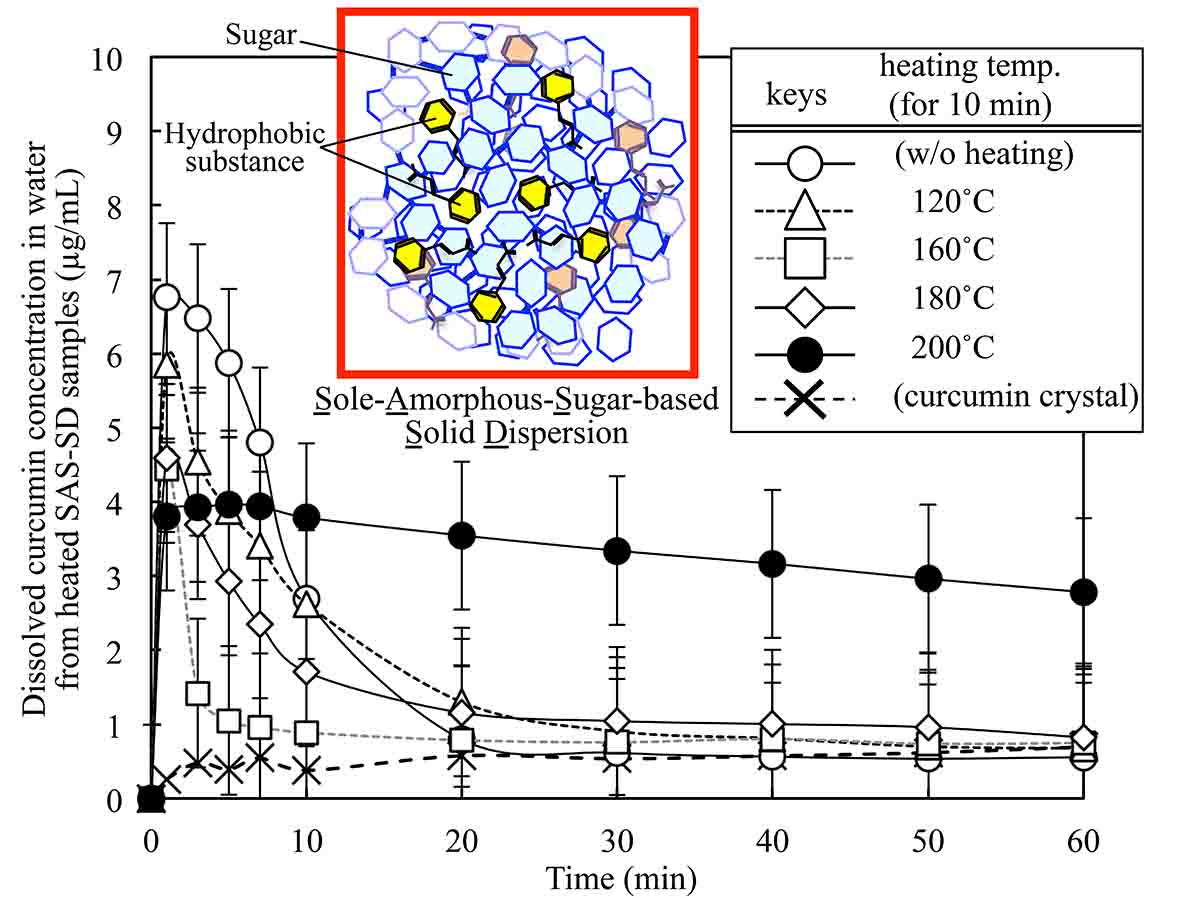
Reported phosphate binders for the treatment of hyperphosphatemia have high pill burden, cost and associated disadvantages like deposition in bones and adverse health effects. In present report, a synbiotic preparation was formulated using Lactobacillus casei JCM 1134 and deacetylated Aloe Vera (DAV) and evaluated its phosphate accumulation efficiency with the commercials. Aloe Vera powder was boiled in water bath at pH 8.0, 65 °C for 12 min. The centrifuges pellet was considered as DAV. Under optimized conditions, L. casei and DAV were mixed with additives and kept for incubation of 3h at 37 °C. Later the mixture was spray dried with supernant of DAV preparation and a synbiotic spray dried powder (SD) was obtained. Milk and coca-cola were taken as standard phosphate rich food. CaCO3, LaCO3, Al(OH) 3 and SD were studied as phosphate binders. In-vitro broth study was conducted and supernant was assayed for remaining phosphate using ascorbic acid method. Spray drying increased phosphate accumulation capability of L. casei in in-vitro broth. SD was observed as the second best after CaCO3 (accumulated phosphate 95% and 93% w/v from milk and coca cola respectively) and accumulated phosphate around 88% and 87% w/v from milk and coca cola respectively. However, LaCO3 and accumulated phosphate ~ 67% and 37% w/v while Al(OH)3 accumulated phosphate 83% and 73% w/v from milk and coca cola respectively. For safety, efficiency and cost, SD could be the best answer for preventing hyperphosphatemia. As CaCO3 is the best among tested phosphate binders, but it conferred hypercalcemia and gastrointestinal side effects etc. However, SD is composed of probiotic and Aloe vera which have GRAS status, and therefore, it is safe, affordable and comparatively effective as CaCO3.
There has been growing interest in gaining insights into the design of novel foods whose digestibility is controllable based on life stages and health conditions. Physical digestion is especially important in the case of solid foods, since their size reduction caused by breaking down can promote chemical and enzymatic digestion and release of nutrients simultaneously. Gastric digestion is the major digestion process in human gastrointestinal tract. The development of simple in vitro gastric digestion devices that enable quantitative analysis of the digestion dynamics of solid foods has been necessary. The authors and co-workers developed a human gastric digestion simulator (GDS) that simplifies the antrum geometry, is capable of simulated gastric peristalsis, and which enables direct observation of the disintegration of food particles in the gastric contents. This presentation provides a brief overview of our findings regarding the digestion dynamics of solid foods by GDS analysis. First, the concept and development of the GDS is introduced. The disintegration characteristics of solid foods using the GDS are described next, providing insights into the digestion processes influenced by gastric peristalsis. The GDS is expected to offer potential as a tool for designing novel nutraceutical and functional foods for which digestibility is well controlled.
A freeze-dryer with a radiative heating device was constructed and the inner vapor transfer property was regulated by separating the drying chamber and the condenser with an orifice. It was confirmed that the inner vapor transfer property substantially affected the acceptable operation range for avoiding product collapse, and it was revealed that this coefficient was key to quantify the drying performance of a freeze-dryer. Model foods that contained flavor components (i.e. saturated linear alcohols and ethyl esters) were freeze-dried under various operative conditions and the retention of those components were evaluated. It found that the inner vapor transfer property significantly affected the retention of the flavor components in relation to the dried cake properties. A mathematical model was used to obtain the contour diagrams of the selected parameters (e.g., product temperature and total drying period) during drying as a function of the heating condition and chamber pressure. The inner vapor transfer coefficients of the freeze-dryer were used to draw the operation lines on the diagrams. An attempt was made to depict the retention of the flavor components in combination with the contour diagrams and operation lines. It could be a rational method to predict end-product quality of a dried food based on mechanistic mathematical model.
Enzymatic hydrolysis process of polysaccharide is frequently used in food industries. Generally, small amounts of enzyme is added into the substrate solution or suspension. Efficient mixing in such system is quite difficult. Moreover, if a strong shear force is applied to enzyme, the three-dimensional structure of enzyme breaks down. This leads the deactivation of enzyme. Therefore, a reactor having the efficient and gentle mixing characteristic have been required.
In this study, Taylor-Couette flow reactor (TCFR) consists of two concentric cylinders with the inner one rotating was applied to hydrolysis process of polysaccharide. Above a critical Reynolds number (Recr) in the circumferential direction, there appear pairs of counter-rotating toroidal vortices (so called Taylor vortex flow) spaced regularly along the cylinder axis. The toroidal motion of Taylor vortex flow enhances not only heat and mass transfer but also mixing without the locally strong shear force. Furthermore, all the fluid elements leaving the annulus have the same residence time when the relatively small axial flow is added. In this study, in order to optimize enzymatic hydrolysis process of polysaccharide using TCFR, the effect of the rotational speed of inner cylinder and the axial flow rate on the yield of sugars was investigated.
The yield of sugars increased with the increase in circumferential Re, but it decreased in highly Re region where a wavy motion occurs. In wavy Taylor vortex flow region, the axial dispersion is promoted while the intra-mixing in Taylor cell is enhanced. This axial dispersion would induce the decrease in the yield of sugars. Thus, it can be concluded that TCFR should be operated in laminar Taylor vortex flow region in enzymatic hydrolysis process of polysaccharide.
The organogel is expected to be useful in various fields such as cosmetics, pharmaceutical products and food industry. However there is still few research on lecithin organogel using edible oils.
In this study, for focusing on safety to the human health, we studied on a biocompatible organogel using soybean lecithin, water and edible oil as a gelling agent , polar substance and an oil phase respectively. The range of gel formation was clarified by changing the component. Also the dynamic viscoelasticity of the gel was measured using a rotary rheometer.
The product was classified into four regions: Organogel region, Two phases region A (water + pasty solid), Two phases region B (oil + pasty solid) and No preparation region. Fig. 1(a),(b) shows the triangular phase diagram in the case of olive oil and MCT(Medium Chain Triglyceride) oil used as the oil phases. The gel formation region was different depending on the type of edible oil. This was considered to be due to the difference in the fatty acid composition of the triglycerides.
Olive oil composed mainly long-chain fatty acids having 16 or 18 carbon atoms. It showed a wide gel region at water concentrations ranging from 10 wt% to 30 wt%. MCT oil composed medium-chain fatty acid having 8 or 10 carbon atoms. It showed a wide gel region at water concentrations ranging from 40 wt% to 70 wt%. In order to confirm the influence of fatty acid composition, the organogel was prepared using triglyceride consisting of a single fatty acid composition as the oil phase. It has been found that the gel region depends on the main component of the fatty acid constituting the edible oil and the carbon chain length.
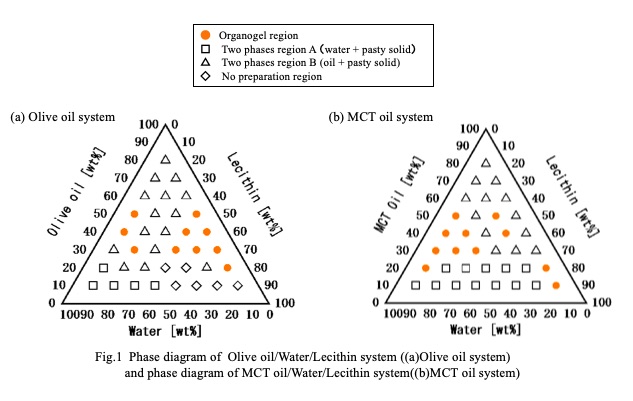
Dried persimmon is a famous and traditional product in Japan. There exist various modified or unique manufacturing procedures depending on production regions; and different treatments during the drying process will influence its final properties and consumer acceptance.
In order to know the influence of two traditional treatments on the final properties of dried persimmon, the effects of kneading and brushing on the properties of dried persimmon were investigated. In this research, four types of dried persimmons were produced by a traditional drying method, which kneading and brushing were used. A secondary surface was formed during the drying process. Moisture and sugar content, color, thickness and texture of the secondary surface were measured; Sugar crystal on the surface was observed using scanning electron microscopy (SEM);X-ray computed tomography (X-ray CT) was applied to investigate the moisture distribution of the secondary surface. Kneading had a significant (p<0.05) influence on the properties (moisture, color, thickness and texture of the secondary surface) of the product; while, the effect of brushing was not obvious. According to the sugar analysis, brushing assisted the sugar crystalize on the surface as white powder. Kneading treatment promoted the drying process and influenced the properties of dried persimmon through influence its moisture evaporation. Brushing assisted sugar crystalize on the surface by creating tiny scars on the surface of dried persimmon. This information therefore given some fundamental knowledge for making high quality dried persimmon; it is possible to help us improve the quality of dried persimmon during drying process and provide some information for the following storage strategy.
Thermal protein denaturation (TPD) is considered to be the main factor of the physicochemical changes in kuruma prawn muscle during thermal treatment. TPD in prawn muscle originates the reduction in water holding capacity and myofibrillar shrinkage, which results in appearance and texture changes. In this study, prawn samples were heated at 50, 65, 75 and 85 °C for 3, 5, 10 and 20 min. Heat transfer, and moisture loss due to cooking were evaluated. The kinetics of thermal TPD was investigated by using DSC-dynamic method. Prawns were assumed to be hygroscopic porous medium and viscoelastic material. Modeling of moisture transfer was conducted using a model based on Darcy's law combined with structural mechanics model according to viscoelastic strain-stress in a 2D-axi-symmetric model. The internal pressure of element was assumed to be directly proportional to the volume of water and inversely proportional to the volume of the element. Simulation of heat transfer and TPD was also developed. An implicit finite element method was applied using FORTRAN program. Governing and boundary equations were solved numerically using Garlekin's finite element method.
Kinetic parameters, activation energies, and pre-exponential factors, and enthalpy values for predicting TPD were obtained. Shrinkage occurred in both longitudinal and radial directions, especially at the higher heating temperature. For heating processes at 75 °C and 85 °C, actin denaturation plays the most important role in volume shrinkage; moreover, the simulated moisture transfer and volume reduction showed a good fitness with the experimental values. With the prolonged heating process, internal pressure increased firstly, then decreased and tend to equilibrium finally. The moisture distribution and simulated internal pressure distributions showed that due to the slow water release, shrinkage was delayed, and promoted incremental change in the internal pressure; then the released water acts to reduce the internal pressure, which was closely related to the actin denaturation.
Methane with a potential of 25-CO2-equivalents on global warming is the second highest compound of greenhouse gases. The current level of global methane has hit a historic high over the past 800,000 years. Therefore, to mitigate methane emission is a critical task in this generation for preventing serious climate change. Methanotrophic bacteria in the soil as one of the global methane sinks have been a potential strategy for the removal of atmospheric methane as well as environmental remediations. However, methanotrophic reactions in the conventional process consumed high energy power due to the low solubility of methane in aqueous phases. In this study, we demonstrated a novelty gas-solid reaction system under a non-aerated condition for methane degradation by methanotrophic bacteria. Associating with the simple filtration technique and a freeze-thaw treatment, Methylococcus capsulatus (Bath), a representative of gamma-proteobacterial methanotrophs, showed a significant improvement in the immobilization efficiency from 47.8% to 87.0% for loading of 9.64 μg-DCW/mm2-support onto the glass fiber membrane. Through this novel method of cell immobilization, a real gas-solid reaction with high cell loading was achieved for rapid methane degradation. Notably, the rate of methane consumption showed the 7-fold enhancement in the gas-solid system comparing to the rate in the aerated aqueous phase reaction with stirring. Moreover, the catalytic efficiency in the developed gas-solid system is 8.3-fold higher than that in the gel-entrapment system when 2.80 μg-DCW/mm2-support and 42oC-reaction temperature were employed. It indicates that water barriers still dominate the resistance of mass transfer in the gel-entrapment system and limit the affinity between catalysts and gaseous substrates, which is not suitable for a gas-solid reaction. Therefore, the result in this study can facilitate to develop an effective bioprocess of the removal of atmospheric methane with low energy consumption.
Food powders are the most common format in the packaged food sector. Typical food powders are dairy or dairy-based powders, infant formula, instant coffee, cereal based powders, instant soup powders and powdered microorganisms such as probiotics.
Amongst others, the popularity of the powdered format is driven by its increased storage and shelf-life stability due to decreased moisture content as well as by advantages for transport, storage and handling due to decreased bulk weight and volume. Desired functional properties can be tailored by applying unit operations and combinations thereof including drying, micronization, encapsulation, agglomeration and coating. An overview and selected examples of recently applied approaches will be addressed in this presentation:
— Micronization of green coffee in oil and roasting of the micronized suspension for aroma protection1
— Drying of emulsions with ultra-high oil content for structuring of liquid oils2
— Structuring of amorphous, porous sucrose containing particles to enable sugar reduction3
— Mixing and drying to produce a powdered composition of bioavailable iron and stable probiotics for food fortification4
Furthermore, an outlook at emerging powdered food ingredients and products will be provided. More specifically, the technological challenges and opportunities of novel alternative protein sources (e.g. plant, insects or microbial sources) as well as of stable probiotics for liquid products will be enlightened.
References
1. Pouzot et al., WO 2016 102335 - Coffee compositions and uses thereof, 2016
2. Sarkar et al., Microstructure and long-term stability of spray dried emulsions with ultra-high oil content, Food Hydrocolloids 52, 2015
3. De Acutis et al., WO 2017/093309 - Amorphous porous particles for reducing sugar in food, 2017
4. Berrocal et al., WO 2018/087208 - Composition in powder form comprising iron and probiotic bacteria, 2018
Wastewater containing high concentrations of oils and fats is a serious problem because it causes not only pollution problems such as eutrophication in aquatic environments but also malfunction of wastewater treatment facilities such as conventional activated sludge process, membrane bioreactor, or anaerobic digestion process. Conventionally, pressure floatation equipment has been used, while it brings industrial waste of sludge and gives off offensive odors. Microbial degradation has been studied as alternative methods. However, the oil degradation ability of microorganisms demonstrated was too low to substitute the pressure floatation equipment.
We developed a symbiotic microbial agent which consists of three types of microorganisms isolated by our group, and succeeded in dramatically accelerating the oil-degradation rate. The mechanism is as follows: A bacterium, Burkholderia arboris, secrets lipase and hydrolyzes oils and fats (triacylglycerol) into fatty acids and glycerol and degrades the fatty acids. Then, two kinds of yeasts, Yarrowia lipolytica and Candida cylindracea, degrade the fatty acids and glycerol, respectively. By using this symbiotic relationship, oils and fats can be converted into inorganic carbons or microbial cells without reverse reaction which is attributed to the accumulation of the fatty acids and glycerol. This microbial agent showed remarkable oil degrading capacity compared with other existing oil degrading microbial agents. This high oil degradation ability allows us to substitute pressure floatation equipment with our microorganism agents. By installing our products, decrease in offensive odors from sludge, reduction of industrial waste, simplifying the treatment process, and space-saving would be achieved, resulting in a cost-effective pretreatment system for oils and fats in wastewater.
3rd generation biorefinery research utilizing microalgae is ongoing in many countries because fuel/chemicals production from carbon dioxide by photogenic microorganisms is essentially sustainable. Among various photogenic microorganisms, cyanobacteria is recognized as a proper platform for chemicals production due to their high growth rate. In this study, we aimed to develop an effective continuous process producing 1.3-propanediol (1.3-PDO) by genetically engineered cyanobacteria using an airlift bioreactor system. Firstly, to achieve PDO production in cyanobacteria, a synthetic metabolic pathway consisting of five genes were introduced into the host strain (PCC7942), which produces 1.3-PDO from DHAP through glycerol. Using the cyanobacteria (TA2984), successful 1.3 PDO production (0.7 mM) associated with cell growth was confirmed and the optimal culture conditions for 1,3-PDO production were pH8.0 and 220 (μE/m2/s). Based on this result, we examined the possibility of continuous process using TA2984. As a bioreactor for continuous process, an airlift fermenter with an internal draft tube was used because it achieves homogeneous distribution in a reactor with low hydrodynamic shear. Using the air-lift bioreactor system, The continuous 1,3-PDO production was performed for 40 days. However, its operation sometimes becomes unstable due to the increase of culture pH at high cell concentration. Therefore, we then introduced pH-stat system by CO2 supply. Using the pH-stat system, continuous 1,3-PDO production was achieved using air-lift bioreactor for 60 days and the highest 1,3-PDO productivity was increased to 0.227 (mM/day) at the dilution rate of 0.178 (day-1). Furthermore, it was found that glycerol addition to medium was effective to improve 1,3-PDO production. Based on these results, enhanced continuous production of 1,3-PDO using air-lift bioreactor with the productivity of 0.367(mM/day) was successfully performed for more than 60 days.
Methane has attracted attention in recent years not only as a clean alternative fuel for transportation vehicle but also as a chemical feedstock because it exists abundantly as the main component of natural gas, shale gas, and biogas. However, methane exists as a gaseous state at ordinary temperatures and pressures, making it expensive to store and transport from remote places where it is generated to places where it will be consumed. Therefore, efficient methodologies for converting methane to liquid fuels and/or valuable chemicals are required.
Methanotrophic bacteria have been considered to be a suitable host strain for the biological methane conversion because they are capable of utilizing methane as sole energy and carbon source. However, there are several obstacles in the use of methanotrophic bacteria for the biological methane conversion; for example, (1) slow growth rate, (2) slow mass transport of methane, (3) maintenance of intracellular redox balance, and (4) limitation of genetic manipulation tools. In this talk, we would like to introduce our achievements regarding (3) and (4). Methylococcus capsulatus (Bath) was used as a model methanotrophic bacterium. To maintenance of intracellular redox balance, the method for real-time monitoring of intracellular NADH:NAD+ ratio was established using a genetically encoded NADH sensor protein and electrochemical method (Bioresour. Techonol., 241, 2017, 1157-61). For a gene replacement, efficient counterselection method was proposed using a mutated pheS gene as a marker (Appl. Environ. Microbiol., 84, 2018, e01875-18). We anticipate that these our achievements will be utilized widely by the methanotroph research community, leading to improved productivity of methane-based bioproduction and new insights into methanotrophy.
Cellulosic biomass consisting of plant matter is the most abundant carbon-neutral renewable resource on the planet. Researchers from interdisciplinary fields have focused on biorefinery utilizing (ligno)cellulosic biomass for the production of bioenergy and biochemicals in recent years. To achieve the efficient utilization of cellulosic biomass as feedstock, the pretreatment step is one of critical issues to be solved (1, 2). To explore an alternative way to produce value-added biochemicals from biomass, we have focused on the potential of insect biorefinery in which a unique silkworm-baculovirus protein expression system is exploited in collaboration with Faculty of Agriculture in Kyushu University (3, 4). Herein, our efforts on combining the unique protein expression system and the enzymatic protein manipulation will be presented toward the sustainable production of functional proteins with mulberry leaves as a sustainable plant resource.
References
1) N. Kamiya, H. Takahashi et al., Biotechnol. Lett., 30, 1037-1040 (2008)
2) Uju, T. Oshima, M. Goto, N. Kamiya et al., Bioresour. Technol., 138, 87-94 (2013)
3) Patmawati, K. Minamihata, N. Kamiya et al., Biotechnol. J., 13, 1700624 (2018)
4) Patmawati, K. Minamihata, N. Kamiya et al., J. Biotechnol., 297, 28-31 (2019)
Development of rapid and powerful mutagenesis and high throughput adaptive evolution tools is of importance for creation of hyper cell factories by discovery of novel functional genes or biological dark matters and genome-phenotype association using integration of different approaches. ARTP (atmospheric and room temperature plasma) mutagenesis system developed by our group can directly cause complex genome mutation including chain break and bases mutation via a unique mechanism. Mechanistic study and various practical applications in cell breeding demonstrated that ARTP mutagenesis is apowerfultool. For developing an integrated platform capable of combing ARTP mutagenesis and high throughput adaptive evolution, we further developed a microdroplet-based microbial culture (MMC) system which can be operated automatically with high throughput culture on microchips, good repeatability, online detection of growth states, reprogrammable software, automatic addition of gradient chemical factors. The ARTP mutagenesis together with MMC system is an enabling platform for smart integrative biobreeding by further combining with genome editing technology, which can greatly contribute to green biomanufacturing.
This work is supported by National Key Scientific Instrument and Equipment Project of NSFC (2162780028), the Tsinghua University Initiative Scientific Research Program (20161080108) and the JST CREST Project of Japan.
Glucose and xylose, which are the main components obtained by hydrolyzing biomass such as waste of agricultural products and plants, could be used in ethanol fermentation. However, the uptake kinetics of each the sugar may drastically change when glucose/xylose mixture is given to yeast as a carbon source for the ethanol fermentation. The objective of this study is to apply the developed quantification method to the determination of metabolites contents in ethanol fermentation media based on infrared spectroscopic information.
Fermentation was conducted using Pichia stipitis NBRC 10063 (NITE Biological Resource Center, Chiba) with glucose, xylose or glucose/xylose mixture as the carbon sources for 120-168 hours in yeast nitrogen based (YMB) medium. The infrared spectra of fermentation samples were collected using a Fourier transform infrared (FT-IR) spectrometer equipped with an attenuated total reflectance (ATR) accessory in the ranging from 4000 to 400 cm-1.
For the spectra of glucose and xylose in the YMB medium that represented the very similar spectral features, we extracted 14 absorption bands assigned to C-C, C-O, C-H and C-OH of the sugars and ethanol in order to characterize the spectra. Under the assumption that the spectral additivities could be satisfied, we tried to choose the best combination for the metabolite content determination in the fermentation media. Consequently, the wavenumber combination of 1036, 1050 and 1046 cm-1 was selected for the quantification, and the calculated contents of sugar and ethanol components excellently agreed with the contents measured using an HPLC method. In addition, the kinetic sugar uptake and ethanol production behaviors were accurately grasped during fermentation using glucose, xylose or glucose/xylose mixture medium based on the information estimated using the developed quantification method. These results suggested that the mid-infrared spectroscopic method would be acceptable as the simple, rapid, non-chemical and non-destructive monitoring of such fermentation processes.
Sugar fatty acid ester is one of bio-based and non-toxic surfactants. Its hydrophilic–lipophilic property can be controlled by the type of fatty acid side chain. Recently, medium-chain triglyceride (MCT), which has medium chain fatty acids (length of 6-12 carbons), has received much attention because of its preventive effect on lifestyle-related diseases. In order to use MCT in foods, its solubilization or micellization is important and hence sugar ester consisting of similar medium-chain fatty acid is required. However, such a sugar ester is not available. This is because in the industrial production method using homogeneous catalyst such as Na2CO3, reduced pressure condition is necessary to improve the product yield, but the reactant with medium-chain fatty acid also evaporates and hardly reacts under the condition.
We reported the ion-exchange resin pre-adsorbed with the reactant sugar shows a high catalytic activity for sugar ester synthesis at 60 °C and atmospheric pressure1). This method has a possibility of producing sugar ester with medium-chain fatty acid which could not be synthesized conventionally. In this research, syntheses of sucrose ester with caprylic acid (carbon number: double bond number = 8:0) were discussed using microporous anion-exchange resin catalyst. In the synthesis experiments, first, sucrose was adsorbed on the resin and then methyl caprylate was added to initialize the reaction. For comparison, an experiment to produce the conventional sugar ester with long-chain fatty acid was also performed using methyl oleate (18:1). As shown in the attached figure, in the case using the resin, the conventional long-chain ester formed more rapidly than the case using the homogeneous catalyst (Na2CO3) at atmospheric pressure. The novel medium-chain ester was also formed similar to the conventional long-chain ester. Therefore, this method using the heterogeneous resin catalyst has potential to efficiently and continuously produce sugar ester with medium-chain fatty acid.
1) T. Sasayama et al., Chem. Eng. J., 334, 2231 (2018)
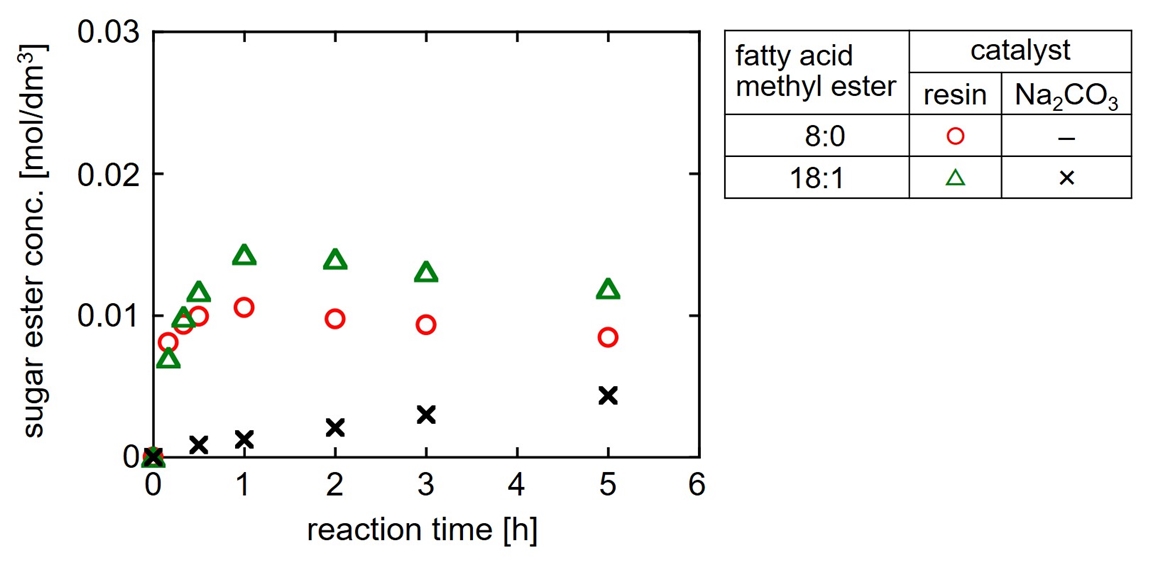
Synthetic biology aims to create a production system by synthetic or genetically engineered microbes. It is important to rationally design a genetic edition strategy in computer before expensive and time-consuming biological experiments. Flux balance analysis, a linear programming-based framework, have been widely used to predict the metabolic fluxes of cellular organisms in different culture conditions. Mass action models have recently been proposed to simulate large-scale cellular metabolism. However, both the models work just on the steady state; dynamic models are required to predict the cellular metabolism because synthetic microbes are often grown in a batch culture. In 2016, to simulate the dynamics of cellular metabolism, we constructed detailed kinetic models of E. coli central carbon metabolism to predict the dynamics of genetically engineered cells under aerobic condition. This model employed several major transcription factors of Cra, Crp PdhR, and IclR to consider gene expression regulation at different genetic mutants, and used detailed enzyme kinetics to take into account enzyme modification and allosteric bindings. On the other hand, useful compounds such as fermentation products are produced in anaerobic and microaerobic conditions, while cell growth are optimal under aerobic condition. Rational fermentation design of genetic microbes requests considering the mechanisms by which how dissolved oxygen affect fermentation and cell growth. Thus, we have proposed a kinetic model that predicts the dynamics of E. coli central carbon metabolism at different dissolved oxygen concentrations by considering transcription factors of ArcA/B and Fnr, respiratory chain reactions and fermentative pathways, and catabolite regulation. The model accurately predicted the metabolic characteristics and molecular mechanisms of fnr and arcA gene-knockout mutants. We used the model to design an aerobic-microaerobic dual-phase cultivation method in a pfl-knockout mutant to maximize lactate production. The model will be a platform for designing microbial cell factories to produce a variety of biochemicals.

Integration of in silico and experimental approaches is highly desired for understanding of photosynthetic organisms and creation of green microbial cell factories. We previosuly developed Genome Scale Model (GSM) of cyanobacterium Synechocystis sp. PCC6803 [Yoshikawa et al., 2011]. The developed GSM is applied to prediction of metabolic fluxes under diferent trophic conditions and to design of genetic modification for valuable compounds production. Ethanol production improvement by Synechocystis sp. PCC6803 strain [Yoshikawa et al., 2018] was designed and it was experimentally proved. Recently GSM was reconstructed with detail information of photosynthesis and understanding of electron transfer in photosynthesis system.
Metabolic flux analysis (MFA) based on quantification of 13C-labeling patterns of metabolites by mass spectroscopy (MS) is a powerful tool to quantify fluxes experimentally in a metabolic network of microorganisms. Cells are cultivated with a 13C-labeled substrate, and metabolites are extracted from the cells for use in MS analyses. Metabolic fluxes are determined using stoichiometric constraints coupled with extracellular measurements and 13C-labeling patterns of the metabolites. We developed a bioinformatics tool, OpenMebius, to determine metabolic flux from the 13C-enrichment data of isotopically labeling experiments [Kajihata et al., 2014]. Metabolic fluxes of different cultivation condition of Synechocystis sp. PCC6803 was performed and it provides new understanding of central carbon metabolism of photosynthetic organisms. Combination of the these in silico and experimental flux analysis provides us good strategies for modification of metabolic pathways to create useful cell factories of photosynthetic organisms.
Anaerobic co-digestion using biomass as a raw material has not only the advantage of energy recovery but is also a technology to reduce the environmental burden by resource circulation, prevention of global warming and creation of a recycling society.
Unutilized biomass has an important role in effective utilization of biomass. Now, there is great interest in the reuse of corn stover for renewable energy production from both output and environmental point of view. However more than half of the corn stover components are hardly decomposable organic matter. In this study, we aimed to elucidate the effect of heating as a pretreatment on biogas production of anaerobic co-digestion using corn stover from the view of a change in the physical characteristics of the raw material.
The specific heating conditions of corn stover and experimental flow are shown in the Fig1. For the raw materials, corn stover was pulverized to about 10 mm in size with a pulverizer and food waste was crushed with a food processor. About the heating pretreatment, 3 levels of samples were set and each was used as the 1st, 2nd, 3rd-week samples. The organic loading amount was set to 1.5 g-VS / L-digester / day, C / N ratio was set to 40.then the raw materials input amount was calculated. Into a 235 L volume reactor, the raw materials were charged and heated to about 53 °C.
In this study, the bulk density and open porosity of utilized corn stover were measured to explore the effectiveness of the pretreatment. The result shows that the 3rd week sample had the highest biogas production. Furthermore, the bulk density of the corn stover total solids directly affects the biogas production rate, a sample with a higher bulk density of corn stover total solids shows the lower biogas production rate.
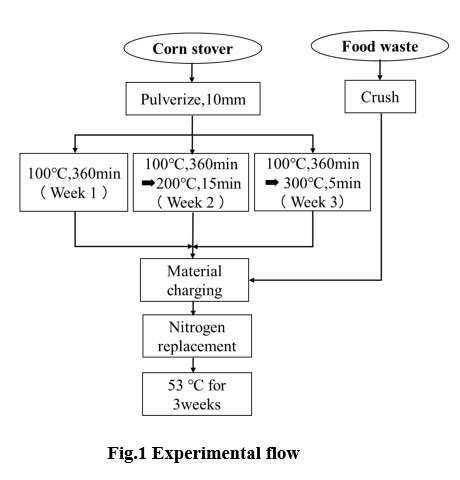
Microalgae are an attractive and green resource with large-scale production capacity for lipid. After harvesting, microalgae always have water contents > 80 wt%. Through the traditional extraction methods, microalgae must be dried before the subsequent extraction and heated to remove the extractants after the extraction, resulting in a great increase in energy consumption; the extraction temperature is generally > 100 oC with long extraction time. Therefore, it demands an energy-saving and efficient extraction solvent.
Dimethyl ether (DME) is the simplest ether and colorless fuel gas at ambient temperature and pressure. As a commercial product, DME comes from a variety of feedstock such as fossil fuels and waste products. DME is environmentally friendly, efficient, and energy-saving as an extraction solvent. DME is partially soluble in water, rendering that drying is unnecessary for wet feedstock. The high solubility of lipid in DME ensures high efficiency. Due to a low boiling point at -24.8 oC and sufficiently high vapor pressure at room temperature, the gaseous DME after the extraction process can be removed completely and easily without heating.
Here, we conducted the DME extraction of various microalgae and firstly reported the latest development of pilot-scale DME extraction prototype for lipid extraction of wet microalgae. The wet microalgae samples with moisture contents higher than 90% grew using the wastewater at a wastewater treatment plant in South Africa. The harvesting and extraction machines also located at this plant. After harvesting, the extraction reaction of microalgae proceeded continuously at ambient temperature. Both lipid and water were extracted together and separated easily after the extraction. The yield, elemental composition, heating value, and molecular weight distribution of lipid extracted by liquefied DME were studied. The energy balance was calculated, indicating the extraction using liquefied DME as the solvent can decrease energy consumption greatly in pilot scale.
Oxygen supply is a crucial parameter in biotechnological production. While oxygen transfer has been well studied for viscous cultivations in stirred tanks, little is known about the oxygen transfer in shake flask cultures with elevated viscosity media. In our previous study, it was experimentally shown that the maximum oxygen transfer capacity OTRmax in shake flasks increased with increasing viscosities up to 10 mPa s. It was further demonstrated that the increased thickness of the liquid film at the shake flask wall inherently promotes the oxygen supply to the medium at moderately elevated viscosities1). Although the shaking diameter is an important parameter to determine the oxygen transfer in shake flask culture, is not well discussed in the past.
In this study, OTRmax was investigated using a biological model system. Corynebacterium glutamicum DM1730 was studied in culture medium with different shaking diameter (25, 50, 70 mm) at elevated viscosity (1-27 mPa s), using polyvinylpyrrolidone as viscosifying agent. The oxygen transfer was monitored using a respiration activity monitoring system (RAMOS)2) with 20 mL medium in 250 mL flask. As a result, the OTRmax significantly increased by changing shaking diameter from 25 to 50 mm under each viscosity condition. It was hypothesized that with the increase of shaking diameter, a larger part of the shake flask wall became available for the liquid film and the bulk liquid was more pressed into one corner of the flask. Meanwhile, no further increase of OTRmax was observed by changing the shaking diameter from 50 to 70 mm. It was suggested that the volume of liquid film already reached the maximum at 50 mm shaking diameter under the examined condition.
1) Giese et al., Biotechnol. Bioeng., 111, 295-308 (2013)
2) Anderlei et al., Biochem. Eng. J., 17(3), 187-194 (2004)
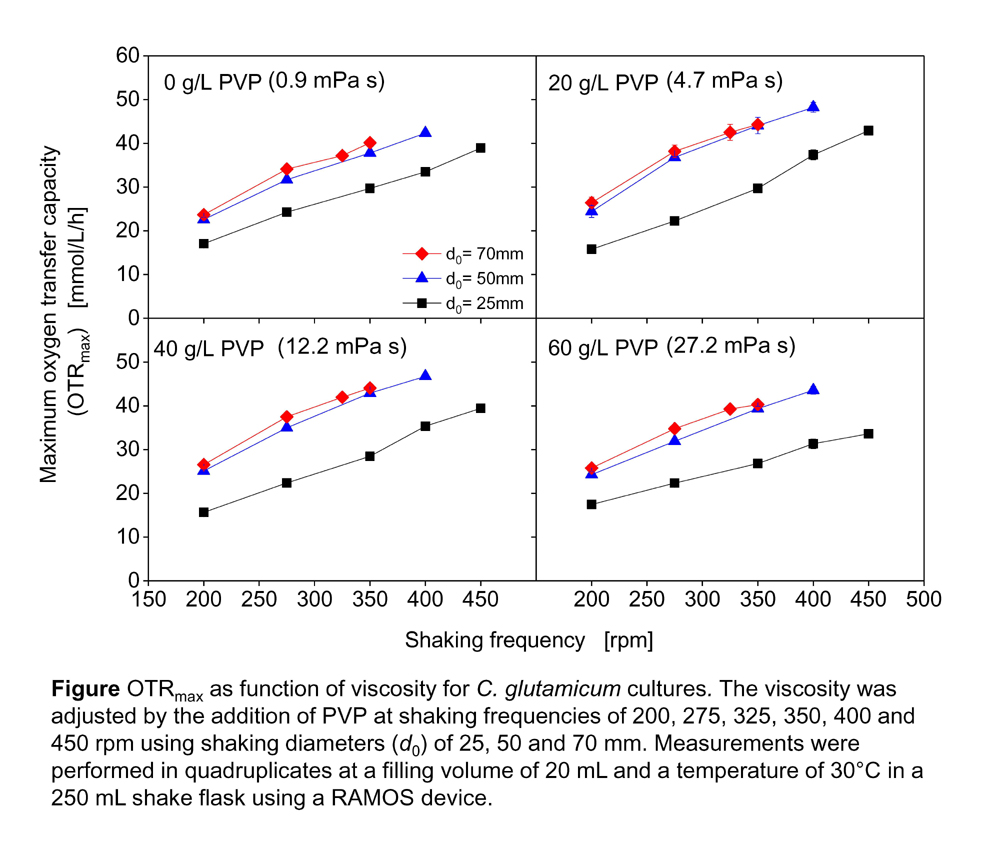
Natural media are often used for various commercial bioprocesses by manufacturers to cut raw material cost. However, the components of the raw materials varies between lot-to-lots and brand-to-brands. The varieties of raw materials influence to the cell growths and materials productivities, and results in unstable production across batches in manufacturing processes. To ensure the quality of raw materials among batches, it is necessary to perform a laboratory screening to purchasing the optimal one, and ensure a desirable performance in industrial process. To solve the serious problems in bioprocesses, it is developing that a modeling methodology using composition of raw materials, named us “substratome”(1), obtained by non-targeted metabolomics-like methods can estimate the cell growth and bio-productions. Here, we will present that two model studies: [1] Escherichia coli growths have been estimated from hydrophilic components in yeast extract obtained by gas chromatography-mass spectrometry (GC-MS)(1), and [2] bioethanol production have been estimated by the volatile components in corncob and corn stover hydrolysates obtained by GC-MS; by partial least square regression (PLS-R)(2). Additionally, we will present preliminary results to solve the same issues by using artificial intelligence.
References
1) Tachibana S, Watanabe K, Konishi M. (2019) J. Biosci. Bioeng. (in press)
2) Watanabe K, Tachibana S, Konishi M. (2019) Bioresouc. Technol. 281: 260-268
Cancer is a complex disease that relies on both oncogenic mutations and non-mutated genes for survival, thereafter coined as oncogene and non-oncogene addictions. The need for more effective combination therapies to overcome drug resistance in oncology has been increasingly recognized, but the identification of potentially synergistic drugs at scale remains challenging. Here we propose a gene-expression-based approach, which uses the recurrent perturbation–transcript regulatory relationships inferred from a large compendium of chemical and genetic perturbation experiments across multiple cell lines, to engender a testable hypothesis for combination therapies. These transcript-level recurrences were distinct from known compound–protein target counterparts, reproducible in external datasets, and correlated with small-molecule sensitivity. We applied these recurrent relationships to predict synergistic drug pairs for cancer, and experimentally confirmed the synergistic effects of one combination of a retinoid and an mTOR inhibitor and the other combination of a protein synthesis inhibitor and a CDK inhibitor in two breast and two lung cancer cell lines. Our results corroborate a gene-expression-based strategy for combinatorial drug screening as a way to target non-mutated genes in complex diseases.
Recombinant proteins expressed in E. coli are frequently misfolded into insoluble aggregates called inclusion bodies, which require a complicated downstream process for purification including a refolding step. Therefore, the increase of solubility of expressed proteins has been a critical issue in recombinant protein production using E. coli. It is known that the solubility is increased by lowering the protein synthesis rate under proper DO environment. In this study, we developed a DO-stat fed-batch culture system, which allows to maintain DO in a fermenter constant by glucose feeding. Using the DO-stat fed-batch system, anti-CRP scFv production by E. coli employing the pET expression system was investigated. By employing a PID control to determine glucose feeding rate, DO in a fermenter was successfully maintained. The results of the fed-batch operation at DO=40% showed the solubility of anti-CRP scFv improved from 23-29% by flask and batch cultures to approximately 100%. The anti-CRP scFv production also increased from 0.14 g/L by a batch culture to 2.6 g/L. DO in a fermenter significantly influenced on the solubility and production of scFv and the optimal DO level was found to be between 40-60% for successful scFv production. It was also found that the increased addition of yeast extract was effective to increase anti-CRP scFv production by avoiding the proteolytic degradation of scFv that sometimes happened in the mid or later phase of fed-batch cultivation. Thus, it was found that the DO-stat fed-batch culture system greatly improves the solubility and production of anti-CRP scFv using E. coli.
The characterization of polyphenol oxidase (PPO) taken from the seed kernel of the Philippine mango (Mangifera indica var. Philippines) was studied. PPO was obtained by extraction followed by partial purification through ammonium sulphate precipitation. The partially purified PPO has an optimum pH of 7.0 and an optimum temperature of 30 °C using catechol as substrate. The PPO showed maximum activity when catechol was used as the substrate, followed by other diphenol substrates 4-methylcatechol, L-DOPA, and hydroquinone. Meanwhile, no enzyme activity was detected from two monophenol substrates p-cresol and tyrosine. In the determination of kinetic parameters using catechol as substrate, the Michaelis-Menten constant (Km) was found to be 2.50 mmol/L while the maximum reaction velocity was 0.12 U/min.
The cellular signals such as proliferation were regulated by lipid modification of proteins that are activated on a membrane-anchored state. Thus, the artificial lipid-modification of proteins is key technique in biomimetics although biocompatible modification has been challenging due to hydrophobicity of lipid derivatives. Herein, we introduce in situ decoration strategy of membrane with a protein and a synthetic amphiphilic lipid using microbial transglutaminase (MTG). MTG catalyzes the cross-linking reaction between a specific glutamine (Q) in a protein and lysine (K) in the lipid-fused peptide. In our previous report, synthesized lipid-G3S-MRHKGS lipids fully were fully recognized by MTG, yielding > 90% conversion of a protein fused with LLQG (Q-tagged protein) into a lipidated form in the presence of MTG1,2. Especially, cholesterol (Chol) containing peptide (Chol-G3S-MRHKGS) renders the conjugated protein stable anchoring ability on the cell-surface. Therefore, we applied Chol-G3S-MRHKGS for in situ cell-surface decoration with the protein: simply mixing cells to a mixture of cholesterol-G3S-MRHKGS, Q-tagged proteins and MTG. The protein decoration efficacy depended on the concentration of the subjected peptide, however, high concentration caused the cytotoxicity toward the cells, indicating the trade-off relationship between decoration efficacy and biocompatibility.
1 M. Takahara et al., ACS Appl. Bio Mater., 1, 1823-1829 (2018).
2 M. Takahara et al., Chem. Eur. J., accepted (2019).
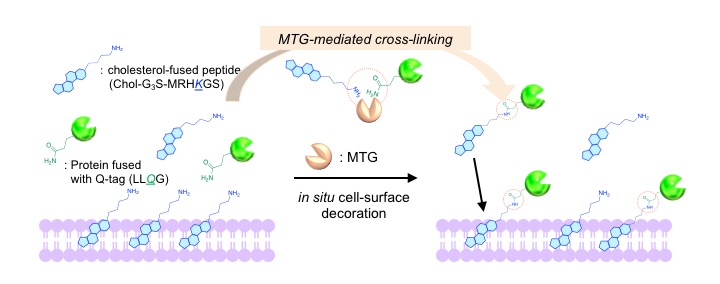
[Introduction]
Blood-brain barrier (BBB) hamper the delivery of drug carriers into brain. Widening BBB tight junctions via focused ultrasound (FUS) can be a promising approach for enhanced nanoparticle delivery into brain. However, there is currently a poor understanding of how nanoparticles pass the opened BBB gaps. In this study, FUS-assisted BBB permeation of gold nanoparticles (AuNPs) with different size are examined in vitro and in vivo for elucidating the optimum design of nanoparticles for brain drug delivery.
[Materials and Methods]
3, 15, and 120 nm AuNPs were applied to bEnd3 cells cultured on Transwell® culture insert in vitro and ICR mice via i.v. injection in vivo under existence of Sonazoid® microbubbles, followed by FUS irradiation. TEER was measured to evaluate the barrier function of the in vitro BBB model. The amount of permeated AuNPs was measured using ICP-MS.
[Results and Discussion]
TEER measurement indicated that gaps are transiently opened for 4 h in the in vitro BBB model by FUS. The amount of permeated AuNPs in vitro was significantly increased by FUS for 3 and 15 nm NPs, while no significant difference was observed for 120 nm NPs. The permeated amount increased with decreasing NP size. FUS irradiation also significantly increased the NP delivery efficiency to brain in vivo; in the case of 0.7 MPa FUS, the efficiency increased by ca. 3-10 times. It was found that smaller particles are not necessarily better, and 15 nm NPs showed the highest efficiency. We consider that this optimum size is determined by the competition between permeation through disrupted BBB gaps and blood half-life. While smaller particles are better for the permeation through narrow gaps, they are rapidly excreted from blood by renal clearance. This hypothesis was supported by our kinetic model calculation considering NP size-dependent permeation and clearance.
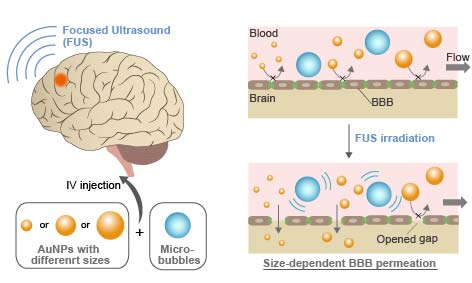
Regenerative medicine using induced pluripotent stem (iPS) cells has recently attracted significant attention. To realize the therapeutic potential of iPS cells, a mass cultivation system in the undifferentiated state and efficient differentiation protocol must be established. In this study, we developed a three-dimensional method for culturing human iPS cells using hollow fibers. The cells immobilized inside the hollow fibers can proliferate and form multicellular aggregates, capable of achieving a high cell density.
We first cultured human iPS cells for under conditions that maintained their undifferentiated state. The cells proliferated and formed cylindrical multicellular aggregates that grew in the longitudinal direction of the hollow fibers. The cells maintained the proliferative activity of 7-fold expansion for 4 days in at least three serial passaging. The cells well maintained the specific pluripotent marker of SSEA-4 during passaging.
We then cultured human iPS cells for 7 days under conditions that maintained their undifferentiated state and then switched the culture conditions to allow spontaneous cell differentiation. In the 7-day undifferentiated culture, a high cell density of approximately 10-fold that of the initial seeding density was achieved. The upregulation of gene expression of three germ layers was observed in the culture of differentiated cells. Expression of the lineage-specific cell-surface marker CXCR4 (a definitive endoderm marker) was about 30% at day 5 in the differentiation culture, which was 2-fold higher than that in the traditional monolayer culture. After hollow fiber culture, we isolated the CXCR4-positive cell population using the magnetic-activated cell sorting (MACS) separator system. We were successful in obtaining a population that had potential to differentiate into a specific lineage using the efficient hollow fiber culture method.
In conclusion, the hollow fiber culture method has potential for the large-scale preparation and differentiation of human iPS cells.
The fabrication of functional tissues has emerged as a promising technology for clinical applications, such as disease treatment and drug discovery, as an in vitro tissue/organ models. It has been revealed that the mechanical environment of tissues, determined by geometric cell patterns or material composition, play a key role in developing proper tissue function. Herein, we describe the feasibility of inkjet bioprinting with multi-ink for fabricating disk and filament-shaped tissues by patterning the cells onto substrates. Inkjet bioprinting, which is based on drop-on-demand non-contact deposition of liquids, allows the fabrication of tailor-made patterns using biocompatible materials with a simple and low-cost process. To achieve rapid hydrogelation, horseradish peroxidase (HRP)-catalyzed cross-linking was applied. HRP is a catalyst for phenol conjugation by consuming hydrogen peroxide (H2O2). A key advantage of utilizing this method includes the versatility of material choice to design various patterns. In this work, alginate (Alg-Ph), gelatin (Gela-Ph) and hyaluronic acid (HA-Ph) derivatives possessing phenolic hydroxyl groups were used. Bioink containing Gela-Ph, HA-Ph, and HRP was ejected through an inkjet nozzle head with 60 μm in orifice diameter onto Alg-Ph hydrogel sheet to form dot and line patterns that promote cell adhesion (Figure a). If the width of the gap between the dots and lines is required, a simple design modification can be done quickly with software without additional steps. Then, HEK293T/eGFP and 3Y1 cells were seeded onto the hydrogel sheets. After the optimal times of cultivation, disk and filament-shaped tissues were obtained by degrading Alginate-Ph hydrogel by adding alginate-lyase in medium (Figure b and c). We hope that this approach is promising for fabricating tissues and tailor-made cell patterning and will generate further interest in the field of tissue engineering.
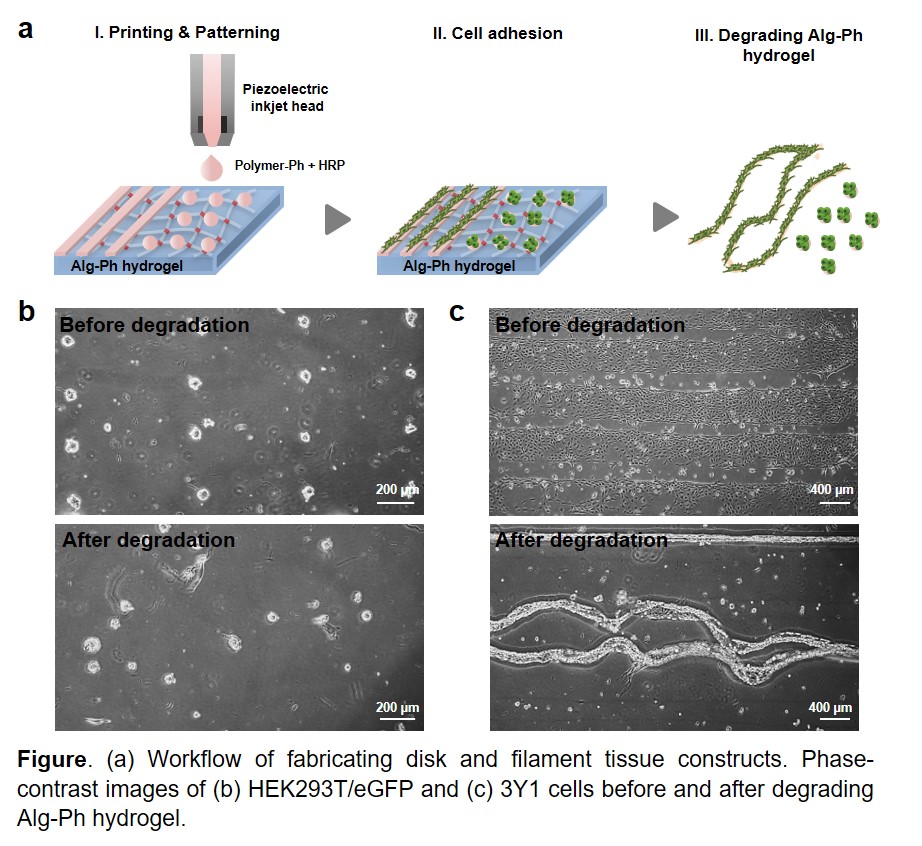
Bioprinting attracts increasing attention as an effective approach for fabricating cell-laden 3D constructs. 3D printing enables us to create physical objects from digital designs and printing precursors. The advantage of 3D printing is that it makes easy to prepare 3D constructs with different morphology, simply by modifying the digital design on computer. The aim of this study is the development of bioinks containing nanofibrillated chitosan (NC) for extrusion 3D bioprinting. Extrusion 3D printing is the most widely used printing system for developing 3D constructs. Chitosan is a well-studied polysaccharide in the field of biomaterial for medical and pharmaceutical applications because of the biodegradability, biocompatibility, and bioactivities. We evaluated the feasibility of NC as a component of bioinks for an enhancement of the shear-thinning property of the solution gellable through horseradish peroxidase (HRP)-catalyzed crosslinking of polymers possessing phenolic hydroxyl (Ph) moieties. Shear-thinning property is known to be an important property for fabricating constructs with the shape as designed in extrusion 3D bioprinting.
NC was mixed at 1 w/w% in the solutions of gelatin and hyaluronic acid derivatives possessing Ph moieties (Gelatin-Ph and HA-Ph). The addition of NC increased the viscosity at a lower shear rate but the value decreased drastically with increasing shear rate. In addition, the 3D construct obtained by extruding the ink containing NC, HA-Ph, gelatin-Ph, and HRP onto the substrate in air containing 16 ppm hydrogen peroxide was more consistent with the blueprint than that obtained from the ink free from NC. The fibroblast cells enclosed in the 3D constructs showed around 90% viability and spread in the constructs. These results demonstrate the feasibility of nanofibrillated chitosan as a component of bioinks in extrusion 3D bioprinting.
Fabrication of in vitro functional tissues which can accurately model disease condition are required for efficient drug development. Although there are a lot of neuromusclular diseases, very few drugs for them have been developed so far. In the present study, we aimed to develop in vitro functional innervated skeletal muscle tissues which can potentially model disease conditions. Previously, we developed in vitro skeletal muscle atrophy models [1] and in vitro 2D co-culture system of skeletal muscle cells and motor neurons [2]. By utilizing these systems, we developed the microdevice for 3D co-culture of skeletal muscle cells and motor neurons. The microdevices consist of two chambers; one is for skeletal muscle tissues and the other is for motor neurons. The chambers are connected each other by microtunnels which are small enough only the axons of motor neurons not cell bodies can pass through. We used the microdevices, made human skeletal muscle tissues using fibrin-based gel, and co-cultured human iPS-derived motor neurons. Glutamate selectively activate motor neurons. The constructed co-cultured tissues were actually contracted by the addition of glutamate into the chamber for motor neurons. In addition, the contraction was inhibited by the addition of tetrodotoxin which can suppress the firing of action potentials in neurons. The formation of neuromusclular junctions (NMJ) were observed by the immunofluorescence staining. These results indicated that the skeletal muscle tissues on the device were functionally connected with the motor neurons via NMJ as similar to the human body. Thus, our microdevice would be a powerful tool as an in vitro assay system for neuromusclular disease related drug development.
References:
[1] Shimizu, K., Genma, R., Goto, Y., Nagasaka, S., Honda, H., Bioengineering (Basel), 4(2):56 (2017)
[2] Yamaoka, N., Shimizu, K., Imaizumi, Y., Ito, T., Okada, Y., Honda, H., BioChip Journal, in press.
Spatiotemporal regulation of cell-material interactions has attracted a great deal of attention. Fine arrangements of cells are necessary in the field of cell engineering for applications such as regenerative therapies with artificial tissues and organ-on-a-chip techniques for drug evaluation. In addition, spatiotemporal manipulation at a single-cell level allows cells to be sorted based on their characteristics in image cytometry. Although, numerous methods have been developed for the spatio-temporal control of cell immobilization, most of these depend on cellular adhesivity for cell attachment. Thus, these methods required hours of incubation to immobilize cells and cannot be applied to cells with no adhesiveness. Rapid control of cells is essential for current “omics” analyses requiring high-throughput approaches. Non-adherent cells have also attracts growing attention in cancer immunotherapy, and detection of circulating tumor cells have significant benefits in the medical field.
Therefore, we have developed photo-cleavable materials for the quick immobilization of both non-adhesive and adherent cells, based on a poly(ethylene glycol) (PEG)-lipid conjugate (PEG-lipid) [1] and applied them to unique single-cell analysis [2,3]. Contrary to most conventional approaches that control the adsorption of serum proteins, our materials regulate the characteristics that directly binds to the cell membrane. Recently, we developed photo-switchable surfaces for the reversible immobilization of non-adhesive cells [4]. Spiropyran, a molecule that photo-isomerizes leading to a substantial difference in water solubility, was attached to PEG-lipid conjugates. This photo-switchable material enabled rapid and spatially selective in situ control of both the attachment and detachment of cells in a light-induced manner. In this presentation, this new material is mainly introduced with other recent our progresses in material-based cell manipulation technologies.
References: [1] Angew. Chem. Int. Ed., 51, 128-131 (2012); [2] Lab Chip, 31, 1933-1938 (2017); [3] Sci. Rep., 7, 14962 (2017); [4] ACS Appl. Bio Mater., 2, 33–38 (2019).
INTRODUCTION:
Surface modification can enhance regenerative performance of medical implants. Our group have been exploring short peptides with cell-selective adhesion/growth [1,2]. These peptides are screened from combinatorial peptide library by evaluating the dual effect on different types of cells, which enhances the adhesion/growth of cells that enhance the regeneration and inhibits the cells with negative affect on implanted area. For the application of these peptides, we have been investigating bio-compatible scaffold material for medical applications. In this work, we have developed a hybrid material of polysaccharide and collagen processed by vitrification method [3]. We here report the optimization of polysaccharide-collagen hybrid material and its peptide-modified effect for evaluating its medical usage performance.
METHODS:
Ten different types of material conditions were designed to examine the combination effect with the polysaccharide and collagen hybrid film. Their mechanical properties and cell-selective adhesion performance was investigated with endothelial cells, fibroblasts, and smooth muscle cells, which mainly consists of blood vessel and to be controlled in the regeneration of vascular tissue.
RESULTS:
We found optimized condition of polysaccharide and collagen combanied material made by vitrification. As a result, we found that our cell-selective peptides can provide cell-selective enhancement of endothelialization on newly designed polysaccharide and collagen hybrid material. The mechanical property measurement indicated that these functionalized hybrid film can show sufficient mechanical strength, and can be optimized easily by layer-forming method. Therefore, our new hybrid material can be a new candidate material to design medical implants such as sheets or vessels which can exceed the implantation of non-functionalized bare polymer material.
DISCUSSION & CONCLUSIONS: Our hybrid material combined with cell-selective material can serve as new regeneration enhancing material in medical usages.
REFERENCES
[1] Kanie et al., Materials. 2016; 9(9) 730.
[2] Kanie et al., Biotechnol Bioeng. 2012; 109:1808-16.
[3] Takezawa T, Cell Transplant. 2004;13:463-73.
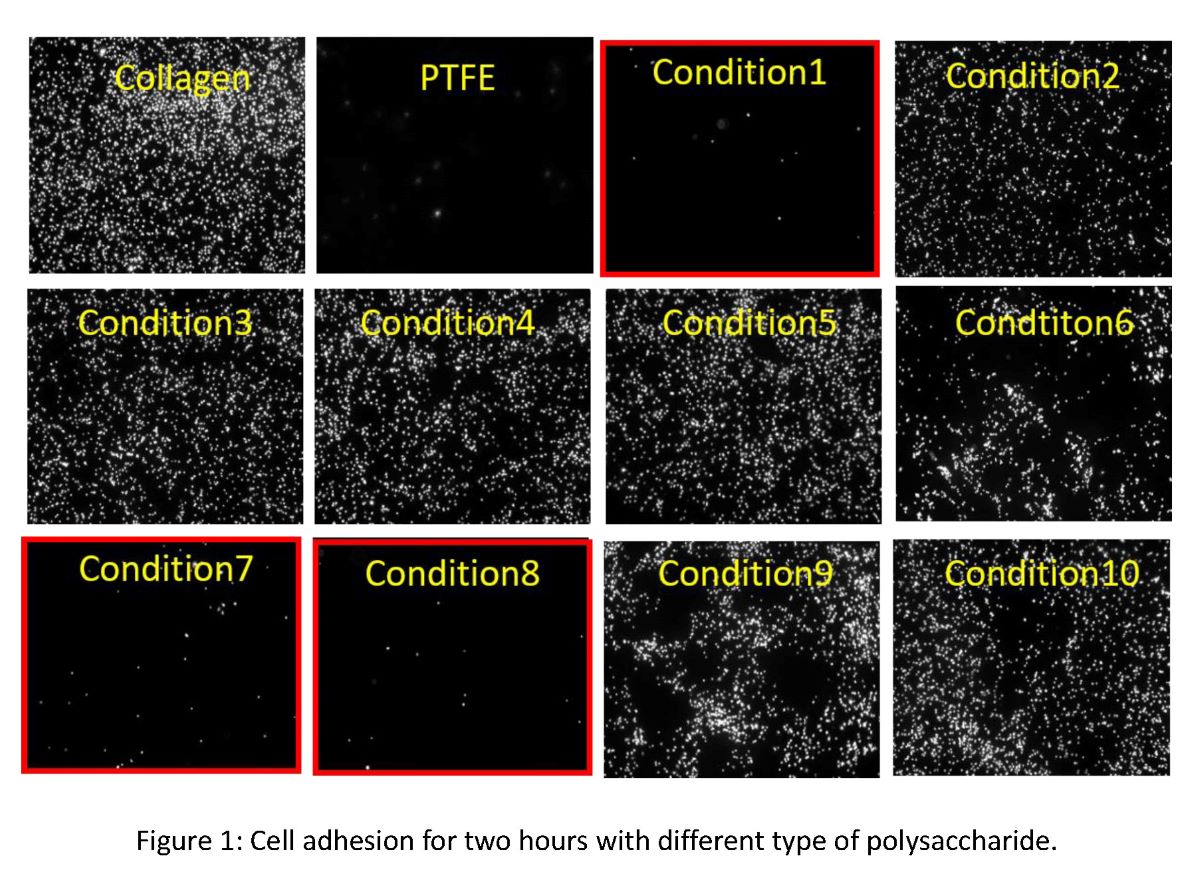
Recently, treatments by transplanting tissues obtained from living cell culture have been performing as regenerative medicine. In this case, the quality of cell products varies between specimens and changes during culture. At present, quality evaluation of cultured tissue generally relies on invasive techniques. However, in the production process of cultured tissues, it is better to avoid consumption of cells for quality evaluation due to the scarcity of raw material. We aim to be able to determine the transplant timing of cultured tissue from the information obtained by non-invasive method. In this research, we considered each cellular behavior (migration, division, differentiation, etc.) as a “module”, and the strength of cell-cell adhesion and cell-substrate adhesion as energy. We constructed a cell culture simulator where all cellular behaviors are determined by energy calculation using kinetic model. In corneal epithelial cell sheet formation culture, it was observed that the fluidity of cell sheet changes during the culture. In addition, the cell sheet fluidity was different between specimens. By using simulator constructed, it was able to express the changes of cell sheet fluidity of each specimen by changing cell characteristic parameter values. As a result, it was suggested that the different cell sheet fluidity between specimens was due to the increase and decrease in cell-cell adhesion strength, and structural strength of cell sheet was high when the cell sheet fluidity was low. In addition, when the cell sheet fluidity was low, the calculated value of sum of tight junction energy in the cell sheet was maximum value. From this result, it was suggested that measurement of trans-epithelial electrical resistance, which is directly correlated with the formation of tight junction, was effective as a non-invasive and quantitative method for evaluating the strength of cell sheet structure during culture.
Alginate and chitosan have favorable properties as biomaterials such as nontoxicity, biodegradability, biocompatibility and antibiotic property. Alginate and chitosan ultrafine fibers generated through electrospinning have drawn widespread attention at tissue engineering scaffolds, drug release carriers, wound dressings and so forth. While both alginate and chitosan are water-soluble, the electrospun mats have to be insolubilized before the usage in these applications. Herein, we proposed the method of preparing alginate and chitosan water-insoluble nanofibers through electrospinning and horseradish peroxidase (HRP)-mediated crosslinking of phenolic hydroxyl (Ph) moieties under stimulating of vaporized H2O2. In details, alginate and chitosan were firstly modified with Ph moieties, namely alginate-Ph and chitosan-Ph. Alginate-Ph blending (alginate-Ph 2% w/v, polyethylene oxide (PEO) 9% w/v, Pluronic F-127 5% w/v, HRP 160 U/ml ) and chitosan-Ph blending (chitosan-Ph 1% w/v, PEO 10% w/v, Pluronic F-127 10% w/v, HRP 160 U/ml ), were electrospun separately to fabricate nanofibers under conditions of voltage 11~15kv, needle to collector distance 8~15cm and flow rate 0.1 ml/h. The resultant fibers were then exposed to the air containing 3 ppm H2O2. The diameters of alginate-Ph fibers before and after exposure to the air containing H2O2 were 171 nm and 200 nm, respectively. Similar results were observed in the case of using chitosan-Ph. Successful crosslinking was confirmed for both alginate-Ph and chitosan-Ph fibers from the result of keeping fibrous structure after 48 h of soaking in PBS. In contrast, the fibers non-exposed to the air containing H2O2 dissolved immediately after soaking in PBS. These results clearly indicated the possibility of obtaining insolubilized nanofibers through electrospinning and HRP catalyzed reaction in the air containing H2O2.
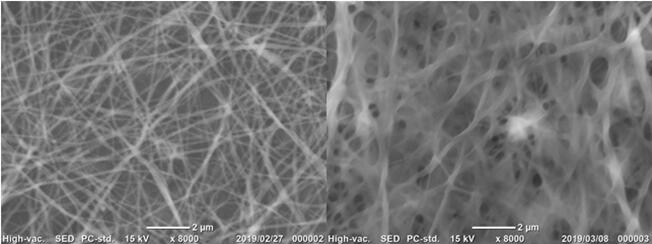
Endoscopic submucosal dissection (ESD) for the treatment of esophageal mucosal lesions is associated with high rates of postoperative stenosis, resulting in significantly decreased quality of life. Several therapies are available for the prevention and treatment of esophageal stenosis after ESD, including prevention via pharmacological treatment, endoscopic esophageal dilatation, stent placement, and autologous cell transplantation. However, no single method has been currently recognized as effective in clinical practices. Therefore, simple yet effective preventive methods are crucial to reduce the risk of postoperative esophageal stenosis.
Considering the operability under the endoscope, a spray material that can be administered through a 1.5 m-long and 4 mm-diameter endoscopic instrument channel is expected to be promising. Therefore, in this research, we developed a novel in situ cross-linkable powder for the prevention of esophageal stenosis after ESD. The powder was composed of alginate and gelatin; alginate can be rapidly cross-linked by calcium ions, whereas gelatin can be cross-linked with collagen on the submucosal exfoliated surface by transglutaminase. Therefore, by spraying them with their cross-linker solutions, hydrogel can be formed immediately with a firm adhesion to the wound surface.
Because there was no appropriate small animal model for evaluating esophageal stenosis-preventing material, we developed a brand-new stenosis model in rats by combining mechanical and trypsin treatment to rat esophagus. The rat model successfully caused stenosis, which was close to ESD-induced stenosis in clinical. The result of material administration to this model is shown in the figure below. The body-weight loss caused by stenosis was clearly reduced by the application of alginate/gelatin-mixed powder compared with untreated control group. The esophageal patency rate after 1 week and 2 weeks after surgery was also significantly improved compared with the control group. From these results, it is expected that this sprayable material is useful for preventing esophageal stricture after ESD.
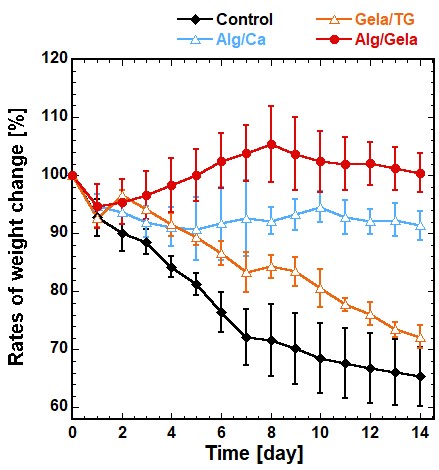
The prospect of regenerating organs and tissues would bring new possibilities of improving current treatments or find solutions for untreatable situations, thus having an enormous impact in the quality of life of patients. Tissue Engineering has been integrating principles of engineering, chemistry, materials science, biology and health sciences in order to develop regenerative-based therapeutic strategies combining stem cells and biomaterials. From the different sources of biomaterials, polysaccharides have been proposed to produce matrices able to interact favourably with cells. Due to their hydrophilic nature and richness in chemically active groups, such polymers can be used to produce a variety of structures fabricated using aqueous-based or other environmental-favourable procedures. Examples are shown in the modification of polysaccharides from marine origin and processing of devices into different sizes and shapes (e.g. hydrogels, multilayered coatings and membranes, particles) with structural and functional characteristics suitable to be used in tissue engineering and regenerative medicine applications. In particular, distinct strategies involving bioinspired approaches and nano/micro-technologies will be shown to engineer hybrid soft systems containing cells, in the form of microparticles, microgels or thin films, that could give rise to biomedical devices using bottom-up strategies.
Human skeletal muscle myoblast (HSMM) sheet transplantation is promising therapy for severe heart failure. The myoblast sheet has proved to secrete multiple cytokines such as vascular endothelial growth factor (VEGF), hepatocyte growth factor (HGF) and fibroblast growth factor-2 (FGF-2), which associate with cardiac functional improvement. The purpose of this study is to explore the regulation of cytokine productions and the impact of human skeletal muscle fibroblasts (HSMFs) on the regulation in HSMM sheet. Our current results demonstrated that cell density/myo-myo contact regulate the VEGF production in HSMMs. The VEGF productivity was high at low density in HSMM culture and vice versa while the productivity was low and unchanged by cell density in HSMFs. By varying ratio of HSMFs, it was shown that the VEGF productivity was increased by 2-fold (maximum level) by addition of small population of HSMFs (at 15%) in HSMM culture but the productivity was more reduced at higher ratios of HSMFs. For HGF, the productivity was HSMF ratio dependency and HGF was undetectable in HSMM culture alone suggesting that HGF was mainly secreted from HSMFs. Furthermore, FGF-2 was undetectable in all conditions. By using a cell tracking system and time-lapse observation, we found that HSMFs showed fast-random migration and disrupted myoblast alignment in HSMM culture. This evidence implied that a minor population of HSMFs in HSMM culture might promote VEGF productivity through physical myo-myo contact disruption. Our studies provided the fundamental understanding of VEGF regulation, which is useful to develop complex HSMM sheet or engineered tissue for transplantation, and highlight the role of fibroblasts on VEGF secretion regulation from adjacent tissue in pathological conditions.
Islet allotransplantation is a forthright approach to restore normoglycemia without daily, lifelong insulin injections. Nevertheless, the majority of the islets are lost almost immediately after transplantation due to poor access to nutrients from lack of vascularization which results in need of multiple donors for a single operation. In order to address this issue, highly-porous polymeric scaffold was fabricated as an implantable bioartificial pancreas utilizing modular tissue engineering approach. Pancreas β-cells were immobilized in three-dimensional scaffold and studied for its functionality as bioartificial pancreas in 7-day perfusion culture. During the 1-week perfusion culture, the amount of glucose consumption was observed decreasing and the produced lactate remained relatively low and constant in the cell-laden micro-scaffolds. Referring to the glucose-dependent function, the insulin secretion kept increase during the perfusion culture. Additionally, as visualized by live/dead staining, the immobilized cells remained viable after 7 days of perfusion. The β cells seemed to persist in clusters rather than separated single cells. These results demonstrated the potential of the micro-scaffold to maintain aerobic respiration for cultured cells, which could be resulted from the highly porous structure of the constructs.
AMBIC (AMBIC.org) is an industrial–academic–government consortium dedicated to addressing research and development challenges in upstream cell culture bioprocessing identified by the 22 industrial and 2 government members. Focal areas of the center include industrially-relevant biology, process monitoring and control, and consensus and standardization issues. Proposed areas of common interest to industrial members are elucidated through summer workshops organized around the topical areas of cells, raw materials, processes, and equipment, resulting in a call for proposal to academic members. Academics then present proposals which are voted on by industrial members to yield 2-year research and development projects in academic labs that address these biomanufacturing challenges under the guidance and mentorship of our industrial sponsors during monthly meeting. These activities have resulted in the start-up and execution of approximately 18 active and several graduated research projects under way at the academic participating institutions including Johns Hopkins University, University of Delaware, University of Massachusetts, Lowell, Clemson University, and University of Maryland, College Park. This presentation will discuss the activities of the AMBIC center followed by an overview of the projects underway within AMBIC. Projects currently under way include efforts to develop a community reference cell, process, and media, elucidating the solubility of nutrient concentrates and chemical complexes, understanding and manipulating the epigenome, identification of inhibitory waste products, sensors development for Surface Enhanced Raman Spectroscopy (SERS) and “Smart Marbles”, adaptation of process models for cell culture media and process feeding, controlling glycolytic pathways through chemical additives, and evaluating extracellular vesicles, ER stress pathways, and host cell proteins,. Progress obtained on these projects will be discussed along with a description of how the biopharma ecosystem is partnering and collaborating to identify and address critical common biomanufacturing challenges.
The monoclonal antibodies (mAbs) are widely used to produce therapeutic proteins. The rapidly evolving market for mAbs including biosimilars is making it necessary to realize superior manufacturing processes regarding costs and time. Generally, production in continuous mode can improve process efficiency. Continuous manufacturing for mAbs is intensively researched for individual unit operations in the upstream (e.g., perfusion) and downstream (e.g., chromatography using simulated moving bed), and for the end-to-end process. However, it is yet to establish process design models that can indicate when the novel continuous mode becomes more beneficial than the conventional batch mode.
We present a simulation-based approach for designing mAb production processes considering the continuous mode as an alternative. Differential equation models for cell cultivation and protein A separation have been applied based on fundamental physical phenomena. The model parameters were estimated using production data from a pilot scale research facility for the production of mAbs from Chinese hamster ovary (CHO) cells. After confirming the model performance using the production data, we performed economic process assessment. Different scenarios were considered regarding the operation modes, i.e., batch or continuous, and equipment, i.e., single-use or multi-use, for the individual units as well as the end-to-end process.
The simulation results indicated that the favorable scenarios varied in the upstream and downstream depending on the production scale and the CHO cell performance. The superiority of the fully integrated continuous process has been seen regarding productivity. Sensitivity analysis revealed the relevance of the cell performance, which was represented by the maximum doubling and death rates in the model. This finding will open up a new research opportunity to connect cell design with product and process design on a simultaneous basis.
Chinese hamster ovary (CHO) cells have been widely used as a host for biopharmaceutical protein production. Usually, producer cell lines are established from a recombinant cell pool containing thousands of cells with random integration of transgene. Thus, the screening of producer cells is time-consuming and labor-intensive process. We have previously reported an accumulative transgene integration system (AGIS) using Cre-recombinase and mutated loxPs, in which transgenes can be efficiently introduced into a chromosomal locus carrying a loxP target site [Kameyama et al., Biotechnol. Bioeng., 105, 1106–114 (2010); Obayashi et al., J. Biosci. Bioeng., 113, 381–388 (2012)]. In this study, the system was applied for establishing high-producer CHO cells. The founder cells, in which a mutated loxP and an expression cassette encoding the red fluorescent protein (DsRed) were introduced into the hprt locus of CHO cell genome, were used. An expression cassette of anti-prion scFv-Fc was introduced into the donor plasmids. Cells were transfected with donor plasmids and Cre-expression vector by lipofection or electroporation. To accelerate the screening process, the target cells were selected by change in color of reporter fluorescent proteins. Simultaneous transgene integration from two donor vectors was possible for the screening of cells with multiple copies of transgene. A minicircle DNA vector as a donor facilitated the transgene integration. We obtained targeted CHO cells with 6 copies of transgene into the hprt locus after three rounds of transfection and screening. The scFv-Fc productivity increased corresponding to the transgene copy number. This procedure is promising for the generation of producer cell lines for the production of pharmaceutical recombinant proteins.
This work was supported in part by grants for developing key technologies for discovering and manufacturing pharmaceuticals used for next-generation treatment and diagnoses, both from METI and AMED under Grant Number JP17ae0101003.
Digital counting of fluorescent signals generated in many small compartments can significantly improve the detection sensitivity of quantitative PCR and enzyme-linked immunosorbent assay (ELISA). However, the reported digital ELISA systems still need extensive washing steps to remove background signal, which hampered its performance. To address this problem, creation of a vesicle (Protocell) array that amplifies the binding signal of external protein as a fluorescent signal was attempted. We chose mutant β-glucuronidase (GUS) as a reporter enzyme that needs assembly of the four subunits by the dimerization of dimers, and which is inhibited by a set of interface mutations. Using a thermostabilized GUS mutant IV-5, we screened out an interface mutant (M516K, F517W) to create IV5m - a mutant with high thermostability and activity that is inactive on its own but becomes active when dimerized. After tethering short N-terminal tag and transmembrane (TM) sequences derived of epidermal growth factor receptor, the fusion protein was expressed by a cell-free protein synthesis system inside protocells, which were formed by the centrifugation of inverted emulsion. When corresponding tag-specific antibody was applied outside of the protocells, a clear increase in GUS activity was observed inside vesicles by adding fluorescent substrate, probably due to spontaneous integration of the expressed protein into the vesicles and dimerization by the antibody bound to the displayed tag. Furthermore, using a flow cytometry (FCM) digital signal was obtained by counting fluorescent protocells in response to external anti-His6 antibody concentration. Furthermore, SpyTag/SpyCatcher system was tested on this biosensor by expressing SpyTag-TM-IV5m in protocells, and adding His6-tagged SpyCather protein and anti-His6 antibody outside of protocells. An antibody dose-dependent increase in the population of fluorescent protocells was also detected by FCM, implying its potential applicability to antigen detection system. We are now testing the single molecule detectability of the system.
Acknowledgement: SICORP of JST.
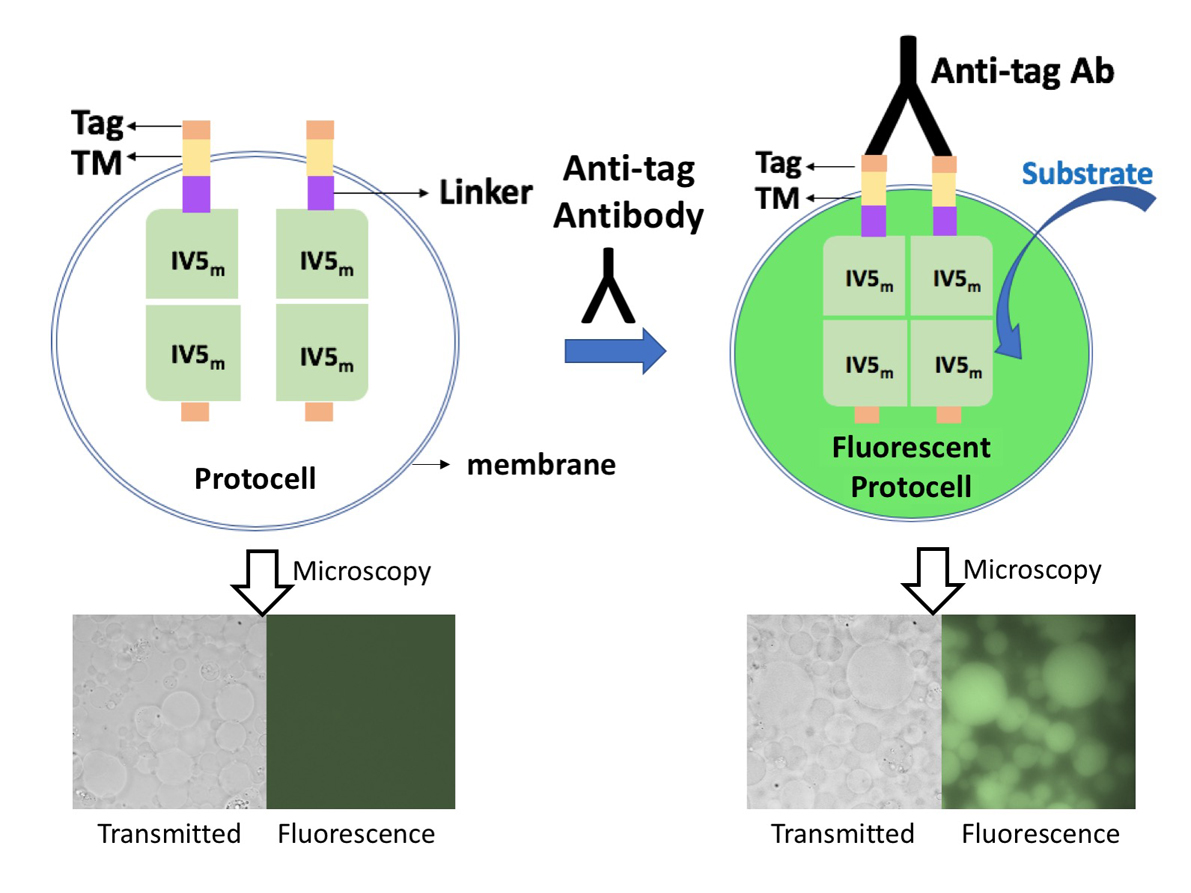
In the last years, the demand for human induced pluripotent stem (hiPS) has increased along with the progress of the clinical trials. This trend indicates the necessity for establishing freezing processes of hiPS cells for preservation and transportation. Generally, there are two methods for freezing cells: slow freezing and vitrification. In the field of cryobiology, both experimental and modeling studies have been conducted on slow freezing. The process can benefit from scalability, simplicity in operation, and no direct contact with freezing agent. However, the process could suffer from the quality variation intracontainer, and intra- and interfreezer.
We present a model-based design of slow freezing processes for hiPS cells considering the quality variation inside a container (i.e., a vial). A single-cell model was developed that integrated mechanistic models describing a radial and temporal temperature profile, cell volume change through transmembrane water transport, and intracellular ice formation during slow freezing. The overall inputs of the model are the cooling rate of the freezer, the vial diameter and material, and the cryoprotective agent type. The outputs are the maxima of cell volume change and the intracellular ice crystal volume as the cell quality indicators, and the required freezing time as the productivity indicator.
The model showed sufficient performance compared with a recently reported experimental study on hiPS cells. Based on this confirmation, the model was applied for three design cases. The choice of a cryoprotective agent, cooling rate, and vial diameter significantly affected the quality evaluation. When considering the productivity, the optimal vial diameter changed depending on the cell demand and the acceptable intracellular ice crystal volume. In the ongoing work, we are performing rigorous performance assessment of the model by extensive experiments. Advanced process optimization such as dynamic temperature optimization is another ongoing subject.
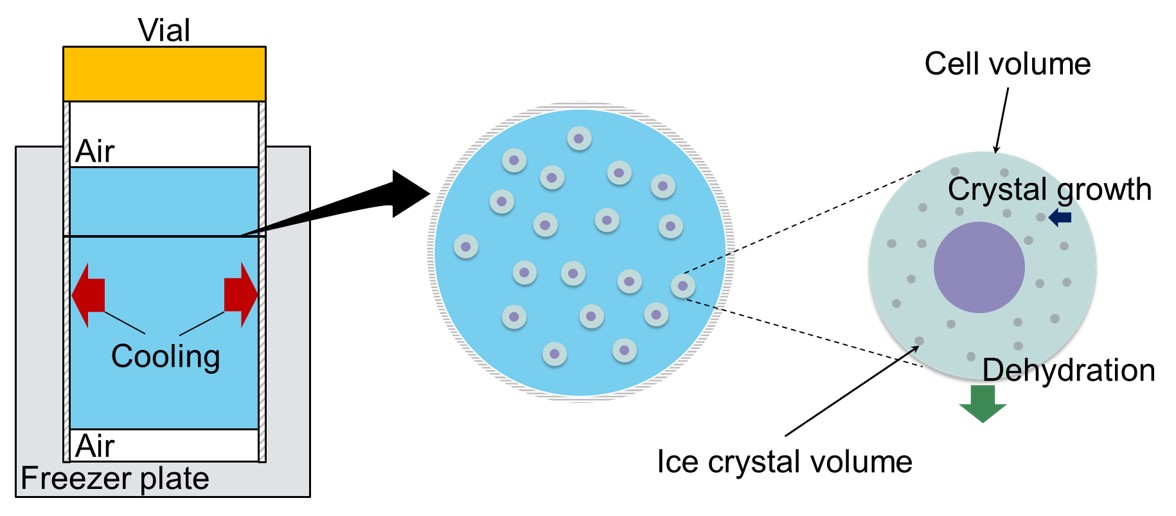
In recent years, researchers have shown an increase interest in lung disease owning to worse air pollution globally and high pulmonary attention. Several studies have examined issues related to the development of pulmonary administration of drug delivery. Yet, they still face several problems with the effectiveness of preclinical predictions on human drug responses and the shortage of high fidelity in organ-level cell testing without breathing simulation in vitro. The aim of this study was to fabricate a live and simple bronchial-like monitor with breathing motion mechanism for pulmonary drug testing. This bronchial-like monitor is regulated by deformation of the elastic membrane, leading to spontaneously air flow passing in and out. The deformation of membrane is dominated by different diameters of microchannel embedded in the bronchial-like monitor. The restriction of microchannel is contributed from the liquid flow controlled by a peristaltic pump. Therefore, the breathing mechanism can be manipulated by liquid flow rate and channel size. When liquid flow rate sets to be 0.84 ml/min (shear stress is 0.15 dyn/cm2), 328 μl/min of air flow rate and 0.49 dyn/cm2 of shear stress can be generated in the airway channel of the monitor. Additionally, the pattern of pressure drop in the airway channel also shows periodic tendency as successfully mimicking breathing motion of human. The Reynold number notes to be 0.30 that fully supports the laminar air flow in the bronchial-like airway. Furthermore, we cultured lung carcinoma A549 cells in the monitor with cyclic air flow to recapitulate the physiological relevant bronchial-like breathing model. This model, in the future, can be utilized to reconstruct the human healthy bronchiolar epithelium and to observe the toxicity and efficacy of pulmonary drug with breathing motion mechanism.
The intranasal delivery of vaccines has recently emerged as an attractive alternative to injection. The main mechanism of the intranasal vaccination is that the antigens in the vaccine transport via M cells in the nasal epithelium, then resident dendritic cells capture antigens and process them to induce the immune responses. However, it shows several disadvantages: short residence time of the antigens in nasal cavity due to the rapid nasal mucociliary clearance and weak immune responses due to the inefficient antigens transportation to the immune system.
To overcome these issues, a Solid-in-Oil (S/O) nanodispersion technique was developed for intranasal vaccine delivery. It is based on nanodispersions of hydrophilic antigens coated with hydrophobic surfactant molecules in an oil vehicle. Surfactant molecules and the oil vehicle could increase the nasal residence time of the antigens due to its mucoadhesive effect. Moreover, nanosized particles is expected to improve the delivery efficiency of the antigens to the immune system and induce strong immune responses (Fig.1).
We investigated the potential of intranasal vaccination by using S/O nanodispersions loaded with a model antigen ovalbumin (OVA). S/O nanodispersions containing OVA in different oil vehicles were prepared and the formulation using squalene oil was chosen due to the small particle size. Moreover, nasal absorption and nasal residence time of OVA were assessed to be increased by S/O nanodispersions. Finally, the OVA-specific antibody levels from serum and nasal mucosal washes from the mice were evaluated after intranasal vaccination. We found that intranasal administration of S/O nanodispersions induced strong mucosal and systemic immune responses and could be used for the future intranasal vaccination.
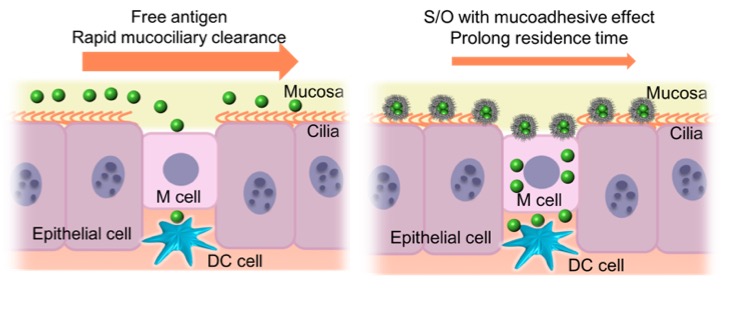
Transdermal delivery has been developed as one of the most attractive administration methods of vaccine antigen, which is safe and convenient. In transdermal vaccination, we need to deliver antigen to the immune cell in the skin to start the immune response. However, it is difficult for hydrophilic macromolecules such as protein to be permeated into the skin due to hydrophobic barrier function of stratum corneum; the outmost layer of skin. In recent years, it has been reported that skin permeability of the antigen is enhanced by using a solid-in-oil (S/O) nanodispersion, in which hydrophilic substances were coated with a hydrophobic surfactant and dispersed in oil as nanometer-sized particles. The purpose of this research is to prepare a practical transdermal vaccine by S/O technique from commercially available injection vaccine, in which antigen is dissolved in saline because osmotic pressure of injection vaccine is adjust with body fluid. In this study, fluorescein isothiocyanate-labeled ovalbumin (FITC-OVA) and isopropyl myristate (IPM) were used as a model antigen and an oil base with skin penetration effect, respectively. To check the effects of salts on nanoparticle formation and skin permeability, FITC-OVA was initially dissolved in saline according to commercially available vaccine and prepared S/O nanodispersions. As a result, it was confirmed that the particle diameter increased and the skin penetration amount decreased in the sample of high salt concentration. It is shown that it is important to reduce the salt concentration to make a transdermal vaccine from injection one.
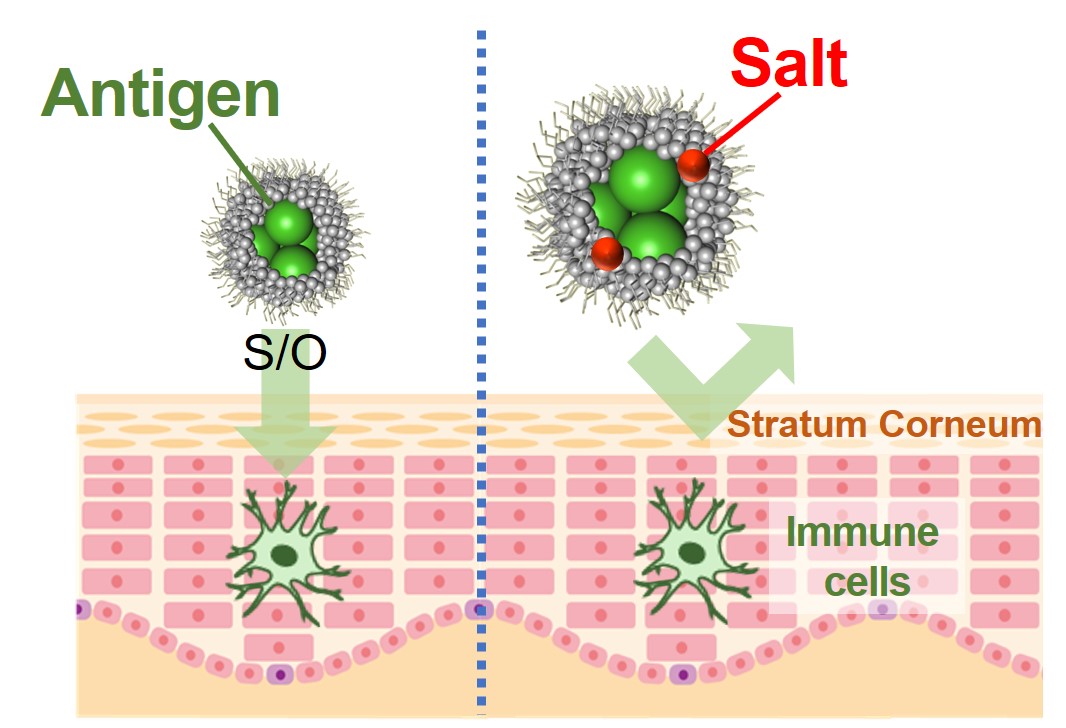
Stem cells are attractive source for tissue engineering applied on regenerative medicine, translational medicine, and drug discovery. Batch type culture is the typical way for stem cell culture, which is laborious and expansive. Moreover, the digestive enzymes or EDTA solutions to detach cells are causing cell damage and increasing production costs. For reducing the costs, we developed the continuous culture system culturing the human embryonic stem cells (hESCs) on thermoresponsive polymer surfaces (Fig. 1). hESCs could be detached from the thermoresponsive polymer surfaces by reducing the medium temperature below the lower critical solution temperature (LCST) of the thermoresponsive polymer (poly-N-isopropylacrylamide and its copolymer). After reducing the temperature, the thermoresponsive surface will become more hydrophilic, creating an unfavorable environment for cell attachment. Thus, hESCs can be partially detached by gentle pipetting. The remained cells could be confluent again by adding fresh medium. This continuous culture system could be used for 3D-cultivation. However, the barrier of applying this system is hESCs became harder to attach on the thermoresponsive surfaces coating with the extracellular matrix (ECM) after multicycles. This maybe cause by degradation of ECM after long-term culture. Therefore, we investigated the precoated and uncoated methods with different ECM; recombinant vitronectin (rVN) and recombinant laminin-511 (iMatrix-511). Comparing with traditional precoated method, the uncoated method where ECM is added into culture medium upon seeding cells, provides cost-effective and time-efficient method and maintains hESCs pluripotency during long-term culture. This uncoated method applied to continuous culture system saves processing time and cost and contributes to the regenerative medicine.
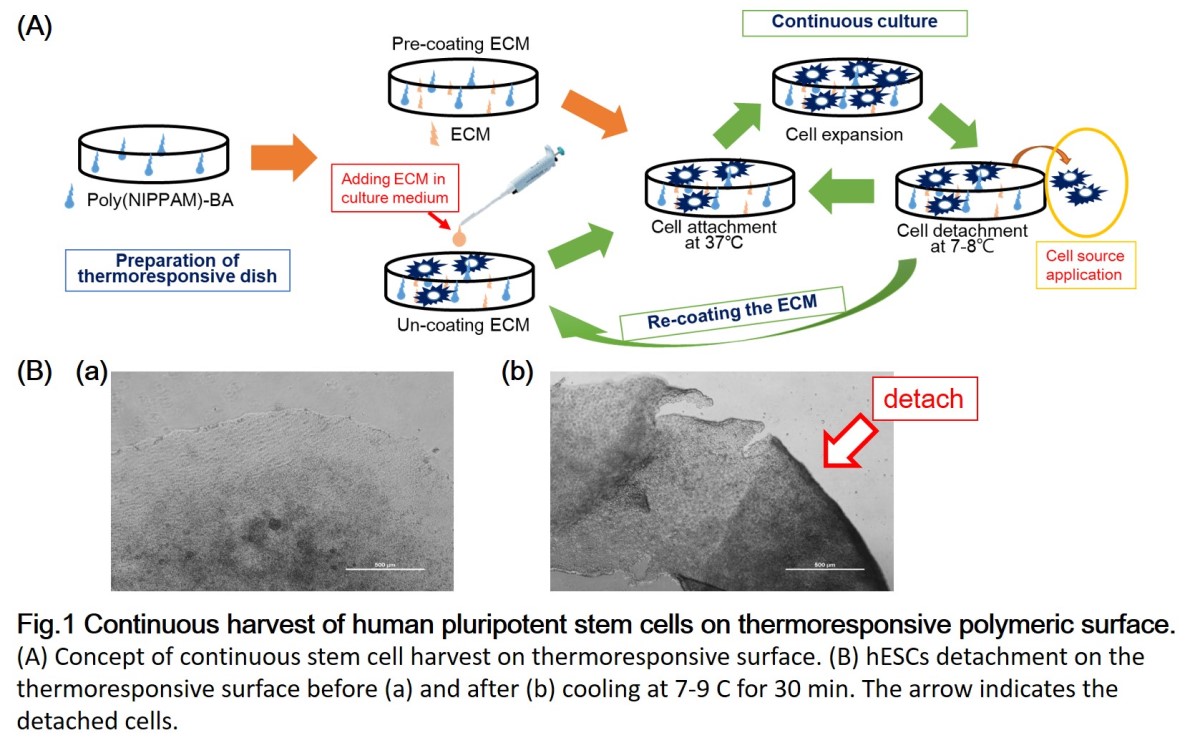
Transdermal delivery has been developed as one of the most attractive administration methods of peptides, which are used as biopharmaceuticals for refractory diseases or synthetic antigens for vaccination including cancer treatment or prevent from infections. In transdermal vaccination, we need to deliver peptide antigen to the immune cell in the skin to start the immune response. However, it is difficult for hydrophilic macromolecules such as peptides to be permeated into the skin since stratum corneum; the outmost layer of skin shows the hydrophobic barrier function. In this study, we developed oil-based formulation of peptides mediated by ionic liquid (IL) in order to achieve the efficient skin permeation. We used cytotoxic T cell epitope peptide (OVA 256-264, sequence: SIINFEKL) as a model peptide. This peptide is hydrophilic and not soluble in isopropyl myristate (IPM), which is an oil base with skin penetration effect. To disperse the peptide in IPM, the ILs consisting of choline cation and fatty acids anion were synthesized. These ILs are biocompatible and show high affinity to oil because they are derived from natural molecules and fatty acids have long alkyl chains. We successfully dispersed the hydrophilic peptide in IPM by adding the ILs and ethanol as co-solvent. Subsequently, we checked whether the peptide in oil formulation shows skin permeability and the permeation mechanism of peptide. The peptide with ionic liquid in oil formulation permeated into the model mouse skin, while the penetration of peptide in aqueous phosphate buffer was low. Moreover, we revealed that this ionic liquid in oil acts as the skin permeation enhancer by extracting and disordering the lipid in the stratum corneum. These results suggested that oil-based formulation using biocompatible ILs is a promising strategy for transdermal peptide delivery.

Vaccines are the most useful means for preventing infection, in which antigens are mainly administered by injection, and induce a systemic immune response in whole body to eliminate pathogens. In the case of an oral vaccine, antigens are captured M cells and delivered into Peyer's patches, lymph node-like lymphatic tissues, by the transcytosis, followed by the presentation of mucosal immunity. The ability of oral vaccines to activate mucosal immunity is attractive compared to injection because it is possible to prevent the initial infection. In this study, we tried to develop an oral vaccine delivery using a solid-in-oil (S/O) nanodispersion, in which hydrophilic drugs are coated with hydrophobic surfactants and dispersed in oil phase as nanoparticles. In addition to prevention of antigen degradation by low pH or enzymes, it is expected that the antigens are effectively delivered to the lymphatic tissues using oil-bases because hydrophobic materials such as lipids are known to be formed micelles and absorbed by lymphatic tissues rather than blood circulation. The S/O nanodispersion was prepared using ovalbumin (OVA) and sucrose fatty acid esters as a model antigen and surfactants, respectively. From in vitro release study using artificial intestinal fluid containing lipase and bile acids, the S/O nanodispersion using sucrose laurate (L-195) and perilla oil showed higher antigen release, while that using sucrose erucate (ER-290) and squalene oil released antigens gradually, resulted from the length of alkyl chain of surfactants and ester bonds of oils. From the oral vaccine study in vivo, the OVA-specific IgA production in the small intestine of mice was increased by the S/O nanodispersion using ER-290 and squalene oil compared to aqueous vehicle, phosphate buffered saline (PBS). These results suggested that the S/O nanodispersions releasing antigens gradually is suitable to deliver antigens to Peyer's patches, and induced mucosal immunity effectively.

Introduction.
Vancomycin is the drug of first choice for treating Methicillin-Resistant Staphylococcus Aureus (MRSA) infections which is the main causative bacteria of nosocomial infection. Therapeutic drug monitoring (TDM) of VCM is strongly recommended in order to prevent side effect and creation of the resistant bacteria. However, TDM does not work sufficiently, because frequent measurement of blood level of VCM is still difficult. We developed a blood-VCM sensor with a paste electrode of graphite particle on which a molecularly imprinted polymer (MIP) is immobilized covalently in this study. The sensitivity of the sensor to the VCM concentration in whole blood and plasma was evaluated.
Experimental method.
Graphite particles were coated with photoinitiator of radical polymerization was dispersed in a polymerization solution and irradiated with xenon lamp light. The MIP carbon was mixed with silicone oil and filled in a glass tube to prepare a carbon paste electrode immobilizing MIP of VCM.
The analyte solvent was prepared by dissolving VCM in phosphate buffer, bovine whole blood or plasma, and the relationship between current obtained by differential pulse voltammetry and the VCM concentration was observed.
Results and Discussion.
The calibration line of the VCM-MIP electrode is compared in each analyte solution at Fig. 1. First, the electrode indicated sensitivity to VCM in all analyte solutions. However, the sensitivity in plasma is about twice as high as in PBS or whole blood. It can be thought he detection of VCM is not interfered by blood cells. But oxidation of uric acid, or other kind of oxidative species in plasma enhances background current and oxidative current of vancomycin. But the enhancement is probably suppressed by the blood cells. However, the result indicates that the VCM-MIP electrode enables the sensing of VCM in whole blood without separation between the plasma and blood cells. The property is advantageous for real time monitoring of VCM.
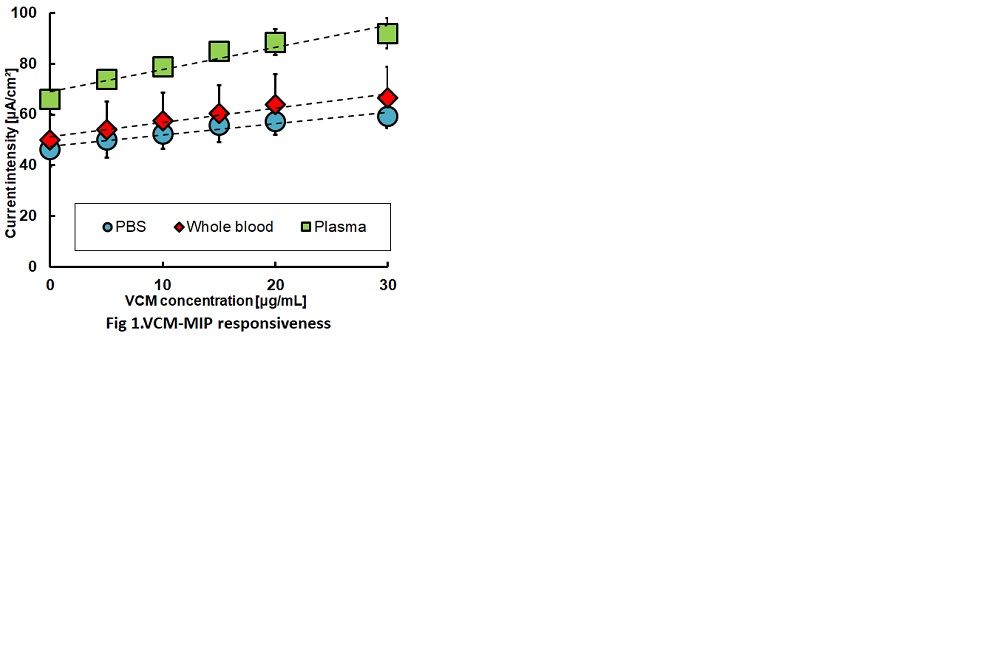
Human pluripotent stem cells (hPSCs) includes human embryonic stem cells (hESCs) and human induced pluripotent stem cells (hiPSCs) are a promising source for regenerative medicine and tissue engineering. Typically, hPSCs are used to culture on the extracellular matrix (ECM) coated dishes, such as Matrigel, recombinant vitronectin (rVN) and laminin-521 (LN-521), which were secreted from animal or human cells. However, those ECMs provided uncertain chemical composition. Therefore, the xeno-free synthetic biomaterials offer not only a chemical defined composition but also a reproducible culture condition.
In our previous study, we successfully cultured hPSCs on polyvinylalchohol-co-itaconic acid (PVA-IA) hydrogels, with optimal crosslinking elasticity, conjugated with vitronectin-derived oligopeptides (KGGPQVTRGDVFTMP), which provide RGD binding motifs for cell adhesion. The further key cell binding mechanism will be investigated by using PVA-IA hydrogels grafted with synthetic peptides from different chain compositions. Those synthetic peptides chains contain five variants of α-chain, four variants of β-chain and three variants of γ-chain of laminin, respectively. These synthetic peptides will be investigated by comparing the ability to support long term hPSCs culture and differentiation into cardiomyocytes (CMs). Therefore, we prepared PVA-IA hydrogels grafted with different oligopeptide sequences derived from Laminin α-chain (RGD), α1-chain (IKVAV) and β1-chain (YIGSR and PDSGR) to compare the efficiency of cell attachment and differentiate into CMs (Fig. 1). We also design some motifs with different length of joint segment to mimic the original ECM and evaluate the length effect on the culture of hPSCs. In this study, the expression four pluripotency gene (Oct3/4, Klf4, Sox2, and Nanog) of hPSCs is evaluated for ability to support hPSCs growth. hPSCs are induced into cardiomyocytes to screen the optimal synthetic peptide. We expected to screen the optimal combination of synthetic peptides for hPSC culturing and differentiation.
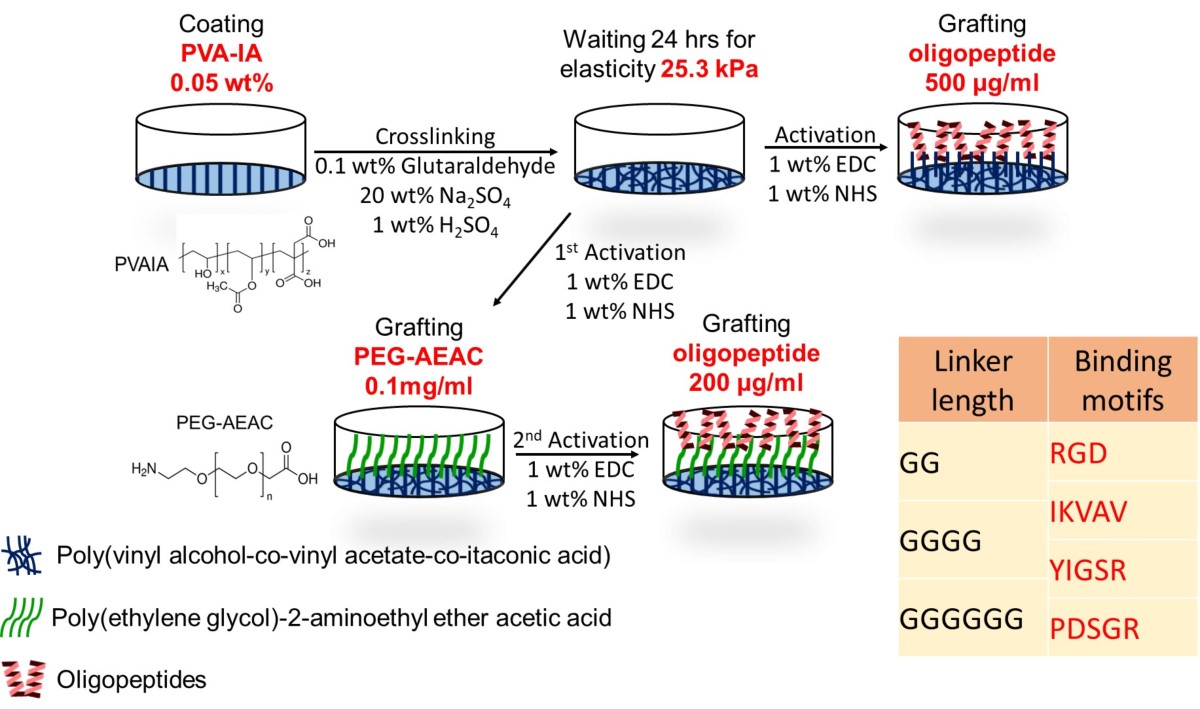
Cancer vaccine, a prophylactic therapy against cancer by administering a cancer antigen to activate the host immunity, has come to draw a great deal of attention due to its low risks of side effects. In this study, we focused on the transcutaneous drug delivery system for the cancer antigen delivery. This delivery route would be the ideal way, because skin immune cells are known to induce a strong immune response. However, the stratum corneum (SC), the outermost layer of the skin, works as a hydrophobic barrier to prevent the penetration of antigens which are mostly hydrophilic. To overcome this problem, we tried to use Reverse Micelle Formulation (RMF). In RMF system, hydrophilic drugs are enclosed inside the aqueous core of reverse micelles and dispersed in oil phase which SC prefers. Despite there were numerous reports regarding transcutaneous delivery using RMF, there was no report on a transcutaneous vaccine due to its still low skin permeability. In this study, we used amphiphilic Skin Permeation Enhancer (SPE) as surfactant which forms reverse micelles to realize even higher permeability. To the best of our knowledge this is the first report on this strategy, and we conducted experiments to prove its effectiveness.
We chose K-TRP-2 (KKKGSVYDFFVWL) peptide as a cancer antigen, and fatty acid glycerol ester as amphiphilic SPE. By dropping the aqueous solution of antigen onto surfactant-containing oil, we obtained uniform RMF. As a result of in vitro experiment, RMF showed a significant improvement in skin permeation of antigens. Also, RMF enabled the successful antigen delivery to the skin immune cells, which is a key step to induce an immune response, and its transcutaneous treatment recruited more cytotoxic T lymphocytes into tumor microenvironment than an injection treatment and strongly suppressed a tumor growth.
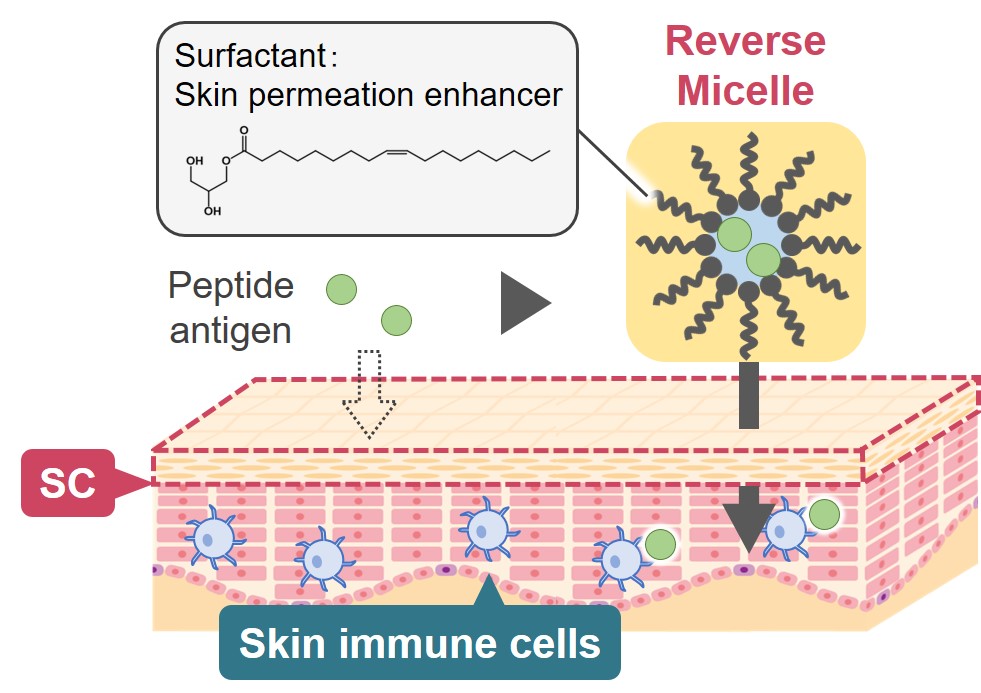
Preparation of three-dimensional (3D) organ models composed of liver cells is expected as an efficient approach to in vitro cell-based drug screening and development. Various types of hydrogel-based 3D cell culture systems have been developed, but the lack in the capillary networks in hydrogel matrices causes severe problems in terms of insufficient supply of oxygen and nutrition. Here we proposed a facile strategy for creating perfusable hydrogel-based liver cell culture systems. We utilized a bicontinuous aqueous two-phase dispersion, which was composed of polyethylene glycol (PEG)-rich and gelatin methacrylate (GelMA)-rich phases, to produce cell-encapsulating microporous gelatin-based hydrogels. The interconnected pores were utilized to perform perfusion culture of encapsulated HepG2 cells.
We first prepared an aqueous two-phase system of PEG/GelMA, and then remixed the separated two phases by controlling the mixing ratio, with the addition of a photopolymerization initiator and cells. Immediately after mixing, the GelMA-rich phase was photocrosslinked by irradiating UV light, to form millimeter-sized tablets of microporous sponges. We confirmed that most of the encapsulated cells were viable during this mixing and crosslinking processes, and after cultivation for 1 week. In contrast, cells encapsulated in uniform GelMA hydrogel were mostly dead after 1 day of cultivation. The expressions of hepatocyte-specific genes were upregulated for the hydrogel sponges, which was confirmed by RT-qPCR. Additionally, we performed perfusion culture of the cells, by packing the obtained hydrogel sponges into microfluidic perfusion chambers, and evaluated the functions of the encapsulated cells. The presented hydrogel sponges are useful because we did not need any complicated devices or protocols for preparing hydrogel sponges, and they would be applicable as a unit platform for organs-on-a-chip systems.
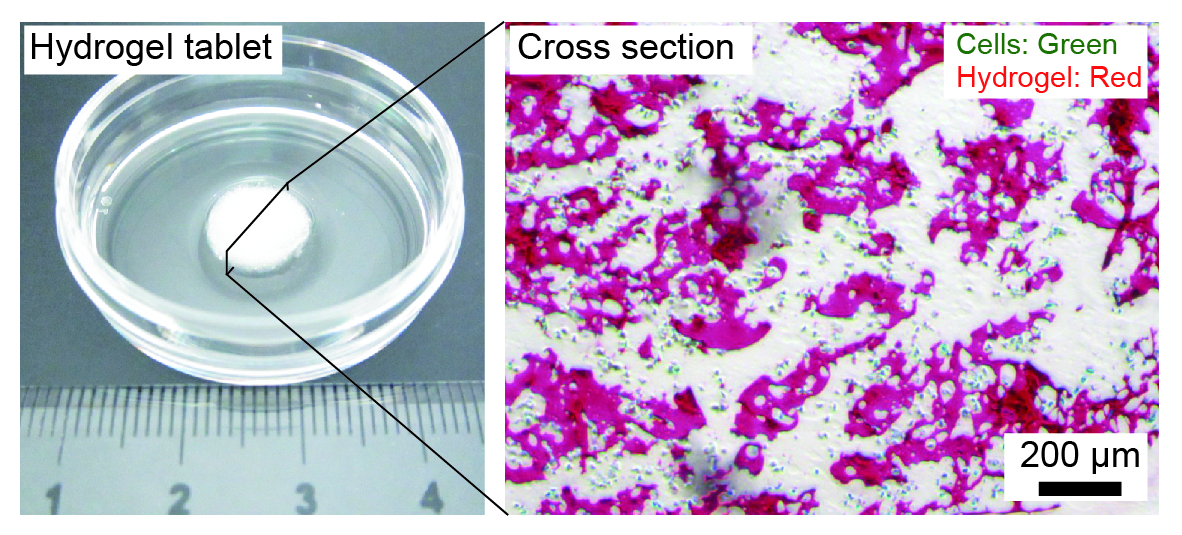
In this study, we report synthesis of hydropholic surface and active-target superparamagnetic iron oxide nanoparticles (SPIONs) for hyperthermia cancer therapy. Superparamagnetic iron oxide nanoparticles (SPIONs) capping oleic acid were prepared by thermal decomposition method. The synthesized iron oxide nanoparticles were encapsulated with the polyaspartamide (PA) to enhance their biocompatibility and hydrophilicity (PA-encapsulated SPIONs). A polysuccinime (PSI) which is biocompatible and biodegradable is the backbone of PA. In addition, multifunctional polymers including hydrophilic O-(2-aminoethyl) polyethylene glycol (PEG) and hydrophobic octadecylamine (C18) were grafted on PSI for amphiphilic structure, and on biotin for increasing the cancer cellular uptake. The diameter of the PA-encapsulated SPIONs was confirmed by TEM and DLS. The structure of the polyaspartamide was confirmed by 1H NMR. The structure and biomedical properties of PA-encapsulated SPIONs were investigated in vitro and in vivo experiments.

A vaccine is a drug that administers an antigen derived from a pathogen to the body and induces antigen-specific immunity. In the case of therapeutic vaccines, it consists of antigens and adjuvants (additives to enhance the immune response), and various delivery systems that deliver them to immune cells have been reported. In several studies, strong vaccine effects were induced using intelligent lipid or polymer-based delivery systems. However, most of the candidates have not been put to practical use because novel, synthesized compounds must be confirmed the safety in human. Mostly, it takes over 10 years to accept to use clinical phase, and it is hard to balance high safety and effect of vaccine delivery. To overcome this problem, we used a clinically accepted adjuvant, oil-in-water (O/W) emulsion, as vaccine carrier. Though it has high safety and effect for human, the efficiency is limited because hydrophilic antigen and O/W emulsion are administered separately. In this study, we tried to create a solid-in-oil-in-water (S/O/W) adjuvant that encapsulates antigens in oil phase using solid-in-oil (S/O) technology and can simultaneously administer antigen and adjuvant. Composition of S/O/W adjuvant is based on MF59, commercially available O/W emulsion, and ovalbumin (OVA) was used as a model antigen. The S/O/W adjuvant was determined as a nano-sized emulsion (ca. 300 nm) and over 90 % of antigen was encapsulated after 24 h. From in vitro study using dendritic cells, efficient intracellular delivery and lysosomal escape of antigens were achieved by S/O/W adjuvant. Furthermore, when S/O/W adjuvant was administered subcutaneously to mice in vivo, the antigen-specific humoral and cellular immunity was induced more effectively than O/W emulsion and OVA free. These results suggested that S/O/W adjuvant, which can achieve co-delivery of antigen and adjuvant, is a novel approach to develop effective carriers for therapeutic vaccine such as cancer immunotherapy.

Virus-like particles (VLPs) can be produced using recombinant DNA technology by expressing viral surface proteins that spontaneously assemble into particulate structures similar to authentic viral particles. VLPs serve as safe and effective vaccines and diagnostic antigens. The baculovirus–insect cell system has been used extensively for the production of a wide range pf VLPs. However, the baculovirus system has several inherent limitations including contamination of VLPs with progeny baculoviruses. Stably transformed insect cells can be used as attractive alternatives to the baculovirus–insect cell system. In the present study, the production of influenza VLPs by recombinant insect cells was investigated.
The DNA fragments encoding hemagglutinin (HA) and matrix protein 1 (M1) of an influenza virus A (H1N1) were individually cloned into the plasmid vector pIHAbla and pIHAneo. The pIHAbla and pIHAneo contained the Bombyx mori actin promoter downstream of the B. mori nucleopolyhedrovirus (BmNPV) IE-1 transactivator and the BmNPV HR3 enhancer for high-level expression, together with either a blasticidin or a neomycin resistance gene for use as a selectable marker, respectively (Yamaji et al.: Biochem. Eng. J., 41, 203–209 (2008)). After cotransfection with the resultant plasmids, Trichoplusia ni BTI-TN-5B1-4 (High Five) cells were incubated with blasticidin and G418, and cells resistant to the antibiotics were isolated.
Western blot analysis of a culture supernatant showed that transfected High Five cells secreted HA and M1. Sucrose density-gradient sedimentation analysis and dynamic light scattering of the culture supernatant suggested that secreted HA and M1 molecules were produced in a particulate form. Hemagglutination assay using chicken erythrocytes revealed hemagglutination activity in the culture supernatant. Taken together, recombinant insect cells may offer a promising approach to the development and production of influenza VLPs.
Mesoporous silica nanoparticles (MSNs) conjugating doxorubicin (DOX) via a pH-sensitive cleavable linkage, hydrazine (HYD) were synthesized. MSN-HYD-DOX were encapsulated with the polyaspartamide (PASPAM) grafted with the hydrophilic o-(2-aminoethyl)-o′-methylpoly(ethylene glycol) (PEG) and the cell permeating ligand, biotin (Biotin). The chemical structure of the synthesized MSN-HYD-DOX and PASPAM-g-PEG/Biotin was confirmed using FT-IR and 1H-NMR spectroscopy. The mean diameter of the MSN-HYD-DOX@PASPAM-g-PEG/Biotin nanoparticle was 142 nm and 121 nm, respectively, examined by dynamic light scattering (DLS) and transmission electron microscope (TEM). The HYD bond was effectively cleaved in acidic condition, and thus DOX was released much faster at pH 5.0 than at pH 7.4. The cell viability in MSN-HYD-DOX@PASPAM-g-PEG/Biotin system was much lower than that of the free DOX drug because of efficient intracellular drug delivery associated with the biotin ligand.
Gene delivery methods for animal cells are one of the most important tools in biotechnology fields such as gene therapy, generation of transgenic animals and pharmaceutical protein production. We have attempted to develop a gene transfer method based on retrotransposon. Retrotransposons are mobile elements that transfer themselves in a cell genome by the “copy-and-paste” mechanism. The process is known as retrotransposition. A retrotransposon, long interspersed element-1 (LINE-1, L1) is categorized as a non-LTR retrotransposon, comprised of a 5' untranslated region (5'UTR), two non-overlapping open reading frames (ORFs) separated by a short inter-ORF sequence, and a 3'UTR that ends in an adenosine-rich tract. We constructed an L1-based vector plasmid including the essential components for retrotransposition. An intron-disrupted Neor reporter gene and a scFv-Fc expression unit under the control of CMV promoter were inserted into 3'UTR region in order to evaluate retrotransposition and scFv-Fc production. CHO-K1 cells transfected with the plasmids were screened using G418 for 10 days. The established cell clones produced scFv-Fc proteins in the culture medium. To control retrotransposition, we removed the ORF2 sequence from L1 vector to generate ORF2-deleted L1 (L1[$Delta;orf2]) vector, and constructed ORF2 expression vectors (pORF2 and pORF1-2) for providing ORF2 proteins. Under the optimal ratio of L1[$Delta;orf2] vector and ORF2 expression vector, no significant difference in the number of G418-resistant colonies formed was observed compared with that for L1 vector although it slightly decreased. The scFv-Fc gene was detected in all clones by genomic PCR. Real-time PCR revealed that scFv-Fc gene was integrated into the genome at the range from one to six copies in the clones.
Stem cells are an attractive prospect for regenerative medicine and tissue engineering. However, stem cell are difficult to differentiate into specific cell types. Thus, reliable methods to differentiate stem cells into desired cell types are necessary to be developed. Here, we developed nanosegment-grafted biomaterials having different elasticity. [1] We also developed optimal differentiation media to induce the differentiation of hES cells into cardiomyocytes. We developed several biomaterials having different elasticity for hPSCs differentia-tion into cardiomyocytes. We prepared (1) ECM (extracellular matrix)-coated dishes, (2) PVA-IA (polyvinylalcohol-co-itaconic acid) hydrogel dishes having different elasticity that are grafted with several ECMs [2], and (3) PVA-IA hydrogel dishes having different elasticity that are grafted with cell-adhesion oligopeptide (oligovitronectin). We also investigated the differentiation efficiency using different induction medium: (a) Commercial cardiomyocyte induction medium, (b) RPMI 1640 medium supplemented with B27 and bovine serum albumin (BSA), (c) CDM3 medium (xeno-free culture medium) developed by literature [3] and in this study. On day 0, we replaced the expansion medium into cardiomyocytes differentiation medium containing the GSK3β inhibitor. On days 1-2, we observed that 30%~40% of the cells in the medium shown in medium (a) and 50~60% of the cells in the medium (b) were died and detached from the surface. However, the center of the colony of living cells were getting thicker and became compact. These cells were differentiated into cardiomyocytes on days 5-6. On day 8-10, we successively observed the contracting colonies on each biomaterial surface. We successfully screened the optimal elasticity of bio-materials, preferable nanosegments immobilized on the biomaterials as well as the cell culture medium for the optimal differentiation of hPSCs into cardiomyocytes. This system will be used for developing for cell sorting system, which will be a great benefit to its clinical application in regenerative medicine.
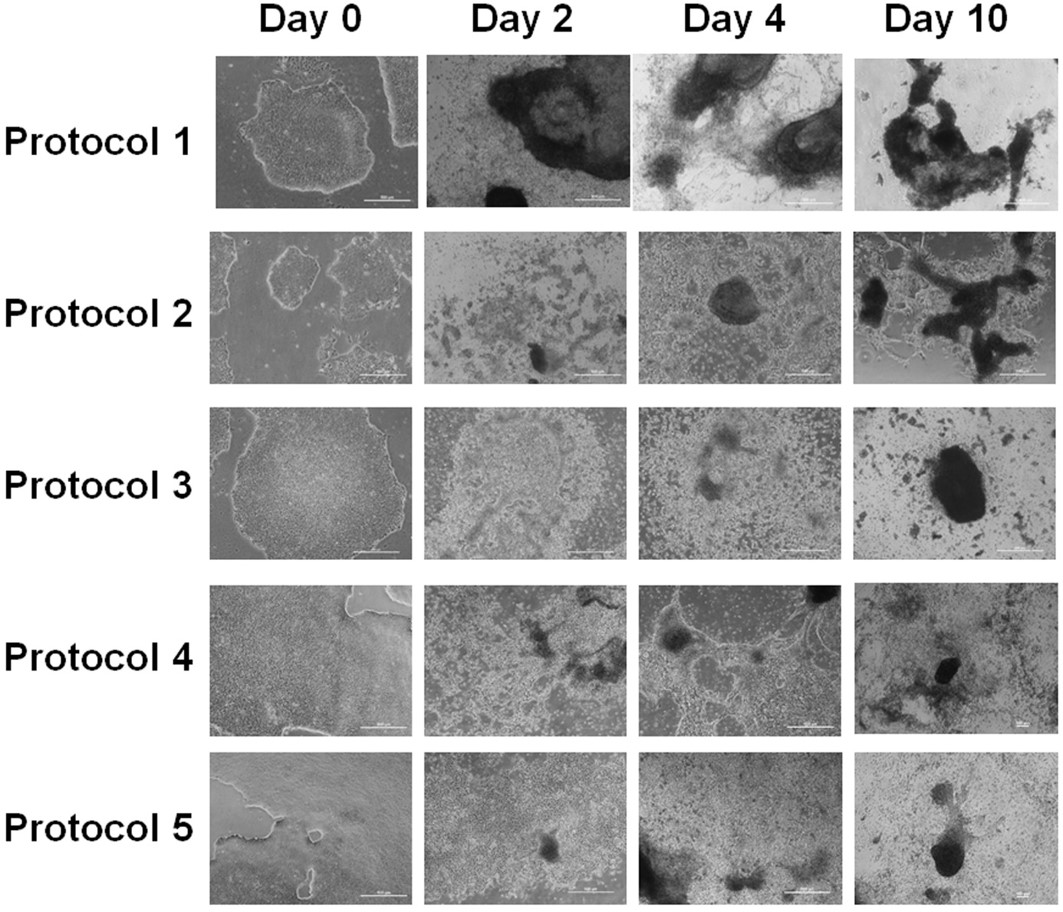
For acute and fulminant liver failure patients, liver transplantation is only an effective treatment. However, it has a big problem in donor organ shortage. As a bridge use for liver transplantation, bio-artificial liver (BAL) systems with extracorporeal blood circulation have been an attractive choice. For constructing BAL systems in which functional hepatic cells are filled in a bioreactor, hepatoma cells derived from liver carcinoma are a candidate cell source due to their high proliferative capacity, although liver function of hepatoma cells is considerably lower than that of primary hepatocytes. In our previous study, genetically engineered mouse hepatoma cells with inducible high liver function were established by transducing liver-enriched transcription factor (LETF) genes (Yamamoto et al., Biochem. Eng. J., 2012, 60, 67-73; J. Biosci. Bioeng., 2018, 125, 131-139). In this study, human hepatoma HepG2 cells were genetically engineered to express liver function in response to heat treatment. For this purpose, we constructed a heat-inducible expression of LETF genes, in which a tetracyclin-responsive artificial transactivator is expressed under control of a heat-shock protein promoter with transcriptional amplification and the transactivator then induces LETF genes. The gene expression system was constructed on transposon vectors and introduced into HepG2 cells. Transgenic cells (HepG2/HSP/8F) were screened by drug (puromycin and blasticidin) selection. For inducing overexpression of LETF genes, cells were heated at 43 °C for 30 min using water bath. Albumin secretion and cytochrome P450 activity were measured for the cells with or without heat treatment. The liver functions of HepG2/HSP/8F cells were enhanced by the heat treatment. The cells with heat-inducible liver function can be a new cell source for various hepatic studies including construction of BAL systems.
Encapsulation of water-insoluble bioactive compounds using chitosan-oleic acid complex particle was investigated. One-step preparation of chitosan-oleic acid complex particles encapsulating bioactive compounds with a narrow diameter distribution was carried out by the simple mixing of a chitosan aqueous solution and an ethanol solution containing oleic acid at room temperature. The formation of particles with mean diameter below 1 micrometer was confirmed by dynamic light scattering and laser diffraction measurements. A characteristic peak indicating aggregation of alkyl chain of oleic acid molecules was observed by small angle X-ray scattering measurement, suggesting that the particle had hydrophobic domains formed by aggregation of oleic acid molecules inside the complex particles. These characteristics agreed with scanning-transmittance electron microscopic images of complex particles. Various water-insoluble compounds including curcumin, capsaicin, and vitamin E were successfully encapsulated into the complex particles. Diameter distribution of the complex particles encapsulating bioactive compounds were maintained during storage over a month, suggesting that the particles were highly stable. The particle suspension could be concentrated by evaporation and powderized by freeze-drying without significant changes in their diameter. The results demonstrated that our method for encapsulating water-insoluble hydrophobic bioactive compounds using chitosan-oleic acid complex particles were potentially applicable as edible materials for development novel food dispersion systems.
A local anesthesia (LA) relieves the sense of a specific part of the body. It is used in the medical procedure for needle puncture or venous cannulation. The main administration of LA is injection, but this method is not only invasive and painful but also requires specialized knowledge and risk of secondary infection, so an alternative administration is required. Transdermal delivery of LA has advantages that enable to bring anesthesia effect without any pain and difficulty. The transdermal LA is available in commercial, but the current marketed product is not popular because it cannot eliminate pain completely and needs long-term continuous administration. Therefore, we aim to improve the effect of transdermal local anesthesia using non-aqueous base materials. Previously, the relationship of the pharmacokinetics and pain-relieving effect of LA are not revealed completely. These facts make difficult to improve analgesic effectiveness of LA. In this study, we conducted early clinical study in human and compared the results obtained in clinical trials with in vitro studies in laboratory scale. We used lidocaine as LA, and polyethylene glycol 400 (PEG400), isopropyl myristate (IPM) and isopropyl alcohol (IPA) as the base. In clinical study, we found that LA using IPA induced actual analgesic effectiveness and achieved painlessness within 10 minutes. On the other side, we found that IPM showed high permeation across the pig skin in vitro. It is suggested that high permeability across the skin did not lead improving analgesic effectiveness. Subsequently, we measured the amount of drug in the skin, and the sample using IPA as the base showed highest amount of lidocaine in the skin (shown in Figure 1, SC: stratum corneum). It is suggested that staying drug in the skin leads improving actual analgesic effectiveness because the result of clinical study corresponds with the result in vitro.
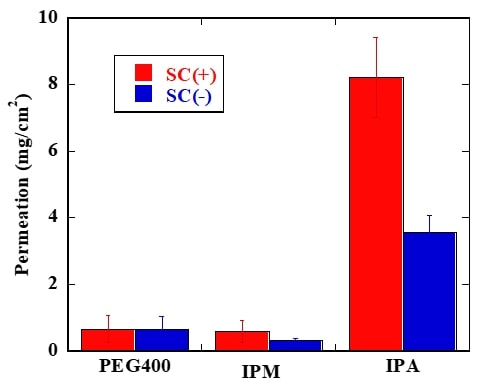
In recent years, the number of Japanese cedar pollinosis patients are increasing, and pollinosis immunotherapy has attracted much attention. However, the administration of a whole pollen allergen by injection has the risk of side effects such as anaphylactic shock. In this study, we tried to develop a simple, non-invasive method of pollinosis immunotherapy by the way of transcutaneous administration and used cedar pollen T cell epitope peptide A (PepA: SMKVTVAFNQFGP) with a low risk of adverse effects as an antigen. The presence of stratum corneum (SC) which is the hydrophobic barrier in the outermost layer of the skin makes it difficult for the hydrophilic antigen to penetrate the skin. To overcome the barrier, antigens were dispersed in hydrophobic solvent as nano-order particles using the solid-in-oil (S/O) nanodispersion, in which antigens are coated with hydrophobic surfactant molecules, to permeate through the SC. In this study, K-PepA, in which hydrophilic trilysin was conjugated to PepA, was used to increase the solubility in water and stability of the S/O nanodispersion.
First, the mice were vaccinated with K-PepA thrice with a one-week by injection. One week after the final immunization, splenocytes were harvested and T cells were quantified using flow cytometry. Similar to PepA, an increase in the number of Th1 cells was observed by K-PepA, suggesting the efficacy for pollinosis immunotherapy. Second, the S/O nanodispersion was obtained by freeze-drying the water-in-oil emulsions containing K-PepA in water phase and surfactant, a sucrose laurate in oil phase, and dispersing it in isopropyl myristate. The permeability of K-PepA enclosed in S/O nanodispersion to mouse skin was evaluated in vitro and a significant improvement in permeability was confirmed as compared with the PBS solution. These results suggest that the S/O nanodispersion containing K-PepA is a promising approach to effective transcutaneous pollinosis immunotherapy.
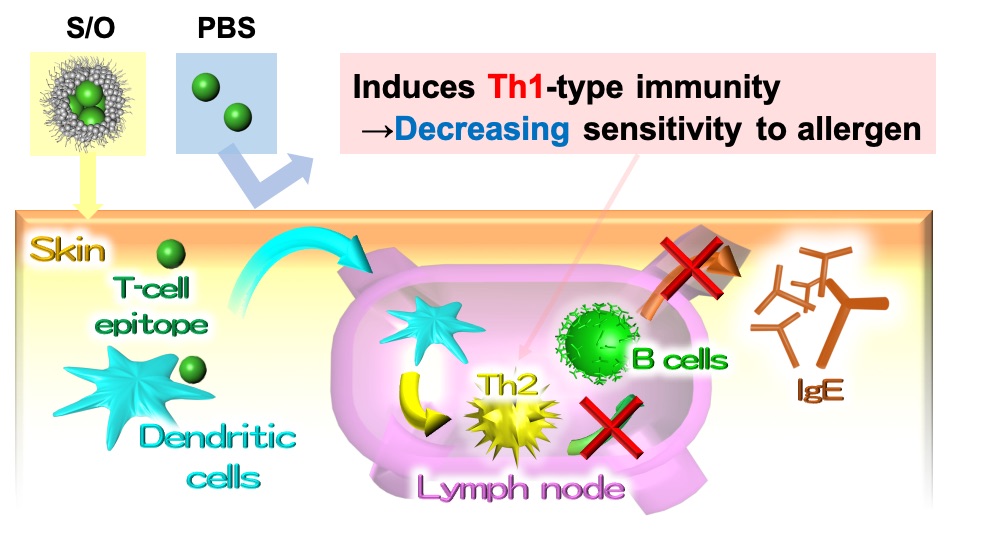
Transdermal drug delivery system (TDDS) is a drug administration method that has attracted attention in terms of safety, convenience, and low invasiveness. However, it is difficult for hydrophilic micromolecular drugs to be delivered into the skin surface since the stratum corneum, which is the outermost layer of the skin, has a hydrophobic barrier function. Therefore, it is effective to use a method of dispersing drugs in an oil base having a transdermal penetration promoting effect, but hydrophilic drugs are not soluble in oil base. In this study, the use of ionic liquids (ILs) to solubilize poorly soluble substances was considered. It is important that ILs are low toxicity and consist of biocompatible materials. So far, choline has been used as a cation in many reports on the application of ILs to TDDS. In this presentation, we synthesized a new biomaterial-based IL using ethyl esterified β-alanine as the cation, and compared with a choline-based IL. In both ILs, oleic acid was used as the anion, which is expected to have high affinity to oil base. We selected ovalbumin epitope peptide as a model drug. The peptide is hydrophilic and was insoluble in oil base, isopropyl myristate (IPM), but the addition of the β-alanine-based IL succeeded in dispersing the peptide in IPM. On the other hand, the peptide is not clearly dispersed in a simple mixture of IPM and choline-based IL. Furthermore, when the permeability of the peptide to pig skin in vitro was evaluated, it was hardly penetrated by the aqueous phosphate buffer solution because of stratum corneum's hydrophobic barrier function, but showed high permeability by the solution dispersed in IPM using β-alanine-based IL. These results suggest that the combination of a new biomaterial-based IL using amino acid as the cation and IPM is a useful strategy for TDDS.
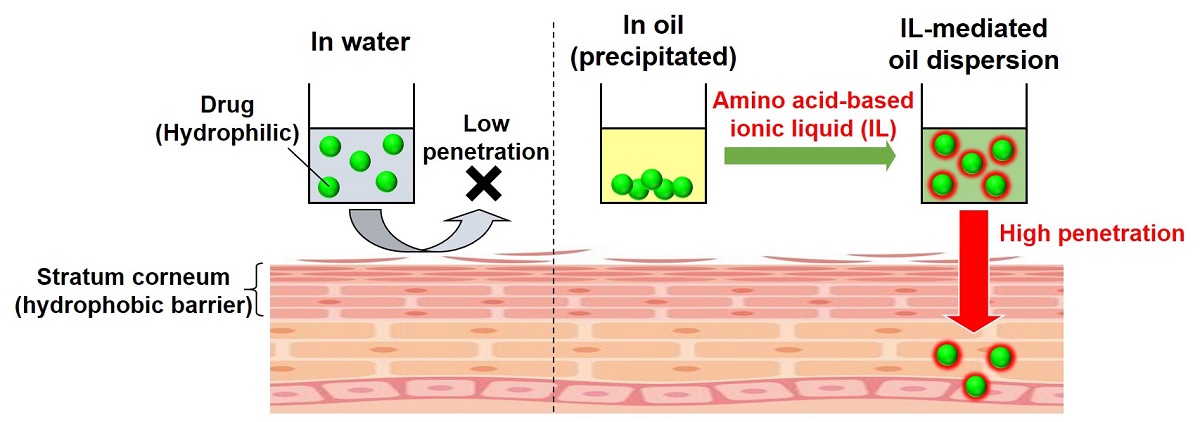
Vaccine is the most effective way to prevent infection by administrating antigen to enhance immunity. Currently, most vaccines are administrated by subcutaneous injection, but it has some problems. Therefore, transcutaneous immunization has attracted attention as a new vaccination method. Transcutaneous immunization is a novel vaccination strategy that delivers antigens to intact skin topically to induce protective immune responses. This needle-free strategy is easy-to-use, safe, and low invasive compared with conventional subcutaneous injection. The starting point of transcutaneous immune mechanism is a capture of antigen by dendritic cells (DCs) in the skin. DCs as a strong immune response inducer, could be expected by the transcutaneous route. However, the skin surface is covered with hydrophobic stratum corneum, which make it difficult to deliver hydrophilic antigens to DCs. To overcome this difficulty, we developed a novel formulation of nano-dispersed solid-in-oil (S/O). The novel S/O formulation can be prepared only by high-speed stirring, and it can contain various additives in large amounts. In this study, we tried to improve the vaccine effect by two approaches of promoting skin permeation and activating immune cells, by adding skin permeation enhancer and adjuvants to the novel S/O formulation.
On the study of antigen uptake by DCs, after 12 hours of vaccine administration to mice, skin cells were analyzed by flow cytometer. As a result, the novel S/O formulation containing skin permeation enhancer and adjuvant significantly increased the antigen delivery rate to the skin DCs, it is 4 times of aqueous solution. In the evaluation of vaccine efficacy, blood antibody level after vaccine administration was measured. As a result, the novel S/O formulation induced antibody production equivalent to injection.
In conclusion, by adding skin permeation enhancer and vaccine adjuvants to the novel S/O formulation, we succeeded the development of transcutaneous vaccine which has an effect comparable to injection.

In recent years, biopharmaceuticals have attracted much attention. This is because they are considered effective for diseases that cannot be treated with conventional small drug molecules. Therefore, there is a need to establish a useful method for administering biopharmaceuticals to patients. At present, administration methods for such biopharmaceutical are limited to injection, because oral administration degrades protein molecules, which are the main active ingredients of pharmaceuticals, by digestive enzymes. On the other hand, injection administration is less convenient because it requires a medical doctor, and it often involves the risk of needle stabbing and pain. In the present study, we aim to establish a simple and safe administration method to replace injection and focus on transdermal administration. For the purpose, we need to overcome the serious problem of transdermal administration, which is a strong barrier of skin surface for transdermal delivery of biomolecules. In this research, we proposed a novel drug carrier called “reverse micelles” for the transdermal drug delivery. Reverse micelles are oil-based molecular assembly, in which various kinds of biomolecules can be entrapped into the water cores. Focusing on the fact that the skin surface is hydrophobic, we thought that the entrapped biomolecules in reverse micelles could permeate into the skin. This reverse micellar method has been used for small molecule drugs so far, however it has not been applied to large biomolecules such as peptides or proteins. In this study, we have developed reverse micelle formulation that enables successful transdermal delivery of biomolecules, and discussed the permeation mechanism by reverse micelles.

In the production of pharmaceuticals, xenoantigens derived from animal cells and animal-derived materials may be present in the final products. These compounds are often problematic and must be identified. Among them, xenoantigen carbohydrates have immunogenic effects and difficult to remove from drugs because they bind to proteins.
Anti-αGal is a natural antibody in humans. Binding of this antibody to αGal antigens (αGal epitope) expressed on porcine xenograft surfaces is a major factor affecting engraft survival. Recently, studies showed that some therapeutic antibodies and cell processing materials used in reproductive medicine contain the αGal epitope. Another major xenoantigen is N-glycolylneuraminic acid (Neu5Gc). An enzyme is responsible for Neu5Gc synthesis; when the gene encoding this enzyme is mutated, humans cannot synthesize Neu5Gc. Humans produce antibodies against Neu5Gc glycan as heterogenous structures, causing the immunogenicity of therapeutic proteins containing Neu5Gc glycan epitopes. Therefore, rapid and robust methods for detecting the αGal epitope and Neu5Gc are required. We chemically synthesized various structure-defined N-glycans including human-type glycans (G0, G2, and SG), uniform isomers (6-G1 and 3-G1) and heterogenic antigens including αGal or Neu5Gc. We also produced high-grade 2-AB-labeled N-glycans. These compounds are suitable for mass spectrometry, capillary electrophoresis, and high-performance liquid chromatography analyses. We simultaneously developed polyclonal antibodies that specifically bind to xenoantigen carbohydrate, αGal, and Neu5Gc using chicken. Some antibodies were modified with fluorescent probes or enzymes for versatile detection.
In this poster, we introduce new methods for detecting xenoantigen carbohydrates in cell culture supernatants or purified antibodies with our reagents. Xenoantigen carbohydrate attached to Fc and/or Fab regions of the antibody can be detected using our methods. We also introduce a method for detecting xenoantigens in the cell culture supernatant in the early stages of cell establishment.
Biological membranes are dynamic and heterogeneous lipid bilayer structures involved in numerous cellular processes, not only as simple boundary but also active uptake of external molecules. A new approach, termed as membrane-lipid therapy, has proved the possibility that some of lipophilic molecules can show therapeutic effect as like drug, by interacting with biomembrane. Therefore, the alteration of lipid membrane properties has been expected to promise a novel and great potential of therapeutic effect. Here, a self-assembled pro-drug system have been investigated, focusing on controlling the self-assembly behavior by surroundings such as pH. Pro-drug structures were inspired from self-assembling fatty acids (FAs). FAs are amphiphilic molecule with hydrophobic carbon chain and hydrophilic carboxyl group, whose phase states strongly depend on pH condition and molecular structure. The aryl carboxylic acids Oxaprozin (Oxa), a main kind of nonsteroidal anti-inflammatory agent, was chosen as model molecule and designed to Oxa-lipid prodrug molecules possessing carboxyl group with different carbon chain length and achieved control of drug self-assembly behavior under different pH conditions. Designed pro-drug molecules achieved the control of drug self-assembly behaviors based on pH condition, which could realize the development of biological microenvironment-sensitive drug delivery system. It can be expected that the variation of self-assembly structure might contribute to enhanced therapeutic efficiency.
Reference: P.V. Escriba et al., Trends Mol. Med., 12, 34 (2016). Han J. et al., J. Phys. Chem. B, 121, 4091 (2017). M. Bucciantini et al., FASEB J., 26, 818 (2012).

Supramolecular polymers based on molecular self-assembly has attracted attention in fabricating bio-functional materials because of design diversity and biomimeticity in structural and functional aspects.[1] Self-assembling peptide amphiphiles (PAs) undergo spontaneous supramolecular assembly in aqueous solutions and have shown a potential in the use in biomedical applications, such as drug delivery carriers. In this study, we developed a novel co-assembly system based on PAs to fabricate a carrier that enables the control of assembled structures. To encapsulate small molecular drugs into PA nanomaterials, we introduced a complementary hydrogen bonding interaction into PAs and drug derivatives. Cyanuric acid (Cya) and melamine (Mel) derivatives are known complementary hydrogen bonding pair, which forms 3:3 network structure called rosette, thus we synthesized Cya-conjugated PAs (Cya-PAs) and Mel-attached model drug (Mel-NBD). To vary the assembled structures to study the influence of the structural aspects on the efficiency in intracellular drug delivery, several hydrophobic substituents of Cya-PAs were introduced; from C0 (Cya-PA1), C6 (Cya-PA2), to C12 (Cya-PA3). When Cya-PAs and Mel-NBD were mixed in a 1:1 molar ratio, they formed distinct nano-assemblies. Interestingly, the morphologies and dimensions of the assemblies were highly dependent on the PA design; i.e. globular objects (~100 nm) were observed with Cya-PA1, whereas fibrous assemblies were obtained with Cya-PA2 (2-300 nm) and Cya-PA3 (> 1 μm). In vitro study on intracellular delivery of Mel-NBD using HeLa cells showed that the cellular internalization efficiency increased in the form of assembly compared with Mel-NBD alone. Moreover, the cellular uptake was differed by the size of the carrier. These results indicate that this co-assembly system provides controllable nanostructures for an efficient delivery of small molecular drugs.
[1] R. Wakabayashi et al., Chem. Commun., 2019, 55, 640–643.
Metabolism and differentiation of culture cells are influenced by changes in cellular morphology, cell-cell and/or cell matrix interactions, and medium components, and so on. To control the destiny of cells, it is important to understand the relationship between these parameters and cell properties. In this study, we focused on the effects of cellular morphology on cell properties. Monolayer culture has been widely used as a conventional culture technique. On the other hand, a spheroid (spherical organoid) culture has been established as typical three-dimensional culture technique. In this study, we investigated the difference of cell proliferation and neuronal differentiation of NT2 cells, model cell of neural research, in the monolayer and spheroid cultures.
For the spheroid culture, we fabricated the microwell chip which consisted of 195 circular microwells (600 μm in diameter) on a poly-methylmethacrylate plate, and the surface was modified with polyethylene glycol to promote spheroid formation. Traditional tissue culture plate was used for monolayer culture. NT2 cells were cultured in a medium containing retinoic acid (RA), an inducer of neural differentiation.
In the monolayer culture, the cells adhered and extended on the plate. In the spheroid culture, the cells were aggregated in each microwell and formed the spheroid within 24 hours of culture, and the spheroid morphology was maintained during culture period. Although RA treatment suppressed the cell proliferation in both culture systems compared to RA non-treatment condition, the cell proliferation ability in monolayer culture was higher than that in spheroid culture. The neuronal differentiation ability of NT2 spheroid culture was higher than that of monolayer culture, and the differentiation ability was dramatically enhanced by RA treatment.
These results indicate that the proliferation and differentiation properties of NT2 cells are influenced by the difference of cell morphology.
Stimuli-responsive drug delivery systems have attracted attention because of their potential to maximize therapeutic effects and minimize side-effects. Recently, authors have developed an amphiphilic short-chain peptide (KHHA7), which consists of a hydrophobic domain based on seven alanine residues and a hydrophilic domain based on a lysine and two histidine residues (KHH), as a dispersant for a poorly water-soluble anticancer drug paclitaxel (Ptx). As the histidine residues form a stable chelate complex with intermediate metal ions such as Cu(II) and Ni(II), the dispersibility of the complex between Ptx and KHHA7 alters in the presence or absence of metal ions. In the present study, two analogs of KHHA7 (KHHA3WA3 and KHHA6W), in which one of the alanine residues in KHHA7 was substituted to a tryptophan residue, were prepared to investigate the effect of substitution on the dispersibility of the complex.
The amphiphilic peptides were chemically synthesized by Fmoc solid-phase synthesis method. The products were purified using HPLC and identified by MALDI TOF-MS. The complex between peptides and Ptx was prepared by mixing an aqueous solution containing the peptides as well as Cu(II) and an ethanol solution of Ptx, followed by removal of ethanol in vacuo and lyophilization. To the complex was added 0.10 mL phosphate buffer solution to evaluate of the apparent solubility of Ptx. When Ptx was complexed with the peptide alone, the dispersibility of Ptx was not significantly different from that of the blank sample. The apparent solubility increased with increasing the concentration of Cu(II). The dispersibility of Ptx complex using KHHA3WA3 and KHHA6W was comparable to that using KHHA7, suggesting that the effect of substitution to tryptophan on the complex stability is small.
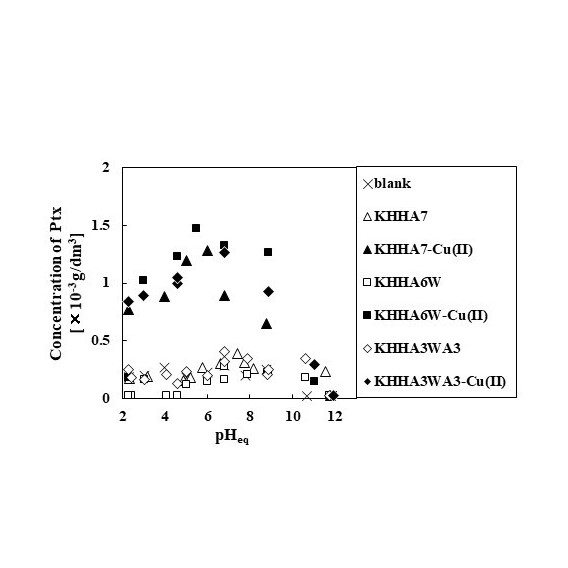
Mesenchymal stem cells including adipose-derived stem cells (ADSCs) are expected as a cell source for tissue engineering and regenerative medicine, because they can be differentiated to osteoblasts, chondrocytes, adipocytes, and so on. 2D monolayer culture that cells are extended on a culture substrate has been widely used as a conventional culture technique. On the other hand, 3D culture, such as spheroid (spherical organoid) and cell-sheet, has attracted attention as a new culture technique. In this study, we investigated the difference of ADSC properties in the monolayer (2D) and spheroid (3D) cultures.
As a spheroid formation platform for 3D culture, we fabricated a microwell which consisted of 195 circular microwells (400μm in diameter) on a poly-methylmethacrylateplate, and the surface was modified by polyethylene glycol to promote the spheroid formation. Traditional tissue culture plate was used as a monolayer culture platform for 2D culture. The cell proliferation and differentiation properties of ADSCs were compared between monolayer and spheroid cultures.
In the 2D culture, the cells adhered and extended on the culture plate, and proliferated during culture period. In the 3D culture, the cells were aggregated in each microwell and formed the spheroid within 6 hours of culture. The spheroid morphology was maintained in each microwell. However, the size of ADSC spheroids was almost same during culture period, and the cell proliferation of spheroid culture was suppressed than that of monolayer culture. The expression levels of differentiation marker genes (osteoblast, chondrocyte, and adipocyte differentiations) in the spheroid culture were higher than those in monolayer culture.
These results indicate that the proliferation and differentiation of ADSCs are influenced by the difference of cell morphology, and the spheroid culture is a promising method to promote the cell differentiation.
In development processes of anti-cancer drugs, cell-based assays have been used as one of drug screening techniques. Generally, monolayer culture of cancer cells has been utilized as in cancer model, but it is difficult to mimic morphology and environments of in vivo neoplasm. On the other hand, cancer cell spheroids, which are formed by the rearrangement and compaction of cell aggregates, have attracted attention as more useful solid cancer model. We have developed a spheroid culture platform, microwell chip, which can achieve size control, easy medium change, and spheroid mass production. In this study, we investigated the difference of drug responses of cancer cells in the monolayer and spheroid cultures.
The microwell chip consisted of 200 circular microwells (600 μm in diameter) on a poly-dimethylsiloxane plate, and the surface was modified by polyethylene glycol to promote the spheroid formation. Traditional tissue culture plate was used as a monolayer culture. HCT116 cells (colorectal cancer cell line) and doxorubicin (anti-cancer drug) were used as the cancer model cell and model drug, respectively. The cells were treated with different doxorubicin concentrations, and the changes in cell morphology and cell survival were evaluated in the both culture platforms.
HCT116 cells formed a single spheroid in each microwell within 3 days of culture. The spheroid growth was inhibited by the doxorubicin treatment, and the collapse phenomenon at outside region of spheroids occurred by the doxorubicin treatment of high concentration. In the monolayer culture, the cells were detached from culture plate with the increase of doxorubicin concentration. The cell survival rate against doxorubicin in spheroid culture was higher than that in monolayer culture, indicating that HCT116 spheroids have high drug resistance than monolayer culture.
These results suggested that spheroid culture has a potential as cell-based assay technique for drug screening.
Hybrid liposomes (HL) composed of L-α-dimyristylphosphatidylcholine (DMPC) and polyoxyethylene (25) dodecyl ether (C12(EO)25) were effective for therapeutics and detection for tumor of orthotopic graft model mouse of breast cancer.
In the therapeutic effects of HL for breast cancer, high inhibitory effects of HL without drugs on the growth of breast cancer (MDA-MB-453) cells were obtained along with apoptosis in vitro. Membrane fluidity of MDA-MB-453 cells treated with HL was significantly increased as compared with that of control and DMPC liposomes. We examined therapeutic effects of HL for orthotopic graft model mice of breast cancer after the inoculation to mammary gland. Reduction of tumor in the group treated with HL was observed, although enlargement of tumor in control and DMPC groups was confirmed on the basis of volume, weight and autopsy. Many apoptotic cells were observed in the tumor section of orthotopic graft model mice of breast cancer treated with HL using TUNEL method.
With regard to detection (diagnosis) on breast cancer using HL, enhanced selective accumulation (diagnosis) of HL/ICG including a fluorescence probe (Indocyanine green; ICG) only toward breast cancer cells having high membrane fluidity without affecting normal breast cells was confirmed in vitro. Enhanced accumulation of HL/ICG into the tumor of orthotopic graft model mice of breast cancer was observed into the tumor of orthotopic graft model mice of breast cancer was observed. These data indicate that HL accumulated in tumor cells in the mammary gland of the orthotopic graft mouse model of breast cancer for a prolonged period of time, and inhibited the growth of MDA-MB-453 cells.
Therapeutic effects by HL and detection (diagnosis) by HL/ICG of cancer with enhanced tumor accumulation for orthotopic graft model mouse of MDA-MB-453 for the use of HL as theranostics agents were revealed for the first time in vivo.
Specific binding on liposome of the trehalose with a high hydration power has been reported. Trehalose liposomes (DMTre) have been produced by using sonication of a mixture of L-α-dimyristoylphosphatidylcholine (DMPC) and α-D-glycopyranosyl-α-D-glucopiranoside monomyristate (TreC14) in buffer solutions with no organic solvent. Inhibitory effects of trehalose liposomes on the growth of tumor cells along with apoptosis have been reported. Growth inhibition against colon, gastric, hepatocellular and leukemia cells has been obtained using trehalose liposomes without drugs.In this study, we investigated inhibitory effects of trehalose liposomes on the proliferation of human breast adenocarcinoma ( MDA-MB-453 ) cells were examined in vitro and in vivo. DMTre with a hydrodynamic diameter less than 100 nm, were preserved for 4 weeks. The inhibitory effects of DMTre on the proliferation of MDA-MB-453 cells accompanied with apoptosis were obtained after the enhancement of accumulation of DMTre into MDA-MB-453 cell membranes. An increase in membrane fluidity of MDA-MB-453 cells treated with DMTre was observed on the basis of fluorescence depolarization method. DMTre suppressed the activity of NFκB. DMTre caused apoptosis for MDA-MB-453 cells through the activation of caspases and mitochondria. Suppression on the filopodia formation of MDA-MB-453 cell by DMTre was observed using confocal laser microscopy. Inhibitory effects of DMTre on the invasion of MDA-MB-453 cells was also obtained using invasion assay. Tumor weights on the xenograft model mice of MDA-MB-453 intravenously administered with DMTre markedly decreased as compared with those of the control group. Brown color indicating apoptotic cells was observed in many tumor cells of tissue section of tumor in xenograft model mice after the treatment with DMTre. DMtre suppressed metastasi in hepatic metastasis mouse model of breast tumor after the intrasplenic inoculation of MDA-MB-453 cells. Therapeutic effect of DMtre were also obtained using hepatic metastasis mouse model of breast tumor.
Among various drug delivery systems, micro/nanocarriers consist of liquid metal are being actively studied. Eutectic Gallium-Indium alloy (EGaIn) liquid metal has been reported to have a low melting point, low toxicity, and proper tissue/cell penetration. EGaIn has a characteristic property, deforming by the control of light and heat irradiations. In this study, we describe transformable liquid metal nanoparticles delivering anti-tumor drug molecules. These “nanotransformer” particles are synthesized through sonication, and extrusion of either EGaIn solution or EGaIn mixed with amphiphilic lipids. The resulting nanotransformers are loaded with an anti-tumor drug, doxorubicin that can be released upon deformation of EGaIn nanoparticles excited with light. The nanotransformer particles showed no toxicity in mammalian cells. A proper photo-thermal ligand added to the nanotransformer helped to increase the yield of deformed liquid metal nanoparticles, resulting in efficient drug delivery.
A phospholipid forms a self-assembled membrane such as micelles, bicelles and vesicles to reduce an exposure of hydrophobic chain groups in aqueous solution. Interestingly, bicelles are disk-shaped aggregates composed of long-chain phospholipids that make up a planar region and either detergent or short-chain phospholipids that compose flanking rims. They have an advantage over micelles in their ability to mimic natural membranes and, therefore, capture membrane proteins in their biologically relevant orientation as demonstrated in structural studies of the transmembrane segment, functional studies of membrane protein and drug delivery system.
Previously, we reported that as “bicelles”, are made of comprise a mixture of long-chained phospholipids (e.g., 1,2-dimyristoyl-sn-glycero-3-phosphocholine, DMPC) and short-chained phospholipids (e.g., 1,2-dihexanoyl-sn-glycero-3-phosphocholine, DHPC) at high concentration in aqueous solution, wherein DHPC detergents cover the rim of DMPC bilayer. In addition, bicelles can be reformed vesicles depend on a various condition such as total lipid concentration and DMPC/DHPC fraction ratios. However, it is very difficult to control of vesicle size by using simple flow microfluidic chip.
In this study, we demonstrate simple method to control the size of vesicles through dilution of bicelles solution by using microfluidic chip which has integrated with passive micromixer and microchannel structure to produce the flow focusing. The results shows that the final production is formed vesicle structure of ordered phase through fusion of bicelles. In addition, we verified the membrane properties with the membrane fluidity (1/P_DPH), polarity (GP340) and optical density (OD500). Our novel microfluidic chip has potentials to create a lipid vesicles which can be controlled size by using total flow rate ratio and DMPC/DHPC fraction ratio.

Quantum dots (QDs) are promising fluorescent probes for many biological applications because they have superior and unique optical properties in comparison to conventional organic dyes. Traditionally, covalent coupling is employed to immobilize or conjugate antibodies onto QD surface for preparation of QD-antibody immunoprobes. In this study, we proposed a simple and effective technique to conjugate CdTe QD with immunoglobulin G (IgG) antibody using high-affinity bifunctional peptides. First, five CdTe QD-binding peptides were obtained from phage display screening. To identify the shortest amino acid sequence needed for the QD-binding activity, the screened peptides were subjected to truncation assay using SPOT-peptide array. Linking the truncated peptides with an antibody Fc domain-binding peptide1 was later done to design mediate bifunctional peptides for bioconjugation of CdTe QD with IgG antibody. The affinities of bifunctional peptides to CdTe QD and IgG antibody were confirmed by surface plasmon resonance (SPR) system. Due to no extensive surface preparation steps and chemicals as covalent conjugations, the designed bifunctional peptides suggest simply and biological-friendly conjugation process of CdTe QD with IgG antibody. Our peptide-mediated molecule conjugation strategy would be beneficial in development of QD and antibody-based molecular imaging.
1Sugita, T. et al. Screening of peptide ligands that bind to the Fc region of IgG using peptide array and its application to affinity purification of antibody. Biochem Eng J. 2013, 79, 33–40.
Engineering of collagen-based hydrogels in microfluidic devices is a promising technology for cell culture experiments with well-controlled environmental parameters. However, it is not a trivial task to integrate microfabricated, cell-encapsulating hydrogels into microfluidic devices. Here we present a new approach to precisely engineering type-I collagen-based hydrogels in microfluidic devices, with the help of gelation agent-incorporating composite silicone substrates. We created microposts composed of polydimethylsiloxane (PDMS) and phosphate salt (Na2HPO4) powders, which work as a neutralizer for acidic collagen solution into collagen hydrogels selectively around the microposts. It was possible to encapsulate living mammalian cells into the hydrogels, which could be extended to perfusion culture of cells for organs-on-a-chip applications.
In the experiments, we fabricated PDMS microfluidic devices equipped with microposts with various morphologies, by soft lithography and replica molding techniques. After introducing an acidic collagen solution into the channel and incubating the solution for several minutes, washing buffer was introduced to remove the non-gelled collagen solution from the channel. As a result, we successfully fabricated collagen hydrogels selectively around the microposts (see the attached figure). Additionally, we were able to create vascular tissue models, when we employed a microchannel whose lumen was completely made of the composite PDMS substrate containing phosphate salt powders. Living mammalian cells could be encapsulated in the hydrogel matrices while keeping high cell viability, showing its applicability to perfusion cell culture. The presented strategy would be highly useful because we could fabricate collagen hydrogel-based microstructures in microfluidic devices without the need for complicated devices or operations.
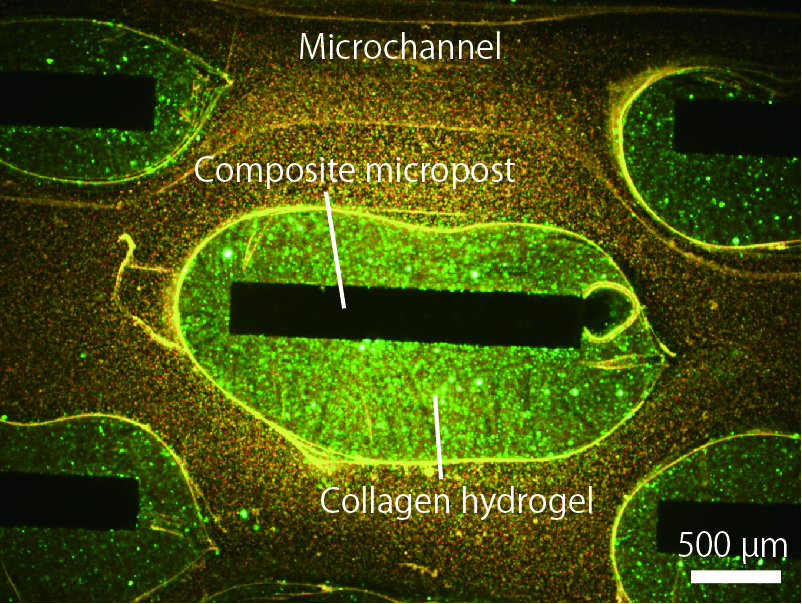
Neonatal hyperbilirubinemia, which is also called neonatal jaundice is a common symptom in the newborn. Bilirubin accumulates in the newborns' blood and high concentration of bilirubin is potentially toxic to the central nervous system, so it's critical to monitor the level of bilirubin. Current bilirubin diagnosis is still based on diazotization reaction and calibrated with the standards using an automated clinical chemistry analyzer to obtain the bilirubin value. The total measuring time is about 30 min. However, most of the diagnosis has to be completed in large hospitals or medical centers due to the costly diagnosis equipment. For those who lives in remote areas or are lack of medical resources, it's impossible to obtain immediate medical diagnosis.
In this work, we combine the advantages of paper-based diagnosis technology, the efficiency of the active separation process, and the aspects of the microfluidic platform to construct a bilirubin diagnosis chip which can measure the values of total, direct and indirect bilirubin. The diagnosis time of bilirubin chip can be controlled within 5 min and the requirement of sample volume is only one drop of the blood. The samples can be quantitatively analyzed by using the bilirubin chip directly and the colorimetric readout which can be obtained through a smartphone camera without using the expensive and bulky equipment. Moreover, we will establish a standard operating procedure for neonatal bilirubin testing and apply it directly to clinical trial. After the comparison of the clinical chemistry analyzer and transcutaneous bilirubin meter, we can establish a real time, easily operate, and precise bilirubin testing system to meet the goal of point-of-care diagnosis.
Mesenchymal stem cells (MSCs) have been ideal candidates for cell therapy because of extensive proliferative ability and stemness. We tried to use nonwoven fabrics (NWF) as a cell culture scaffold. NWF has three-dimensional fiber aggregates formed by heat bonding, which has a high surface area for cell adhesion and elongation. Although NWF have been reported to be a candidate scaffold for large scale expansion of MSCs, quality of cells grown in NWF was not known well. In this report, MSCs grown in a disc scaffold of NWF for 3 weeks showed higher osteogenic differentiation potential and percentage of CD90 positive cells, compared with MSCs grown in a dish bottom surface. Amount of extracellular matrix (ECM) per unit surface area of fibers was larger than that on a bottom surface of dish at first 2 weeks of culture. The osteogenic differentiation potential of the MSC inoculated onto cell-free ECM-coated dish was higher as the amount of ECM increased. Consequently, the higher percentage of CD90 positive cell and higher osteogenic differentiation potential of cells grown in a NWF disc than cells cultured on a dish might at least partly due to the higher amount of ECM.
Keywords: mesenchymal stem cell, nonwoven fabric, ECM, CD90, osteogenic differentiation
Nanostructured multi-phase lipid career (NMLC) is recognized as potential delivery vehicle for sensitive biological compounds. It has been reported that the drug release behavior from NMLC is affected by the type of lipids, emulsifiers and conditions employed for preparation. In this study, multi-phase lipid particles were prepared by hot shear homogenization method with wax and triglyceride mixture. This particulate system is designed to release compounds dissolved in the triglyceride phase by the reaction of intestinal enzyme (i.e. lipase). The carnauba wax, distilled water and coconut oil were homogenized (15,000 rpm, 100°C, 5 seconds) and cooled rapidly at 0°C. Samples with different ratio of coconut oil and wax, addition of emulsifier (i.e. sorbitan monooleate, sodium cholate), and different cooling temperature (i.e. 0°C and 30°C) were prepared. The particle size and surface structure were observed with a scanning electron microscope (SEM). The NMLC dispersion was reacted with simulated intestinal fluid (i.e. lipase, maleic acid buffer (pH 6.5), 37°C). After the reaction, the amounts of the free fatty acids (FFA) produced by the coconut oil were measured by neutralization titration. The particle size of the prepared NMLCs was in the range of 2–100 μm. Formation of the channel of coconut oil could be observed on the surface of the particle. When these NMLCs were applied to the intestinal fluid, FFA were successfully released from the NMLCs. The released amounts of FFA were similar for the samples without emulsifiers. This was because the coconut oil phase exposed on the particle surface did not differ largely among the samples. The amounts of FFA formation were greatly increased in the samples with the emulsifiers. It found that the emulsifier would help the lipase reaction, which accelerates the hydrolysis of coconut oil.
Availability of quartz crystal microbalance (QCM) technique as screening method of drug–loaded ceramic material was examined. Hydroxyapatite {apatite; Ca10(PO4)6(OH)2} was coated on a QCM sensor with wet synthesizing or self-assembled monolayer (SAM)-mediating procedure. Adsorption and desorption behavior of two anticancer reagents: mitoxantrone dihydrochloride (MXT) and doxorubicin hydrochloride (DOX) were followed on the QCM sensor-supported apatite. The 80 μL reagent of 1g/L-distilled water was injected into 8 mL water-containing glass cup where the sensor tip had been immersed. The decreased frequency (ΔFdec) in injection was about 300 for MXT or 500 Hz for DOX, which indicated adsorption of both reagents occurred in agreement with the order of the adsorbed amounts on apatite particle.
After he frequency (F) became constant for about 1 h, phosphate buffered solution (PBS, pH 7) of 100 mmol/L was injected. MXT and DOX showed opposite profiles. For MXT, the F increased in injection, indicating that desorption occurred possibly due to substituting MXT by ions in PBS on the surface. On the contrary, the F for DOX did not increase but did decrease more after the constant F, i.e., adsorption in pseudo-equilibrium. This result was much different from that for apatite particle, in which desorption of DOX was clearly observed in a batch system. Dependency of the injected concentration of PBS (0 – 100 mmol/L) on the ΔFdec was examined. As the concentration increased, the ΔFdec became larger, suggesting that PBS facilitated adsorption of DOX as opposed to MXT.
The Zeta potentials of MXT and DOX were much different: MXT was almost zero while DOX was highly-positively charged: about 23 mV. From these results, we considered that negatively–charged phosphate ion in PBS bound to positively-charged DOX and then less-charged DOX adsorbed on the surface, with possibly weak binding such as van der Waals adsorption.
Vancomycin is the first-line antibacterial agent against methicillin-resistant Staphylococcus aureus (MRSA). Overdose of vancomycin leads to kidney damage, but underdose allows creation of the resistant bacteria. Therefore, therapeutic drug monitoring (TDM) is strongly required for chemotherapy with vancomycin. However most of hospitals outsource the analysis of the drug concentration in blood. It takes 2-3 days to obtain the data of the blood level, but there is no guarantee that the appropriate administration is done during the days. Then, we are developing a real-time vancomycin sensors using molecularly imprinted polymers (MIP). MIP is a synthetic polymer which memorizes structure of a target molecule in its matrix during its synthesis. Although their function resembles antibody but MIP can be obtained more easily and economically because their materials are same as familiar plastics. We are developing a vancomycin sensor by fixing MIP on the indium tin oxide (ITO) electrode surface. We investigated the polymerization conditions and operating conditions and attempted to develop a vancomycin sensor showing high sensitivity even in whole blood. In this study, we investigated the polymerization conditions and attempted to develop a vancomycin sensor showing high sensitivity even in whole blood. The results are shown in Fig. 1. MIP electrode indicates same sensitivity in the whole blood and the buffer solution. However, a large background current was detected in the whole blood sample, which is probably due to coexisting redox species in blood. Thus, we are trying to study the mechanism of the background-current generation and to develop the correction-method of the current.
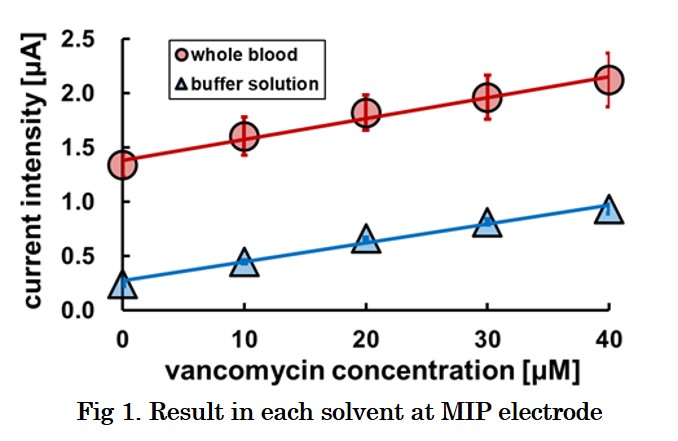
Introduction
A molecularly imprinted polymer (MIP) is a polymer synthesized by molecular imprinting and characterized by binding specifically to a template substance. We are developing sensors using MIPs whose porosity is sensitive to the template specifically. In order to elucidate the mechanism of the sensor, we prepared MIP nanoparticles (MIP-NP) with the feature of increasing the particle size with respect to the template concentration. However presently, the mechanism by which MIP-NP increases the particle size is not known. Therefore, this time, MIP-NP is produced using various templates to elucidate the mechanism of MIP-NP particle size increase.
Experimental Methods
Dopamine or vancomycin were immobilized covalently on the aldehyde introduced surface of glass beads as a template. MIP was synthesized at the surface of glass beads by radical copolymerization of functional monomers and crosslinker shown in Table 1. MIP-NP was obtained by separating the MIP from glass beads surface. Non-imprinted polymer (NIP)-NP was prepared as the reference by the same operation except for omitting the template immobilization on the aldehyde introduced surface of glass beads. The particle diameter was measured by dynamic light scattering (DLS) spectroscopy.
Result and Discussion
The diameter of the particles are shown in Table 1. Each MIP-NP was smaller than respective NIP-NP. And MIP was expanded by the addition of the template, while NIP-NP was insensitive. MIP-NP possesses cavities imprinted by the template in the matrix, while the NIP does not. Those results indicate that the MIP-NP shrinks during the liberation from the template-immobilized surface and expands by rebinding with the template. Analysis of the relation between the size of MIP and the specific interaction with the template would be helpful for design of highly sensitive using MIP.
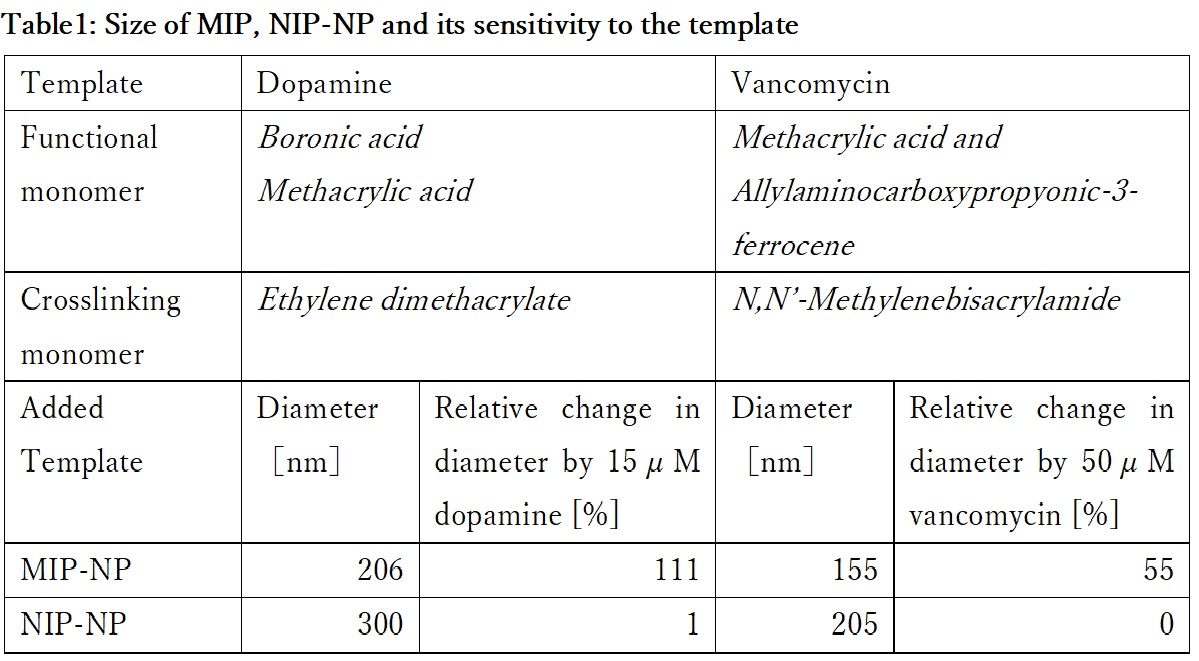
Thin film transistor (TFT) technology has been widely utilized in display, but seldomly been used in biosensing in spite of its priority in relatively high electron-mobility, economic-friendly manufacturing and lower energy consumption. We detected human serum albumin molecules by immobilizing anti-human albumin on dual-ligand modified surface of IGZO (indium gallium zinc oxide)-TFT chips with 400 transistors densely arrayed. AC power was applied on the chips and two neighboring transistors were activated. After recognition and combination, charged antibody-antigen pairs hindered movement of ions in medium between the two transistors due to electrostatic interactions, resulting in the change of permittivity of the dielectric and capacitance. By calculating output current, we could determine the impedance value, which would be reciprocally influenced by capacitance. We have detected the antibody-antigen reaction at the low level of 20 ng/ml for albumin molecules. Furthermore, we have compared 1 × PBS(Phosphate Buffer Solution), 0.1 × PBS(PBS : water = 1:9), 0.01 × PBS(PBS : water = 1:99) and 0.001 × PBS(PBS : water = 1:999) as solvents, where the results show that higher diluted PBS provides larger magnitude of signals for antibody-antigen reactions probably due to lower ion strength. The present IGZO-TFT biosensors is promising for a label-free multiple immunoassays method in the future. In next step, concentration of antigen will be decreased to determine sensitivity of the system and multiple types of antibody-antigen pairs will be immobilized and detected.
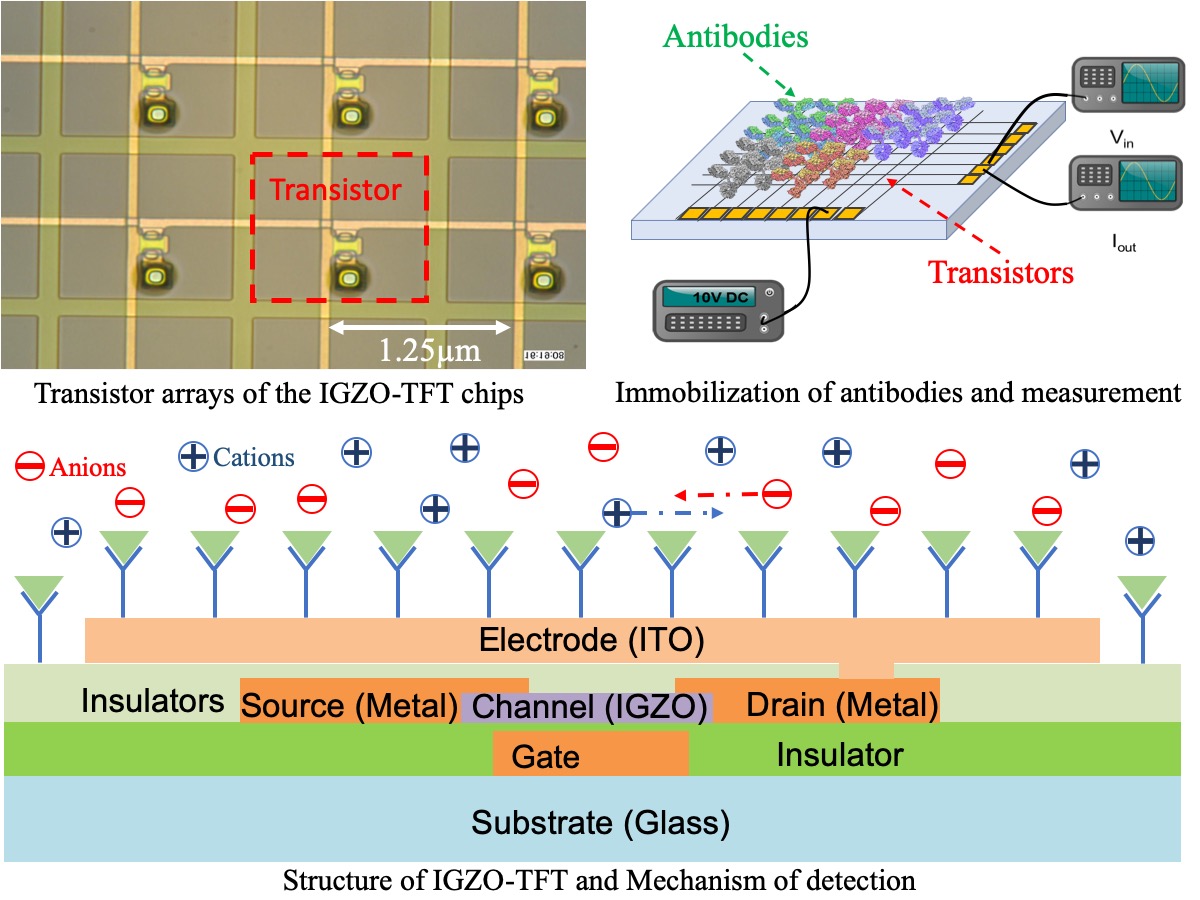
Human mesenchymal stem cells (hMSCs) are multipotent stem cells that can differentiate into mesoderm lineages such as osteocytes, adipocytes, and chondrocytes as well ectoderm (neurocytes) and endoderm lineages (hepatocytes) without generating tumors. The advantages of hMSCs used in cell therapy are their stemness, easy isolation, and no ethical concerns. These make them to serve an ideal candidate for regenerative medicine. However, the differentiated cells should be typically purified by magnetic-activated cell sorting (MACS) or fluorescence-activated cell sorting (FACS). This is laborious and expensive process. In this study, we developed a cell sorting dishes using thermoresponsive polymeric surface for isolation of targeted differentiated cells. hMSCs were differentiated into desired cell lines on the thermoresponsive surface and subsequently the temperature in culture medium was reduced below lower critical solution temperature (LCST), which enables to separate differentiated cells from non-differentiated cells. This method is an easy and economical process to be able to apply into mass production in future. Therefore, the sorting process on thermoresponsive polymeric surface should be crucial for future regenerative medicine application.
In this study, we first developed the establishment method of primary human amniotic fluid stem cells (hAFSCs) and human adipose stem cells (hADSCs) under the xeno-free condition. Subsequently, we designed the culture method of hAFSCs and hADSCs on thermoresponsive polymeric surface coated with poly(N-isopropylacrylamide), PNIPAAm, and several ECMs, such as (1) collagen I (2) fibronectin (3) synthemax II (oligo-vitronectin based substrate) (4) rVN (recombinant-vitronectin). After differentiation of hAFSCs and hADSCs into osteoblasts, we reduced the temperature in culture medium below LCST and detached the cells on the thermoresponsive surface (Fig. 1). We will investigate optimal PNIPAAm-ECM combinations for the differentiation of hAFSCs and hADSCs as well as the effect of cell sorting characteristics, which should be useful for the application in the regenerative medicine.
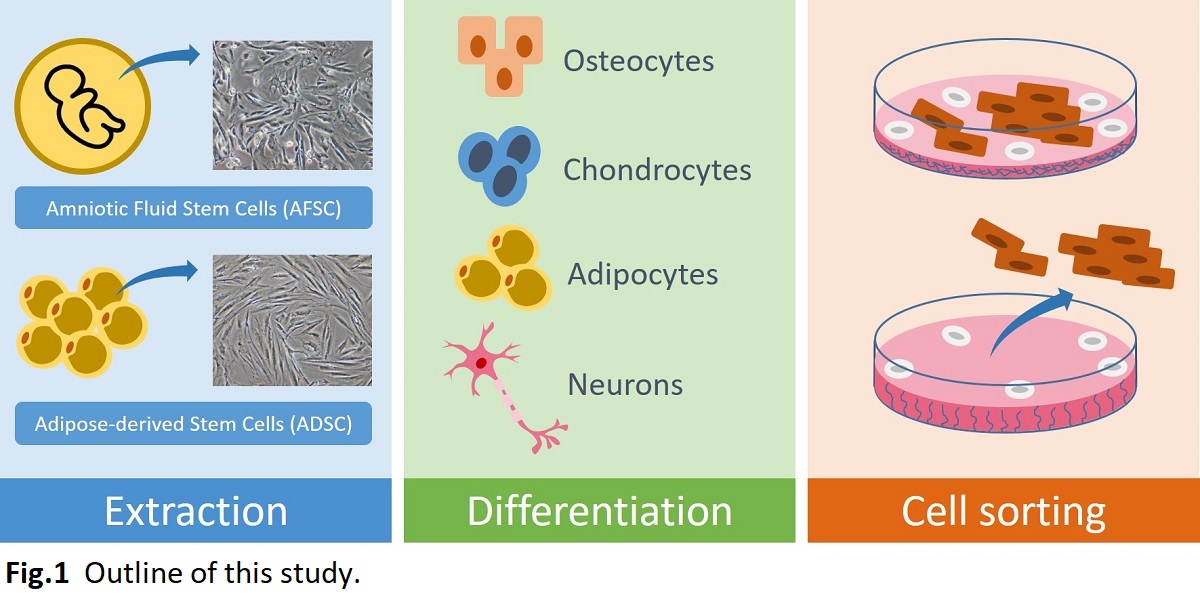
Microporous monoliths have been attracting increasing attention as separation materials due to their structural features. Poly(methyl methacrylate) (PMMA) is a polymer having biocompatibility and is insoluble in lower alcohols while it is soluble in the alcohols containing a small amount of water. Thus, microporous monoliths of PMMA can be made from its solutions in lower alcohols containing water via thermally induced phase separation method. In this study, we prepared composite monoliths of PMMA containing particles of hydroxyapatite (HA), which is one of the biocompatible inorganic materials that adsorbs proteins. The adsorption characteristics of proteins on the monoliths were also evaluated.
PMMA was dissolved in ethanol containing 20% water and HA powders at 70 °C. The polymer solution was then cooled for 1 h in a stainless-steel cup. After cooling, the solidified polymer was taken out and immersed in water to prepare a monolith. Bovine γ-globulin (BGG) and bovine serum albumin (BSA) in sodium phosphate buffer were adsorbed on a disk-shaped monolith in a custom-made holder and desorbed by raising the buffer concentration. The protein concentrations were determined by the bicinchoninic acid method and electrophoresis was performed to examine their adsorption characteristics.
The composite monoliths were successfully prepared by cooling the polymer solution at 0 °C. The dispersion of HA particles was improved by the pretreatment of HA powders with an aqueous solution of a nonionic surfactant Tween 80 before suspending in ethanol. The prepared monolith adsorbs much BGG and slightly BSA in 20 mM phosphate buffer (pH 6.8). The adsorbed BGG on the monolith was eluted with 400 mM phosphate buffer. The electrophoresis showed that BGG was separated from the mixture of BGG and BSA. We also examined adsorption characteristics of protein conjugates on the monolith. This study was partly supported by Kakenhi and Manufacturing Technology Association of Biologics, Japan.
For the improvement and change of the function of protein, the amino acid residues in the protein are selected and they are mutated to appropriate amino acid residues. Error-prone PCR is one of common method to improve and change the function of proteins; however, the identified variant is not always the one with enough function: In the error-prone PCR approach, the residue positions which should be mutated might be identified, but the selected amino acid at each position is not the most appropriate residue at each position. In this study, we combined the saturation mutagenesis with error-prone PCR: positive candidate amino acids at the critical positions identified by error-prone PCR were decided by means of saturation mutagenesis, and a smart-sized synthetic library was prepared to discover the variants with most appropriate function.
Here, we applied this methodology for improve the affinity of anti-human podoplanin antibody, LPMab-16, for rat podoplanin without deactivation against human target. The single chain fragment of variable region (scFv) was prepared from the sequences of humanized LPMab-16 Fv. For improvement of the affinity for rat podoplanin, w the scFv were mutated by means of error-prone PCR positive clones were selected from the variant library by means of phage display method. In the comparison of primary structure between positive and wild-type clones, the positions which should be mutated to promote affinity were determined.
In the secondary step, saturation mutagenesis was independently conducted at each decided position and the affinity of all the variants for both human and rat podoplanins were analyzed to determine amino acid candidates. Small-sized library was generated by conducting simultaneous saturation mutagenesis with the decided amino acid candidates, and the positive clone with 27 times higher affinity for rat podoplanin was able to be identified without deactivation for the binding to human podoplanin.
Polyacrylonitrile (PAN) nanofiber membrane was prepared by electrospinning technique. The PAN membrane used in this work comprises a polyethylene terephthalate (PET) spunbond fabric as a supporting layer with upper and lower PAN nanofiber membrane. After 3 M NaOH and diluted HCl treatments, the weak cationic exchange membrane (i.e., P-COOH) was obtained. The P-COOH membrane was then functionalized with tris(hydroxymethyl)aminomethane as an affinity nanofiber membrane (i.e., P-Tris). In this study, lysozyme was chosen as a model protein. The physical properties of the nanofiber membranes were characterized in terms of fiber diameter, porosity and pore size, specific area of the surface, FTIR and SEM analysis. The adsorption experiments were carried out in a well-mixed system under the various operating conditions (e.g., modification pH, adsorption pH, and the molar ratio of reactants, P-COOH/Tris). The dynamic adsorption characteristics of the P-Tris membranes for lysozyme by membrane chromatography were assessed by measurements of the breakthrough curves. The influences of operating conditions (e.g., adsorption pH, lysozyme concentration, no. of sheet membrane, and flow rate) on the adsorption performance of membrane were investigated in an AKTA prime chromatographic system (GE Healthcare).
Lipid modification of proteins regulates important biological events because the attached lipid moiety activates protein function by affinity to cellular membrane. The lipidated proteins also work for anchoring on drug delivery carriers composed of a lipid bilayer such as liposome. Therefore, protein-lipid conjugate is an effective way to functionalize proteins, and the strategy has attracted attention of researchers in various fields. Herein we focused on cross-linking reaction between specific glutamine (Q) and lysine (K) residues catalyzed by microbial transglutaminase (MTG) to achieve protein-lipid conjugate. Since MTG shows strict substrate recognition and site specificity under mild conditions, it has been demonstrated an effective biocatalyst for labeling proteins with artificial lipid-fused peptide substrates [1, 2]. A recombinant enhanced green fluorescent protein (EGFP) fused with amino acid sequence containing MTG-reactive Q (LLQG) at the C-terminus (abbreviated as EGFP-Q) was expressed in E. Coli. As for K substrate, lipid-fused peptides with MTG-reactive K (lipid-G3S-MRHKGS: abbreviated as lipid-K) were synthesized by Fmoc solid phase synthesis. Prepared EGFP-Q and lipid-K were cross-linked by MTG in homogenous water-phase, and obtained EGFP-lipid after MTG reaction was purified in an established method [2]. Finally, mixing EGFP-lipid and liposomes possessing various charges led to the decoration of liposomes with EGFP-lipid, especially the combination of EGFP-lipid and cationic liposome showed the enhancement of the anchoring ability on cellular membrane.
[1] M. Takahara et al., ACS Appl. Bio Mater., 1, 1823-1829 (2018).
[2] M. Takahara et al., Chem. Eur. J., accepted (2019).

Acinetobacter sp. Tol 5 shows high adhesiveness to various abiotic surfaces from hydrophobic plastics to hydrophilic glass, and stainless steel. This adhesive property is mediated by fiber protein AtaA, which is a member of the trimeric autotransporter adhesin (TAA) family. The adhesive feature of AtaA can be conferred to other non-adhesive Gram-negative bacteria by transformation with ataA gene, and bacterial cells displaying AtaA on their surface can be quickly immobilized onto various types of supports and used as immobilized whole-cell catalysts. While it has been reported that the adhesiveness of Tol 5 through AtaA is nonspecific, material preference of Tol 5 has never been evaluated quantitatively. In this study, we compared the adhesiveness of Tol 5 among various material surfaces. Materials used in this study was polystyrene, glass, stainless steel, and anti-adhesive materials, such as polytetrafluoroethylene (PTFE), Mica, poly (oligo (ethylene glycol) methacrylate) (pOEGMA) brush, and 2-methacryloyloxyethyl phosphorylcholine (MPC) polymer. Bartonella henselae and Yersinia enterocolitica, which adhere to abiotic surfaces through their TAAs, were used as control bacteria. The bacterial cell suspension was applied onto material surfaces. After a certain time incubation, adhered cells were stained with crystal violet and quantified by measurement of the absorbance at 590 nm. Although Tol 5 showed high adhesiveness to most of the materials, the amount of the adhered cells depended on the materials. This result suggests that Tol 5 has material preference for cell adhesion. These findings give us a clue to elucidate the mechanism of the nonspecific, high adhesiveness of AtaA.
Solid-fat microspheres (SFMSs) are micrometer-sized spherical particles consisting of solid fat having a high melting point. They can be utilized for oral delivery of lipophilic bioactive components as well as preparation of powder fats. Generally, SFMSs are produced by solidification of oil droplets in oil-in-water (O/W) emulsions containing solid fats liquefied at high temperature. However, formation of fat crystals on the surface of oil droplets during their cooling process often cause flocculation and partial coalescence, and it results in instability of SFMSs. Therefore, stabilization of SFMSs during their formulation and storage processes is needed to improve food quality and shelf life.
In this study, we tried to stabilize SFMSs by coating with protein and polysaccharide using the electrostatic deposition technique. Monodisperse O/W emulsions containing palm oil droplets as starting materials of SFMSs were prepared by the microchannel (MC) emulsification technique. MC emulsification is a method for preparing highly monodisperse emulsion thus it is useful for finding out the effectiveness of biopolymer coatings on the stability of emulsions and SFMSs. MC emulsification was carried out using silicon MC plates installed to MC module at 65 °C. Sodium caseinate (SC) solution was used as the continuous phase and palm oil was used as the to-be-dispersed phase. Monodisperse O/W emulsions with mean droplet diameters of a few ten micrometers and coefficient of variation lower than 5% were successfully obtained. SFMS dispersions prepared by cooling the O/W emulsion were mixed with chitosan (CHI) solution to obtain SFMSs coated by CHI/SC layer via electrostatic interaction between positively charged CHI and negatively charged SC (Fig. 1). The CHI/SC ratio affected the diameter distribution and stability of SFMSs. During long-term storage at room temperature and heating-cooling treatment process of SFMSs, formation CHI/SC layer showed remarkable stabilizing effect for SFMSs by suppressing “oiling off” and fat crystallization.
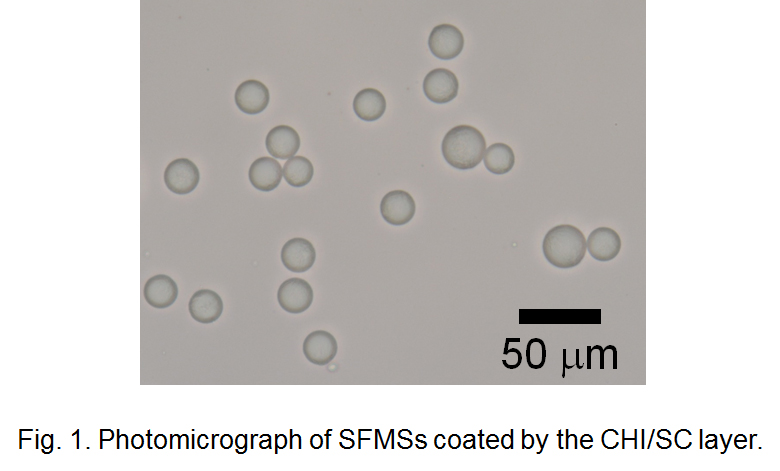
Liquid marble (LM), a self-standing microdroplet covered with hydrophobic polymeric particles, forms discrete space that can control physical and chemical exchange of substances between inner and outer environment. LM has been used as a micro-(bio)reactor because it provides easy-to-handle compartment for biological entities. In this study, we studied cell-free protein synthesis (CFPS) in LM, and the simultaneous hydrogelation of internal aqueous phase was tested to stabilize the whole system. Hereafter, we designated the LM in which the inner aqueous phase is a hydrogel state as hydrogel marble (HM). First, we constructed an LM/HM system by encapsulating the aqueous solution of CFPS components and the hydrogel precursors in LM. It was confirmed that CFPS in LM is possible under appropriate conditions (high humidity and suitable temperature) and enzymatic hydrogelation also proceeds to yield HM. As a result, capturing and immobilizing the cell-free synthesized proteins in hydrogel network was achieved, and by altering the hydrogel components and introducing cysteine residue to the target recombinant protein leaded to the efficient protein immobilization in HM [1]. We then tried to detect the gene after taking out from HM to apply the present system to directed molecular evolution. First, we prepared HMs containing the blank or target plasmid DNA encoding the gene of a target enzyme. Eventually, HMs exhibiting enzymatic activity are visually discriminated by floating HM on a substrate solution. HMs were taken out randomly, and the plasmid DNA coding target enzyme was detected only from the colored HMs. These results suggest the potential of HMs to utilize as a reactor to match genotype in LMs and phenotype in HMs. Quantitative evaluation of enzymatic activity produced by CFPS would be the next target for point-of-care testing and diagnostics.
[1] N. Kamiya, et al., Biotechnol. J., 13, 1800085 (2018).
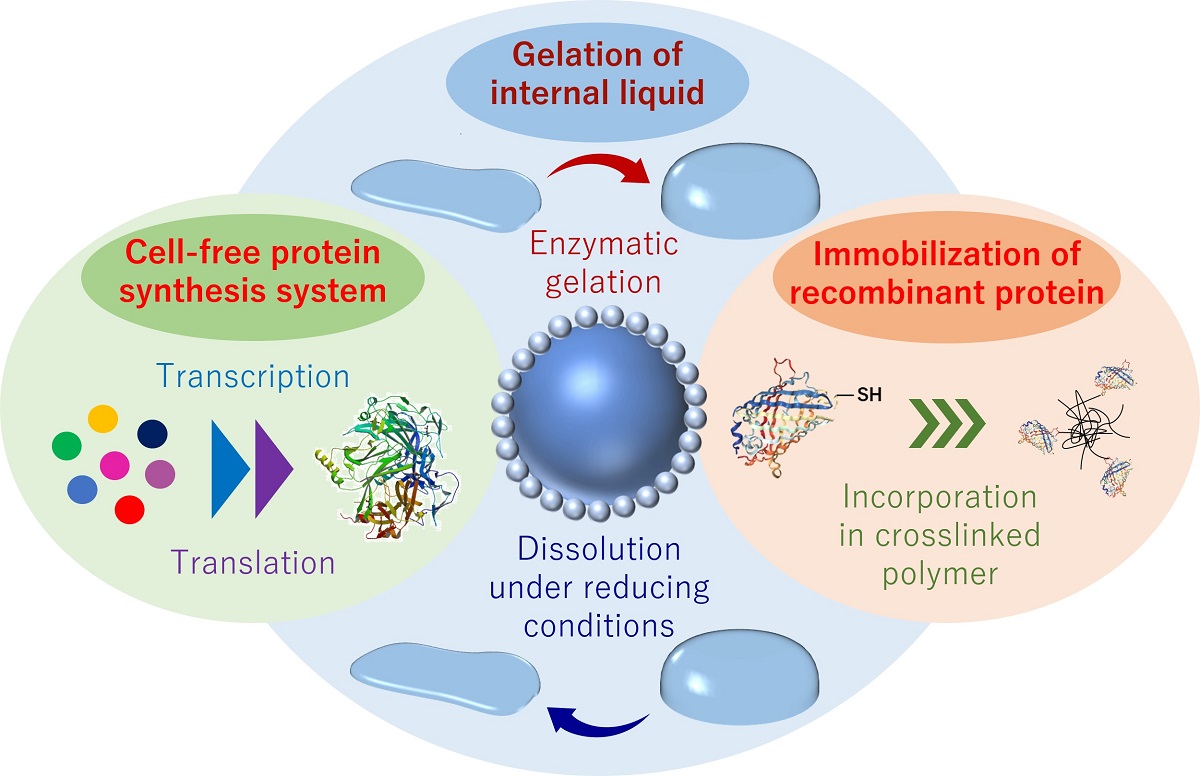
Analysis of the secretion of neurotransmitters in the nervous system is important for elucidating the mechanism of neural network. Then, development of a probe which can track a specified neurotransmitter in real time with high selectivity has been required. Molecularly imprinted polymer (MIP), which is a molecular recognition material obtained by polymerization with a template-effect of the target molecule may be applicable for the probe. In this study, nanoparticle of MIP including fluorescent group (fMIP-NP) were developed as the probe of dopamine secration. The serotonin, as the template, was immobilized on glass beads by using mixed anchor (1:1 in molar ratio) of 3-aminopropyltrimethoxysilane and 3-(2-aminoethylamino) propyltrimethoxysilane with glutaraldehyde. The template-immobilized beads were fluidized in a mixed solution of a fluorescent monomer, a template-affinity monomer, and a crosslinking monomer under UV irradiation. The colloidal fMIP-NP was collected from the surface of the beads by washing with N,N-dimethylformamide. And the dispersion medium of the colloidal fMIP-NP was replaced with 0.15 M phosphate buffer. The fluorescent intensity of the fMIP-NP was increased by addition of dopamine but was insensitive to L-3,4-dihydroxyphenylalanine (L-DOPA) as shown in Fig. The fluorescent nanoparticle prepared without the template was insensitive to both of dopamine and L-DOPA. Those results indicate that the specific interaction between the dopamine and the dopamine-imprinted cavity in the enhances the fluorescent intensity of fMIP-NP. The in vivo concentration of dopamine is said to be several nM. The relative change in the fluorescent intensity of the fMIP-NP is 4.2 % to the dopamine concentration of 15 nM which corresponds to the concentration of dopamine in vivo. Thus, the dopamine secretion in nervous system can be detected by diversion of a fluorescent voltage sensitive dye imaging system (e.g. MiCAM series in Brain Vision Inc.), which can detect relative change of 0.05% in fluorescent intensity.
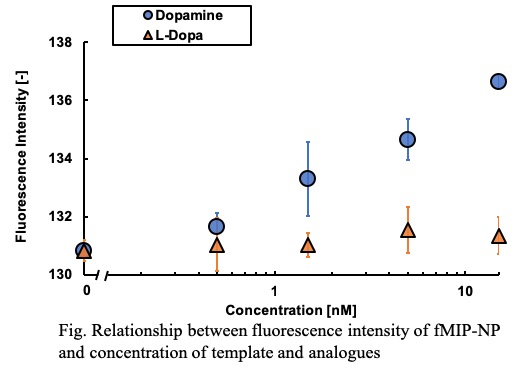
Molecular evolution based on mutagenesis is widely used in protein engineering. Recent advances in genetic engineering allowed us to prepare an extremely large library, beyond the limit of organic synthesis. However, such a large library are often difficult to obtain optimal proteins due to a large sequence space and finally leads to high costs in screening experiments. The success of protein engineering crucially depends on preparing a small library with high enrichment of functional proteins. Here, we propose a novel approach that combines molecular evolution with machine learning. In this approach, we conduct two rounds of mutagenesis where an initial library of protein variants is used to train a machine learning model to guide mutagenesis for the second round library. This enables us to prepare a small library suited for screening experiments with high enrichment of functional proteins. We demonstrated a proof of concept of our approach by altering the reference green fluorescent protein so that its fluorescence is changed into yellow. A small library of GFP variants was generated by means of point saturation and site directed random mutagenesis. Sequence and functional data acquired from the variants in the library were used for training a machine learning model to create the second round library. Mix primer techniques in overlap extension polymerase chain reaction generated the second-round library which consisted of 80 variants proposed by machine learning. The library turned out to contain yellow fluorescent proteins in high number. We successfully obtained a number of proteins showing yellow fluorescence, 12 of which had longer wavelengths than the reference yellow fluorescent protein. These results show the potential of our approach as a powerful method for directed evolution of fluorescent proteins.
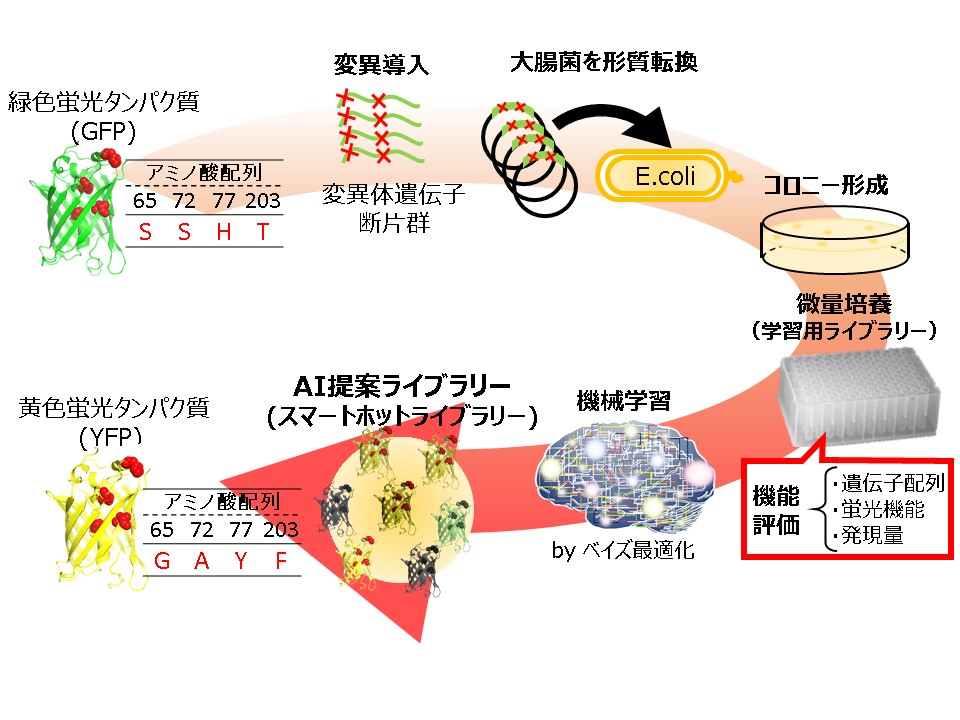
The adsorption of lysozyme on Reactive Gren 19 dye–ligand affinity nanofiber membrane was investigated at 25 °C in a batch system. The effects of operating parameters such as initial pH, immobilization dye concentration, and initial lysozyme concentration on the adsorption were analyzed using Taguchi method. The optimum adsorption conditions were determined as initial pH 7, immobilization dye concentration 3 mg/ml, and initial lysozyme concentration 3.0 mg/ml. At optimum conditions, the adsorption capacity of dye–ligand affinity membrane for lysozyme was found to be 686 mg/g. Based on the optimal conditions, the thermodynamic and kinetic studies were investigated under various operating conditions, such as adsorption pH, lysozyme concentration and temperature. To purify the lysozyme from chicken egg white by using the membrane chromatography, it was to find the optimal purification strategy, including adsorption (e.g., adsorption pH, concentration of CEW, and operating velocity), wash (e.g., liquid velocity) and elution (e.g., type of salt and concentration and liquid velocity) stages. Under the optimal conditions, the results showed that the lysozyme was recovered with a high yield of 98.5% and a high purification factor of 143.3 in a single step.
S-Adenosylmethionine (SAM) is an important methyl donor involved in the methylation of diverse biomolecules, including DNA, amino acids, and secondary metabolites. Although SAM-dependent methyltransferases can become versatile tools for the biocatalytic manufacturing of various useful compounds, SAM-dependent methylation has not yet been industrialized due to the complexity in SAM regeneration. In living cells, SAM is demethylated to S-adenosylhomocysteine (SAH) in association with the methylation of recipient substrates, and subsequently degraded to homocysteine, adenine, and ribose. Homocysteine is then re-methylated to methionine by using another methyl-donor molecule, methyl tetrahydrofolate (THF). Finally, SAM is regenerated by adenylation of methionine with ATP. Although methyl THF can be produced from serine or glycine, carbon sources taken up in the cells are mostly routed into energy production and other biosynthetic pathways, limiting the amount of carbon input which can be utilized for the production of methyl THF and following SAM regeneration.
In this study, we newly designed a SAM-regeneration pathway, in which methanol is used as a source of methyl group, and installed it into Escherichia coli. A heterologously expressed methanol dehydrogenase (MDH) catalyzes NAD+-dependent oxidation of methanol to formaldehyde, which is then spontaneously conjugated with THF to yield methylene THF. An endogenous enzyme in E. coli (methylene THF dehydrogenase) mediates NADH-dependent reduction of methylene THF to methyl THF, which serves as a methyl donor to regenerate methionine from homocysteine. We demonstrated that integration of an methyltransferase into the recombinant E. coli equipped with this pathway allowed methylation of a recipient substrate into its methylated derivative using methanol as a source of methyl group. Moreover, deregulation of SAM biosynthesys and regeneration further enhanced methylation reaction.
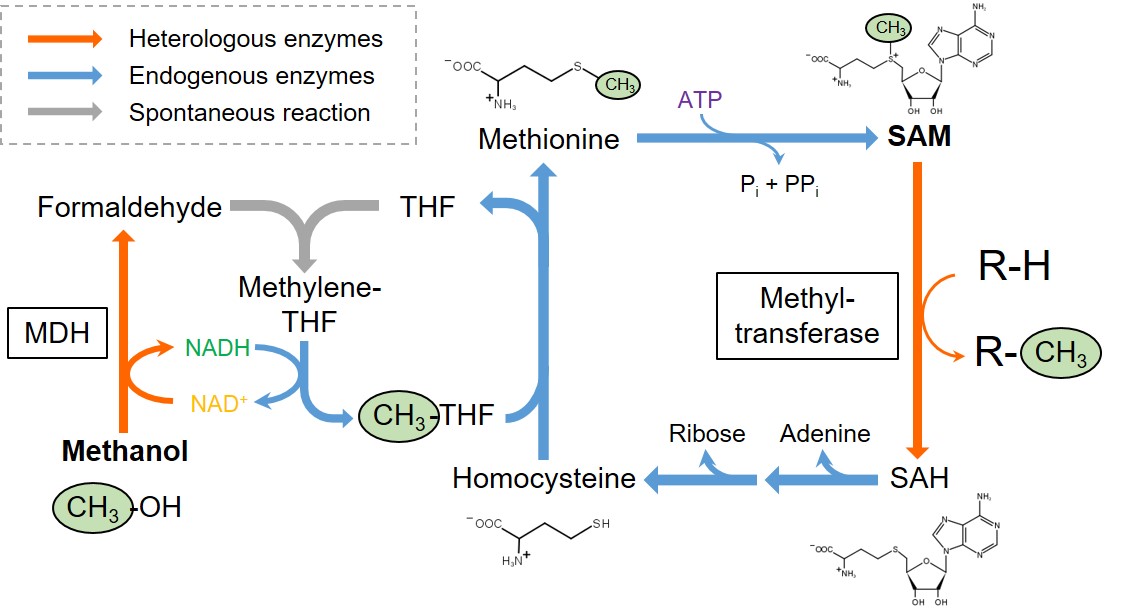
Lipase catalyzes ester hydrolysis under an ordinary temperatures and pressures. In organic solvent, lipase catalyzes ester synthesis and transesterification and lipase has substrate specificity. Lipase is one of important enzyme for industrial application. However, lipase is immediately inactivated in the presence of organic solvent in which the substrate dissolves. Enzyme immobilization is one of solution to improve the stability of enzyme. Yasuda synthesized the amphiphilic macromonomer (2-[p-(1,1,3,3-tetramethylbutyl) phenoxypolyethoxy] ethyl methacrylate, MAX-n, n is the degree of polymerization of the polyethoxy group). Amphiphilic particles obtained by seed copolymerization of MAX-n was a good immobilization support of lipase. In hexane, immobilized lipase on amphiphilic polymer particles had long-term activity and good transesterification activity. However, low immobilization amount of lipase was a problem. In this study, to enhance immobilization amount of lipase, we synthesized amphiphilic polymer micelle of MAX-n and polymer micelle was incorporated into pores of porous particle. The degree of polymerization of the polyethoxy group of n was affected immobilization amount of lipase and stability of lipase in the presence of hexane. When the degree of polymerization of the polyethoxy group was 4.39, the half-life of lipase in hexane was extremely long at 8500 hours.
Krill oil contains huge amount of long chain polyunsaturated fatty acids (PUFAs) such as eicosapentanoic acid (EPA) and docosahexanoic acid (DHA). However, the easily oxidizable characteristics of DHA and EPA make a short shelf life of those compounds. To increase the oxidative stability of EPA and DHA, krill oil was encapsulated in Saccharomyces cerevisiae yeast cells. Rosemary oil (RO), an antioxidant, was added with an amount of 5 wt% of krill oil to reduce the degradation rate of EPA and DHA. The solid content of feed solution was 25 wt%, where the ratio of yeast to krill oil was 2:1. The slurry of yeast, krill oil and water were incubated at 40 °C for 4 h. Non-encapsulated oil was removed by centrifugation and washed with distilled water before spray drying to reduce the surface oil in spray-dried powder. A pilot scale spray dryer (Ohkawara L-8 type) was used to encapsulate krill oil in yeast cells. Four different powders were prepared, where RO was added in two powders and another two powders were without RO. One powder without RO and one powder with RO were washed by hexane after spray drying. Around 0.5 g powders were put in the small vial and placed the powders in drying oven at 50 °C. Thin layer chromatograph with flame ionized detector (TLC-FID) was used to analyze total oil and surface oil content of encapsulated powders. The maximum total oil and surface oil was found around 0.058 g/g-yeast powder and 0.01 g/g-yeast powder, respectively in the powder with RO and hexane washing. The content of EPA and DHA in the powder with RO had higher value than that of powder without RO after the storage of 4 weeks at 50 °C storage.
There are two methods of filleting process of large size frozen fish in the early stages of distribution : a method of cutting thawed fish with a knife and a method of cutting frozen fish with a band saw. The method of cutting thawed fish with the knife has problems in terms of hygiene and freshness. On the other hand, the method of cutting frozen fish with the band saw has problems in terms of safety and yield. We have proposed “cryo-cutting” as a cutting process for frozen fish without using the band saw. Samples were prepared as follows ; a thawed bonito (whole fish body) was cut into a cylindrical shape by knife and re-frozen at a temperature range from -70°C to -40°C. Notched samples was prepared by cutting a V-shaped notch on the back side of the fish sample along the dorsal fin. To try to fillet bonito, a cylinder splitting load was applied to the samples with and without the notch. A wedge-shaped jig was attached to the upper compression plate and pressed into the back side of the sample or into the notch of the samples. As a result, the sample could be split into two parts along the median plane of fish body. By using the jig, it was possible to certainly split into two parts in processing temperature range from -60°C to -40°C. Furthermore, in this temperature range, the load required for splitting could be significantly reduced by 50% and more. The reduction in stress was due to stress concentration at the notch tip. These results have shown the possibility of increasing the cutting accuracy and reducing the cutting stress, by use of the wedge-shaped jig. This study could be a new method for filleting frozen fish.
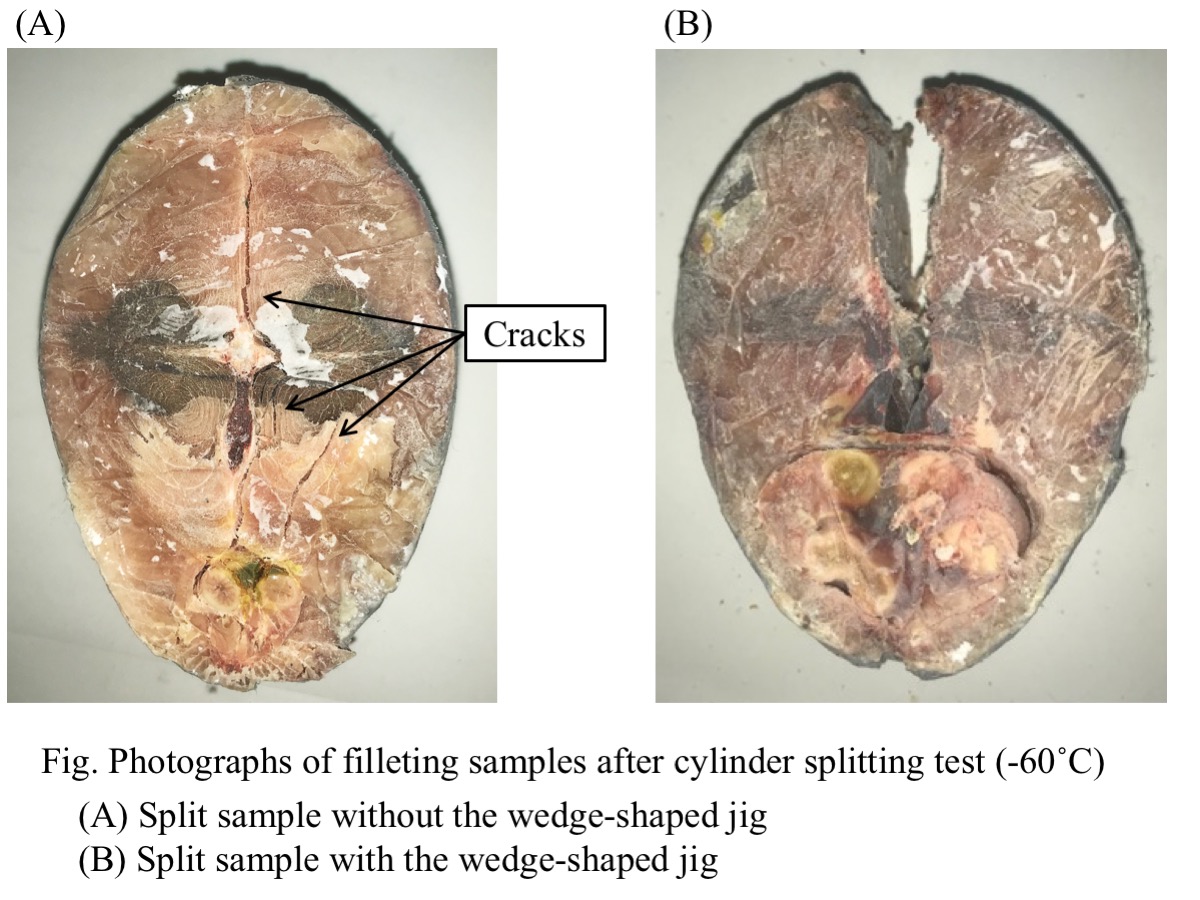
Peptides are heteropolymers composed of amino acid residues linked by peptidic bonds between the carboxyl group of one amino acid residue and the α-amino group of another. They are molecules of paramount importance in several fields, especially in hamaceuticals, health care and nutrition fields.
Peptides are mainly obtained from solid phase peptide synthesis (SPPS) as an established technique. SPPS is a cyclic process with four steps in each cycle: deprotection, washing, coupling, and rewashing. As a result, SPPS is typically performed with long coupling time, large excesses of reagents, and many repetitive washing steps between each steps.
Microfluidic reactors for biomolecule syntheses have many advantages over conventional bulk reactors. Benefiting from minimization of the reaction scale and enlargement of the specific surface area, the microfluidic chemical reactions result in improvement of yields, selectivity, safety and efficiency.
We report our development of flow peptide synthesis in a microchannel. The flow peptide synthesizer consisting of the microchannel with the width of 1mm and depth of 0.2mm on a glass plate and a filter for resin trap. During a coupling reaction, a syringe pump made reciprocating flow of resin beads suspension in the microchannel to restrain aggregation and blockage of resin beads.
Model peptides (Met-enkephalin) were synthesized in a continuous-flow manner. Coupling time of 10 min gave better yields and less side products than that of 40 min with a conventional batch synthesizer. Additionally, two equivalent of amino acid gave good yields similar to four equivalent of amino acid in the conventional batch synthesizer. Therefore, the flow peptide synthesis in a microchannel can contribute to significant reduction of the total coupling time and consumption of amino acid.
High density adsorbent STREAMLINE Direct HST (GE Healthcare) was used to investigate the fluidization and axial liquid mixing characteristics under various operating conditions (e.g., liquid velocity and viscosity and rotational speed) in a specially designed stirred fluidized bed column (SFBC). The results showed that the experimental Richardson-Zaki constant of n is approximately 3.6-4.7, and the experimental terminal velocity of the adsorbent particle is some degree different from the theoretical value (< 20%). Based on the liquid viscosity and density, and adsorbent density and particle diameter, the bed height in the fluidized bed at a desired liquid velocity can be estimated. More experiments were conducted with SFBC for investigating the axial liquid mixing using 5% acetone (v/v) as a tracer and the fluidized bed height was maintained at a constant bed height (i.e., two times settled bed height). The results revealed that the axial liquid mixing was much affected by the liquid velocity and viscosity, and the rotational speed of agitator. As the rotating speed was increased in a higher liquid viscosity, the liquid flow was found to be more stable. Hence, the rotational speed was significantly contributed to the liquid mixing efficiency.
The medical application of cell engineering has attracted a lot of attention. For example, circulating tumor cells (CTCs) separated from blood offer tremendous potential for diagnosis of cancer. The analysis of CTCs is would be useful for progressions of precision medication. In order to attain those medication, it is essential to develop the cell separation technology. Centrifugation, which is based on weight and density, and affinity separation are conventional cell separation method. In addition, cell size and deformability also play a role in cell separation. A novel cell separation method based on size and deformability is worth of development, because it enables the cell separation without rare protein and marker.
In this study, we applied the metal mesh device (MMD, Figure 1.) to the cell separation. MMDs are thin metal films with a through hole structure with precisely controlled pore size. The well defined pore structure of MMD would be appropriate to separate cell based on size and deformability. The aim of this study is achieving cell separation of MMD only with the physical property of cell, and obtaining basic information.
We will report the cell separation of several cell lines with MMD. Since HL60 (floating cell) and HeLa (adhesion cell) cells were reported to have different size and deformability, the cell separation of those cells were conducted with MMD. The permeability of MMDs with different hole size was studied. We carefully observed the cells having high and low permeability, and investigated the relationship between permeability and physical properties.
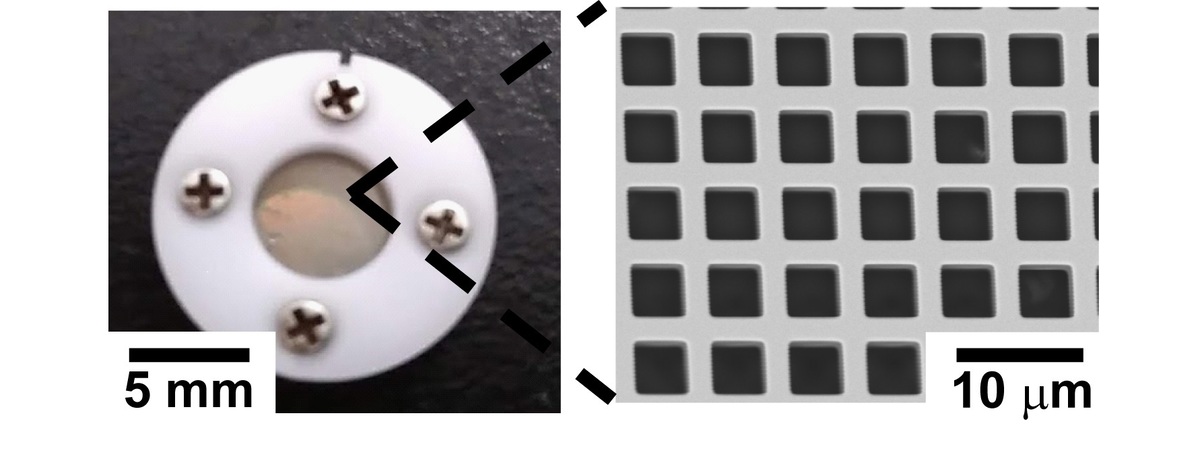
Efficient oxygen supply in bioprocesses is required for aerobic microbes, which demand oxygen as the final electron acceptor in the respiratory chain reaction. In general, compressed air as babbles through a sparger is introduced in a stirring tank reactor. The bubbles sizes are ~ mm of diameters, and stirring paddles collapses and disperses the babbles, and increases oxygen transfer rate. However, the stirring blades often damage the microbial cells, and requires large input powers. To solve the trade-off problem between efficient oxygen supply and cell damages, fine babble sparger (FBS) attempted to apply the microbial cultivation. Here, influence of FBS using on a biosurfactant-, mannosyletythritol lipids (MEL), production by an absolute aerobic fungi, Pseudozyma hubeiensis were investigated. Pseudozyma hubeiensis SY62 was inoculated in 1 L of a MEL-production medium prepared in a 2-L table top bioreactor equipped an alumina porous sparger with 1.3 μm diameter pores (FBS sparger, Noritake Co. Ltd.). Reference cultivation were performed in the equivalent condition except without the alumina porous sparger. Cell growths were measured by a dry cell weight method and the MEL concentrations were determined by a HPLC with an evaporative light scattering detector.
Agitating at 200 rpm, cell growth at the third day with FBS sparger increased to 19.2 g/l, which was higher than that without the sparger (5.7 g/l). Although MEL production were never observed without the sparger, the production reached to 4.7 g/l for three days. However, the significant differences in cell growths between with and without FBS sparger were not observed at 525 rpm. Interestingly, MEL productions for three days with the sparger were induced to 48.9 g/L, which was 1.7 fold larger than that without the sparger. The results indicates that aeration with SPG sparger can achives an efficient oxygen supply without excess stirring.
We have developed polymer particles (g-particle) having grafted polymer chain for adhesive cell culture. To keep adhesive cells on particles surface, a graft chain having both an epoxy group and a hydrophilic carboxyl group is required. This is because the reaction between the epoxy group and the amino group of the extracellular matrix facilitates cell adhesion. The cells grown on g-particle forms three-dimensional matrix in the particles gap and three-dimensional cell matrix has many physiological functions. However, when cell suspension added to g-particle dispersion, the rate of cell growth and adhesion were not high. This was because g-particle moved freely without being dense state in the cell culture dish. In this study, to form and keep a packed state of g-particle by magnetic force, we tried to synthesize a new magnetic g-particle containing paramagnetic Fe3O4 nanoparticles. In suspension polymerization, monomer and hydrophobic modified Fe3O4 nanoparticles were polymerized and the graft polymerization of methacrylic acid and glycidyl methacrylate was carried out. Carboxyl group and epoxy group were introduced as graft polymer chains into the base polymer particles by using pre-incorporated azo groups in polymer particles as an initiator. The number average particle size of magnetic g-particles was 103 μm and they contained 5 wt% of Fe3O4 nanoparticles. They could be gathered by applying an external magnetic force. In addition, the adhesion and growth rates of cells were compared using conventional g-particles and magnetic g-particles. As a result, it was found that cell culture in the presence of magnetic g-particles shows better results.
Blood is one of the most important biological samples. This is not only an analysis target for diagnosis and research but also widely used for treatment. For example, it includes blood transfusion and blood products. Blood contains various blood cells and components that constitute plasma. Separation of these components is one of the most basic operations for its diagnosis, analysis, and utilization.
Conventionally, centrifugation is a general method of blood separation. Centrifugation is based on the specific gravity difference in principle. This is a batch method, thus, processing large amounts of blood requires large devices. In addition, it is possible to separate only target blood cells by using an appropriate centrifugation solution, however, precise separation is difficult.
In this study, we tried that the blood cell separation using a Metal Mesh Device (MMD Fig. 1) with precisely controlled pore size and pore arrangement. The MMD has a nickel mesh structure manufactured by MEMS technology. Therefore, MMD is expected to be applied as a separation membrane, because; it has a large number of through holes accurately designed in the submicron order. It is already reported that the collection and classification of PM2.5 present in the atmosphere using MMD*.
MMD as a separation membrane has an advantageous of blood separation. That is, separation can be achieved using the simple phenomenon of passage/capture when blood is introduced. Blood cells are expected to be separated according to the size and hardness of blood cells by the mesh structure precisely designed on the submicron order. In this study, we reported the blood cell passage rate in the case of using MMD with various pore sizes and evaluated the blood cell passage control by surface PEG modification.
* H.Seto, et al., Chem. Lett., vol. 43, 4, 408-410 (2013)
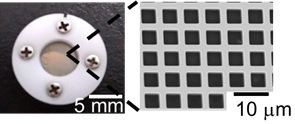
Biopharmaceutical proteins such as therapeutic antibodies are usually produced by recombinant Chinese hamster ovary (CHO) cells. High producer cell lines are screened from transfected cells with random integration of target genes. Since transgene expression is susceptible to the surrounding environment of integrated genomic locus, producer cell lines should be selected from a large number of recombinant cells with heterogeneous transgene insertion. In contrast, targeted integration or site-specific integration into a characterized genomic locus enables more predictable transgene expression and less clonal variability, and hence stable production of target proteins can be expected. Genome editing technology based on programmable nucleases such as TALEN and CRISPR/Cas9 has recently emerged as a versatile tool for precise editing of target locus in the cell genome. Previously, we have demonstrated targeted knock-in of transgenes into the hypoxanthine phosphoribosyltransferase (hprt) locus of CHO cells using TALEN- and CRISPR-mediated precise integration into target chromosome (PITCh) systems [Sakuma et al., Int. J. Mol. Sci., 16, 23849-23866 (2015); Kawabe et al., J. Biosci. Bioeng., 125, 599-605 (2018)]. Here, we attempted to generate targeted knock-in CHO cells based on the homology-independent targeted integration (HITI) system. Transgene cassettes in donor vectors (pHITI/DsRed) were flanked by gRNA recognition sites to eliminate the vector backbone sequences after integration into the cell genome. To evaluate the targeted knock-in efficiency of transgene cassettes, CHO-K1 cells were co-transfected with donor vectors and respective Cas9/gRNA expression vectors. After seeding of transfectants, we counted numbers of colonies showing both drug resistance and DsRed expression. For the established clones, the targeted integration was confirmed by genomic PCR using specific primer sets for joint-regions. The transgene knock-in efficiency into the hprt locus using HITI system was 6.7-fold and 5.0-fold higher compared with those using homologous region (HR) and PITCh systems, respectively.
>Biologics are gaining importance in treatment of diseases, such as cancer, because they are safer alternatives to the conventional treatment. They are mostly produced in bacterial, yeast or mammalian cells. When there is a need for a correct protein folding and posttranslational modifications of biologics, mammalian cell lines are a go-to. Chinese hamster ovary (CHO) cell lines are the dominant mammalian cell lines in production of biologics. They do not propagate human viruses, can grow in suspension cultures, protein folding and modification is human-like and the production of the CHO cells is high.
>The demand for biologics grows. To meet the quantitative demands for the new biologics at sustainable cost, we must further increase the productivity of the CHO cells. Here, we explore the effects of cell cycle inhibitors aphidicolin and caffeine on productivity of CHO cells. We inserted an IgG1-expressing plasmid into a CHO cell lines, which were either treated with aphdicolin or caffeine during transfection, or were not treated in control samples. Aphidicolin treated cells had a 3.5-times higher productivity than control, while caffeine had no effect. While trying to identify the reason for the productivity increase in aphidicolin-treated cells, we noticed that inserted gene copy number or gene expression level remained the same between the aphidicolin treated and control cells. The inserted gene mainly in chromosome 2 in control samples, while in treated samples, the gene was found on many different chromosomes, suggesting that the location of the gene integration might influence the productivity. Because there was no change in gene expression levels between the cell lines, we hypothesize that the difference arises in the downstream steps of protein synthesis. Because the aphidicolin damages the DNA in vicinity of microRNA genes, we further hypothesize that the changes in microRNA expression might contribute to the higher productivity.
The past decade has seen a significant transition from static and passive material to dynamic, bio-based, and stimuli-responsive biomaterials in the cell-seeding technology. Recent advances towards such biologically active hydrogels have been directed to design biomaterials with a superior feature for higher-order cell culture than conventional 2D culture. One obstacle in the fabrication of biologically active hydrogels is to develop in situ crosslinking of gel precursors without impairing bioactive agents to mimic the extracellular matrix condition. Enzymatic crosslinking methods have been suggested as a potential way to introduce external functionality such as sol-gel or gel-sol transition to cell culture scaffolds. Herein, we propose to utilize the horseradish peroxidase-mediated cross-linking that can enable both redox-responsive hydrogel formation of tetra-thiolated PEG via disulfide linkage and incorporation of chemically thiolated materials in the hydrogel. Enzymatic fabrication of redox-responsive hydrogel using different types of gelatin revealed that chemically thiolated gelatin (Gela-SH) and heparin (Hepa-SH) can be co-incorporated into the polymeric network, yielding the dual-functionalized hydrogels. Hepa-SH with different degree of thiol modification was incorporated by considering its optimum binding ability with growth factors and a conflicting property such as the intrinsic anti-proliferative effect. Interestingly, the type of gelatin had a significant effect on the physical and biological aspects of hydrogels; alkaline-treated gelatin (Gela(B)-SH) exhibited superior performance over acid-treated gelatin (Gela(A)-SH) to generate the dual-functionality, cellular adhesiveness and binding ability of growth factor, originating from the two natural biopolymers. Eventually, the Gela(B)-SH/Hepa-SH dual-functionalized PEG-based hydrogel supported both cellular attachment and binding of basic fibroblast growth factor (bFGF) under cell culture conditions, which increased the proliferation (~38%) and phenotype transformation (~89%) of NIH3T3 cells cultured on the hydrogel. This hydrogel system strategy also facilitated faster fibroblast (NIH3T3) and endothelial cell (HUVECs) confluency, which makes it possible to fabricate 2D cellular sheets efficiently.
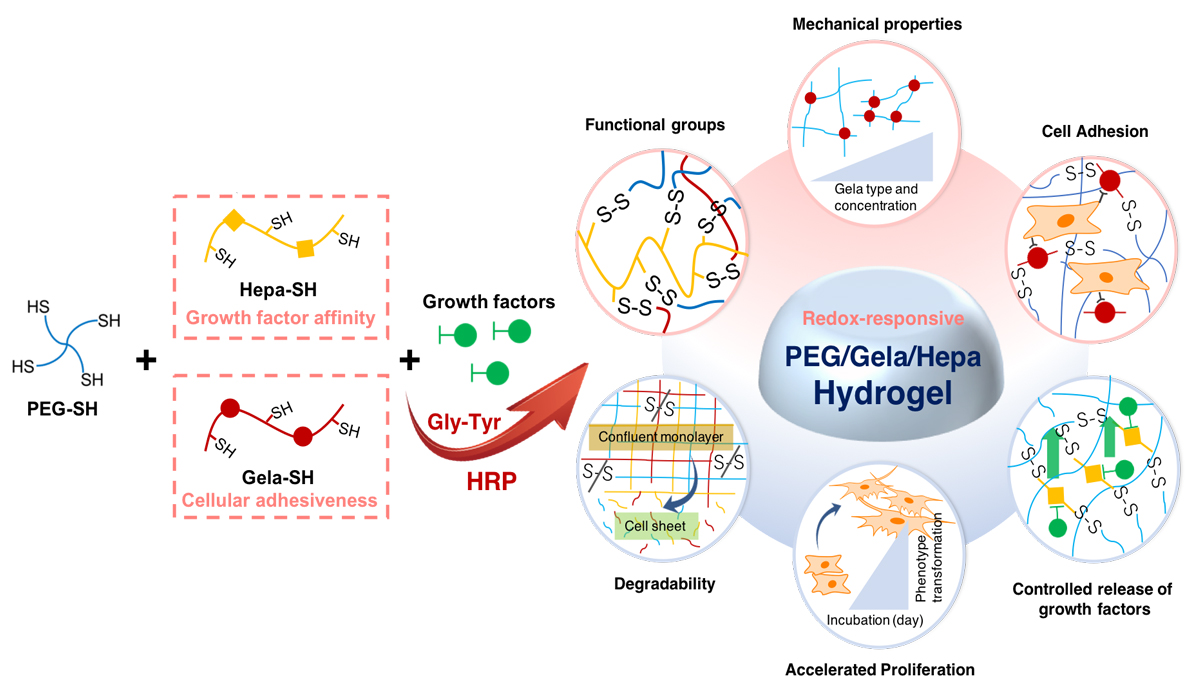
A carotenoid compound β-cryptoxanthin (BCX) is believed to have several functions for human health such as prevention of diabetes mellitus , carcinogenic inhibitory action and immunostimulatory action. However, bioavailability of BCX might be low when orally-administered, due to the extremely low solubility in aqueous media. Emulsification is one of the efficient techniques to obtain highly dispersible formulation for poorly water-soluble ingredients. In the present study, highly dispersible solid formulation containing BCX was prepared by emulsification techniques followed by lyophilization. Kumquat (Fortunella spp.) is a citrus fruit cultivated in Asian countries. BCX was extracted from dry kumquat using the mixture of pyrogallol and ethanol. An O/W emulsion was prepared using an ultrasonic homogenizer by mixing a hexane solution containing the kumquat extract, and an aqueous solution containing sodium caseinate and a sucrose fatty acid ester (L-1695) as an emulsifier. Subsequently, the resulting O/W emulsion was lyophilized to obtain a solid formulation. For the evaluation of the dispersibility, the formulation was added into an sodium phosphate-buffered solution. After filtration of the aqueous mixture using a φ0.80 μm membrane filter, concentration of BCX in the filtrate was determined using HPLC.
Under acidic and neutral conditions, the water-dispersibility of BCX for the solid formulation was much higher than that of kumquat extract alone. Addition of both L-1695 and sodium caseinate was effective to enhance the apparent solubility of BCX under wide pH conditions. Only in the presence sodium caseinate, the dispersibility was very small under weakly acidic condition which is close to isoelectric point for casein. Thus the solid formulation prepared by emulsification techniques was effective to enhance the dispersibility of BCX.
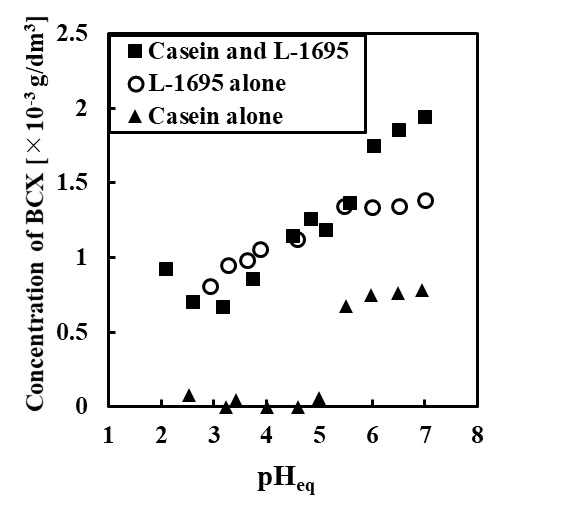
Hepatocytes are a promising cell source for liver tissue engineering and drug screening studies. For the success of such applications, hepatocytes have to maintain liver-specific functions at a high level. Various approaches, such as spheroid (three-dimensional cell aggregate) culture and co-culture, have been adopted to preserve hepatocyte functions in vitro. In this study, we constructed a co-cultured spheroid, which combined hepatocytes with other cells, and evaluated the effects of co-culture on the expression of hepatocyte functions.
As a culture platform for spheroid generation, we fabricated a microwell chip which contained 397 microwells (400 μm in diameter) on a poly-dimethylsiloxane substratum, and its surface was modified with 2-methacryloyloxyethyl phosphorylcholine co-polymer to create the non-adhesive area. In this study, three kinds of cells, primary rat hepatocytes (Hep), mouse fibroblasts (NIH3T3), and human adipose-derived stem cells (ADSC) were used for the spheroid culture, and the spheroid properties were compared in the Hep-spheroid, Hep/3T3-spheroid, and Hep/ADSC-spheroid conditions.
The formation of Hep-spheroid was required approximately 2 days of culture, but the spheroids formation was promoted with the presence of 3T3 cells or ADSCs. Although the 3T3 cells covered the spheroid surface, the ADSCs coagulated in the center of spheroid. Furthermore, almost same spheroid size was maintained in the co-culture conditions during culture period, but the size of Hep-spheroids decreased with the increase of culture time. The albumin secretion ability of co-cultured spheroids (Hep/3T3 or Hep/ADSC-spheroids) was higher than that of mono-cultured spheroid (Hep-spheroid), and especially the function of Hep/3T3-spheroids was highest under all conditions.
These results indicate that the co-cultured spheroids are a promising technique for the maintenance of hepatocyte functions, and the combination of cell species is important factor for modulation of cell functions.
Hydrogel materials have been widely used in tissue engineering and regenerative medicine research. For example, collagen and its derivatives are commonly used as scaffolds to incorporate cells and form 3D complex structures either by molding or 3D printing. However, these structures typically change their form dramatically in cell culture after fabrication due to cell traction forces and/or hydrogel degradation. Here, we propose a 4D (3D+time) tissue engineering approach that incorporates these changes in the design and completes the final structures during cell culture.
We encapsulated NIH 3T3 cells (RIKEN CELL BANK) in type I collagen (3 mg/mL, Nitta Gelatin Inc.) at different cell densities, and monitored the shape change for at least 3 days. Gelatin methacrylate (GelMA) was also used as a hydrogel to encapsulate cells. GelMA has emerged as a preferable hydrogel material in tissue engineering, especially for the applications of 3D bioprinting due to its photocrosslinkable and biocompatible features. By varying the UV crosslinking conditions (e.g. UV intensity and time) and GelMA concentration, as well as cell density, we observed different degrees of hydrogel shape changing during cell culture. We then fabricated bi-layer structures using two components with different shape changing properties. The bi-layer strips curved towards the side which had higher shrinking ratio (or lower swelling ratio). Their curling ratio was recorded and calculated. Furthermore, to demonstrate the capability of this 4D tissue engineering approach, we fabricated a bi-layer structure consisting 6 flower pedals, using collagen hydrogel with and without cells as the inner and outer layers, respectively. We observed the structure to form a flower shape by “closing” its pedals during the 3 days of culture.
In summary, our 4D tissue engineering approach can be employed to form designed structure after fabrication, and will be further explored for use of 3D bioprinting.
Chinese Hamster Ovary (CHO) cells are widely used as host cells in antibody production. The antibody production process has to aim towards high productivity and/or high titer, low operation costs and short production time. To improve productivity, cell flocculation can be applied in cell removal and/or cell culture processes to decrease impurity and turbidity. Calcium chloride is one of the cell flocculants that was studied and optimized for application [1,2]. In addition, low concentration calcium chloride is also being used as supplement in culture medium. In this study, we investigated that calcium chloride addition improved product titer, and decreased turbidity and impurities of cell culture supernatant after cell flocculation.
IgG-producing CHO-HcD6 cells were cultured as batch cultures using serum-free medium supplemented with calcium chloride at the beginning of the cultivation with 6 different concentrations (0.5, 1, 2, 5, 15 and 60 mM). Samples were recovered at the end of batch cultivation until cell viability dropped under 60 %. Cell and IgG1 concentrations during cultivation were analyzed using Vi-cell cell counter and ELISA, respectively. Dipotassium hydrogen phosphate was added at the end of cultivation, and the cells were removed from supernatants by centrifugation. Supernatants were collected for IgG1 concentration, turbidity (OD600) and host cell proteins measurements by CHO Host Cell Protein ELISA kit (Cygnus). Highest IgG1 concentration was 263 mg/L in 2 mM CaCl2. In addition, the turbidity of supernatant after centrifugation was decreased 28.2 % compared to control (without addition).
References:
[1] Chen et al., Bioprocess Biosys. Eng., 40:703–714 (2017).
[2] Burgstaller et al., J. Chem. Tech. Biotechnol., 93:1881-1890 (2018).
For medical biodegradable polyester materials to be used for soft tissue, they must be made in nonwoven or mesh form. There are many ways to make it into nonwoven form, but in order to be used for medical use, it should be a process that does not use chemical additives in manufacturing process and can produce small quantity.
In this study, various processes for the preparation of nonwoven fabrics for soft tissues were studied using biodegradable poly glycolic acid (PGA) and poly lactic-co-glycolic acid (PLGA). The web was well formed in the needle punching process. However, since the strength of the nonwoven fabric is weak and the loss of the process is large, it is considered unsuitable for medical use. The melt blown process was difficult when setting the spinning temperature during manufacture, but it was possible to produce thin, low weight nonwoven fabrics. The flat knitting process is capable of producing meshes with a small amount of 100 ~ 200g of yarn and is suitable for applying expensive biodegradable materials with little loss. In the case of the mesh fabricated by the flat knitting process, it is expected that it can be applied to the part where stretchability is needed in the future because of its excellent stretchability. Circular knitting can produce meshes with a small amount of yarn, and can be manufactured in a thin and light form, but has a disadvantage of curling the cutting portion at the time of cutting. In order to improve the morphological stability, the heat treatment process was introduced and the curling phenomenon was improved and the physical properties were also improved. We have provided a base for manufacturing nonwoven fabrics and meshes for soft tissues that can be used variously according to therapeutic purposes by using medical biodegradable polyester material.
Cataract is caused by the aggregation of crystallin proteins in lens cells of the eye, leading to light scattering and vision impairment. Cataract is known as one of the leading causes of blindness worldwide. Deposition of human γD-crystallin (HGDC), which is a major protein in eye lens, has been linked to cataract. In this study, we used the nuclear magnetic resonance (NMR) spectroscopy in combination with equilibrium chemical unfolding to investigate the structural stability of HGDC. The relatively unstable regions of HGDC were identified by comparing the residual dipolar couplings (RDCs) of HGDC in the environments without and with 5 M urea. Our results suggested that the structure of HGDC is relatively unstable in the regions including residues L92, Q113-R115, and D150-Y151. The structure of HGDC obtained by GeNMR online server was further refined using both residual dipolar couplings results and torsion angles derived from the chemical shift data. Comparison of the structures obtained from different conditions indicated that, relative to its N-domain counterpart, the C-domain of HGDC was more significantly affected by urea. Biophysical characterization of the mutants, which will be obtained by point mutation of the above suggested unstable regions, will be needed for verification.
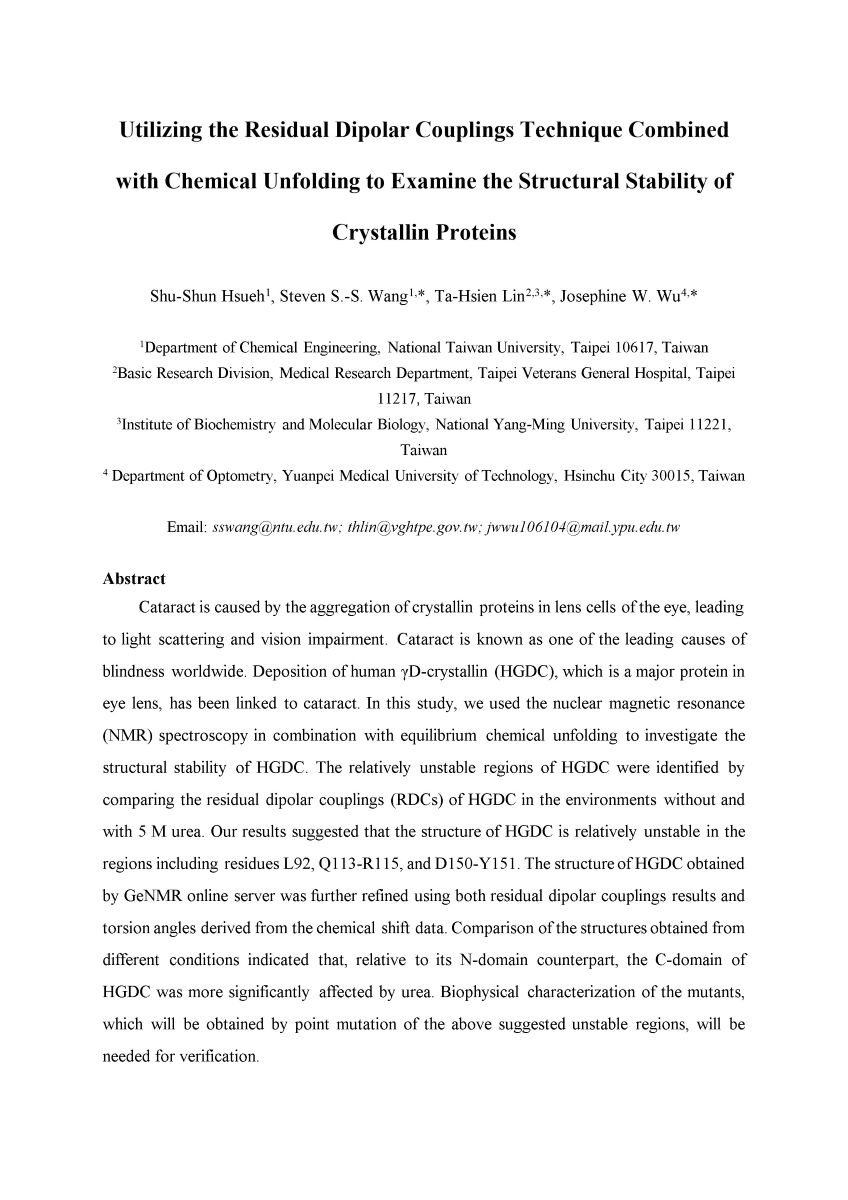
Chinese Hamster Ovary (CHO) cells are the most commonly used host cell for the production of recombinant therapeutic proteins. In the endoplasmic reticulum (ER) of mammalian cells, ER chaperones are responsible for the folding and assembly of secretory proteins. Soluble ER chaperones have a KDEL (Lys-Asp-Glu-Leu) motif at their C-terminus that is recognized by KDEL receptors. Mammalian KDEL receptors are a family of three members that function to ensure the retrieval of ER chaperones from post ER-compartments back to the ER. In this study, we induced ER stress in CHO cells to investigate its effect on the gene expression level of KDEL receptors and soluble ER chaperones, and whether or not this response is correlated. We also hypothesize that overexpression of KDELR1 could increase the rate of retention of chaperones to the ER; therefore, increase the abundance of chaperones in ER and enhance protein folding and assembly.
The target molecules are the three KDEL receptors [KDELR1, KDELR2 and KDELR3] and KDEL chaperones [Binding immunoglobulin protein (BiP), Calreticulin, endoplasmin (GRP94), and Protein disulfide isomerase (PDI A1)]. KDEL receptors' and KDEL chaperones' gene expression during ER stress induction by tunicamycin were analyzed using Real-Time-PCR (RT-qPCR), KDEL receptors showed less than 2 fold-increase in expression level during ER stress. On the other hand, KDEL chaperones showed several fold increase. This uncorrelated upregulation proposes a possibility of the saturation of ER retention machinery (KDEL receptors), or at least hindered retention of ER chaperones under stress conditions. Recombinant stable overexpression of PDI showed increased extracellular secretion of PDI to the extracellular culture medium, indicating the saturation of ER retention machinery in CHO cells. The stable over-expression of Kdelr1 in recombinant IgG1 producing CHO cells improved IgG1 specific productivity.
Cardiac tissue engineering is an emerging field that holds great promise towards the development of innovative treatment strategies for heart disease. Nanofibrus scaffold act as a 2D surface, due to the lack of cell infiltration and hydrogels, which possess a 3D environment, suffer from lack of good mechanical properties. Therefore, by combining these two types of scaffolds, it would be possible to attain a desired 3D environment with good mechanical properties.
In this study, nanofiber-reinforced composite hydrogels were fabricated by incorporating poly (ε-caprolactone) (PCL)/gelatin nanofibers into chitosan (CS)/heart extracellular matrix (ECM) hydrogels.
To fabricate PCL/gelatin nanofibers, the dual electrospinning technique was used. To fabricate CS/ECM hydrogel, the decellularized heart tissue using appropriate combination of detergents was mixed with CS. After preparing solubilized ECM and CS solution, they were mixed in certain quantities together with specified amount of glutaraldehyde as crosslinker. Then the prepared (PCL)/gelatin nanofibers with specified size were put on the homogeneous hydrogel solution and let the hydrogel solution to penetrate into the nanofibers.
Fourier transform infrared spectroscopy (FTIR) spectra show evidence of intermolecular interactions between the CS and ECM in hydrogel.
To evaluate the physical characteristics of the fabricated nanofibers, scanning electron microscopy (SEM) and contact angle analysis were performed. The mechanical properties of the nanofiber-reinforced composite hydrogels were evaluated using Uniaxial tensile teste and the results indicated that the moduli of the nanofiber-reinforced hydrogels were remarkably higher than those of hydrogel alone. The tensile test results indicate that by varying the ratio of both hydrogel and nanofibers components, moduli between 1 to 3 Kpa and 5 to 100 Mpa could be achieved, respectively. By similar test, the native heart modulus was measured to be about 31 Kpa. By incorporating electrospun PCL/gelatin:CS/ECM (the ratio of 2:1), satisfactory mechanical properties close to that of native heart tissue were obtained.
Achieving precise manipulation of stem cell self-renewal and differentiation behaviors will maximize the potential benefits of stem cell therapy. Here, the multifunctional concept of using robust and chemically defined modifications to support stem cell culture is demonstrated to provide synergistic coupling with concurrently immobilized FGF-2 and chitosan, and the resulting cell culture matrix/interface enables the proliferation of spheroids of human adipose-derived stem cells (ADSCs) with augmented stemness in the form of self-renewal and enhanced (trans-)differentiation potential for diversified cell lineages in the mesoderm, endoderm and ectoderm. The modification and the co-immobilization are performed using a straightforward one-step vapor-based coating technology applicable to a wide range of cell culture materials. The concurrent immobilization of FGF-2 and chitosan revealed an important prospective for designing a material interface that confirms that effective and sustainable factors to determine stem cell fate are obtainable using a facile multicomponent modification approach on culture substrates.

Introduction
The safe and convenient yeast Saccharomyces cerevisiae is widely studied for the production of chemicals. D-Lactic acid is used as one of the biodegradable plastic materials. D-Lactic acid production by the engineered microorganisms often requires neutralization of the culture medium and the addition of neutralization reagents, which increase the cost of D-lactic acid production considerably. Previously, we developed a method improving various tolerances such as thermotolerance of yeast through CRISPR-Cas mediated genome evolution. In this study, a lactic acid tolerant yeast was constructed by this method and the resultant yeast was metabolically engineered to obtain a yeast producing D-lactic acid.
Method
First, we constructed a mutant library of lactic acid tolerant yeast by genome evolution method and screened a lactic acid tolerant yeast. Secondly, we integrated glycolytic enzyme genes and D-ldh (from Leuconostoc mesenteroides) into genome DNA of the lactic acid tolerant yeast to modify the expression of these genes. Then, the best strain producing D-lactic acid was screened from the transformants. Finally, we cultured the resultant strain in a non-neutralizing condition, and its fermentation ability and transcription levels of glycolytic enzyme genes and D-ldh were investigated.
Result
We selected δpHδLA2-51 as a lactic acid tolerant yeast, which could grow on YPD+60 g/L lactic acid medium. Engineered strain δ2-51/dP_36, which was constructed by modifying the expression of the glycolytic enzyme genes and D-ldh in δpHδLA2-51, produced D-lactic acid in a yield of 0.30 g/g-glucose in non-neutralizing condition. In the log phase, δ2-51/dP_36 showed higher transcription levels of 9 glycolytic enzyme genes and D-ldh compare to control strain δpHδLA2-51/dP/H.
Acknowledgements
This work was partly supported by JSPS KAKENHI (grant number JP18K14069 and JP18KK0413).
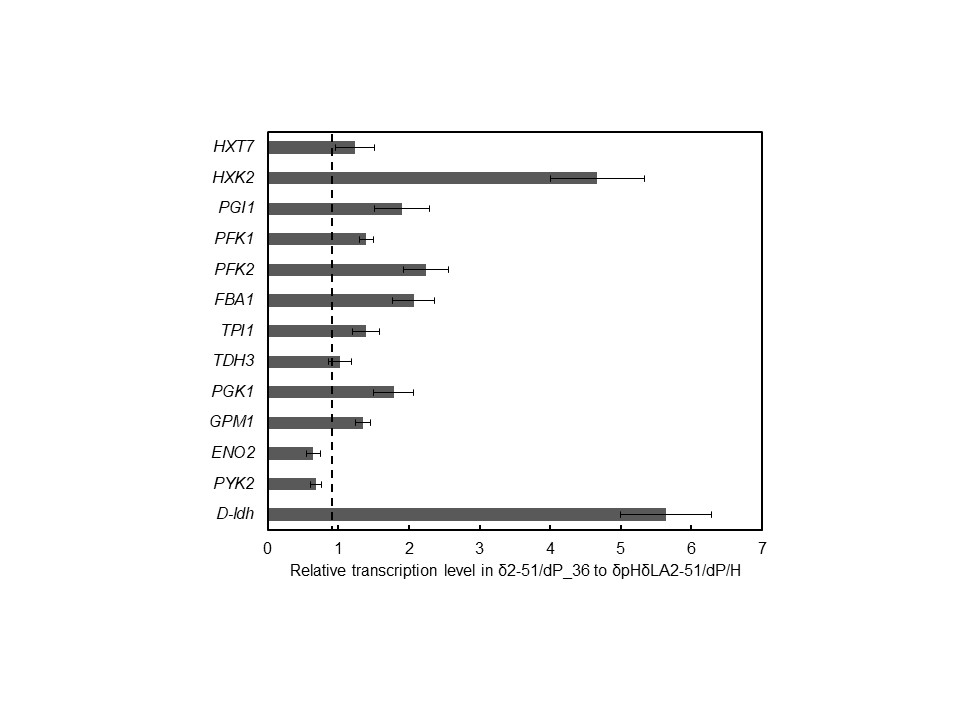
Biodiesel fuel is monoalkyl esters of long-chain fatty acids, which is synthesized by bio-based oils and alcohols as alternatives for fossil fuels. Biodiesel fuel production is usually catalyzed by an alkali catalyst. The use of an enzymatic catalyst allows the use low-grade oil feedstock containing a high percentage of free fatty acids, easy recovery of glycerol, mild reaction conditions, and reduced wastewater. However, an obstacle of enzymatic methanolysis is the limited stability of lipases in the presence of methanol. Therefore, in this study, we improved the stability of the lipase from Thermomyces lanuginosus DSM 10635 in methanol by using protein engineering methods1). The plasmid pE_TLLHis6N, which was constructed by cloning the lipase from T. lanuginosus DSM 10635, was used for producing the wild-type lipase and as a template for constructing site-specific mutant lipases. Escherichia coli BL21 (DE3) cells transformed with the pE_TLLHis6N plasmid (or its derivatives) were cultured in LB liquid media containing 50 mg/L ampicillin sodium salt. The protein expression was induced by the addition of isopropyl-β-D-1-thiogalactopyranoside (IPTG). The proteins were purified by using HisTrap column. The purified enzyme solutions were incubated in the presence of 50% (v/v) methanol at 40°C and the remaining activity was measured. Figure shows the time courses of the remaining activity of the wild-type and mutated lipases in the presence of methanol. Deactivations of the wild-type and mutated lipases obeyed first order kinetics for 0.5~2.0 h. The half-lives of three mutated lipases (A28S, A163D and F174Y) were longer than those of the wild-type lipase. In particular, the half-lives of the A28S were observed to be 6.5 times longer than those of the wild-type lipase. The half-lives of three mutated lipases (A28S, A163D and F174Y) were successfully improved by using protein engineering methods.

Many useful compounds such as, fuel alcohols, plastic and polymer materials, have been produced via the metabolism in microbial cell factories. In order to improve the conversion rate from substrate to the desirable target, it is required to identify and eliminate a rate limiting reaction in the pathway. Specific enzyme activity (Vmax), the parameter representing the maximum reaction rate, is one of the important clues for identifying the rate-limiting reaction. By comparing the Vmax value with actual metabolic flux for each reaction, it should be possible to identify a rate-limiting reaction in the pathway. However, because conventional method for measuring Vmax requires different assay protocols for each enzyme, it was time consuming to investigate multiple enzymes. In this study, we developed a method to simultaneously measure the Vmax values of multiple enzymes in a pathway using a kinetic model with a time course of the intermediate metabolite concentration in vitro experiment. To test the proof of concept, we estimated Vmax values for 9 glycolytic enzymes in Escherichia coli using a previously reported kinetic model and a hypothetical time course data which was generated from a simulation using the model with an arbitrary Vmax set. The parameters of Vmax were optimized to fit the experimental time-series data of the intermediate metabolites. As a result, we successfully estimated the initially set Vmax values. Here we demonstrated the Vmax values estimation using a crude cell extract obtained from wild type E. coli cells. In vitro reaction experiment was performed using the crude cell extract with addition of glucose and essential cofactors. After starting reaction, a sample was collected at every 10 minute and was analyzed with a liquid chromatography tandem mass spectrometry to obtain the time series of intermediate metabolites. In the poster presentation, we would like to discuss more specific research contents.
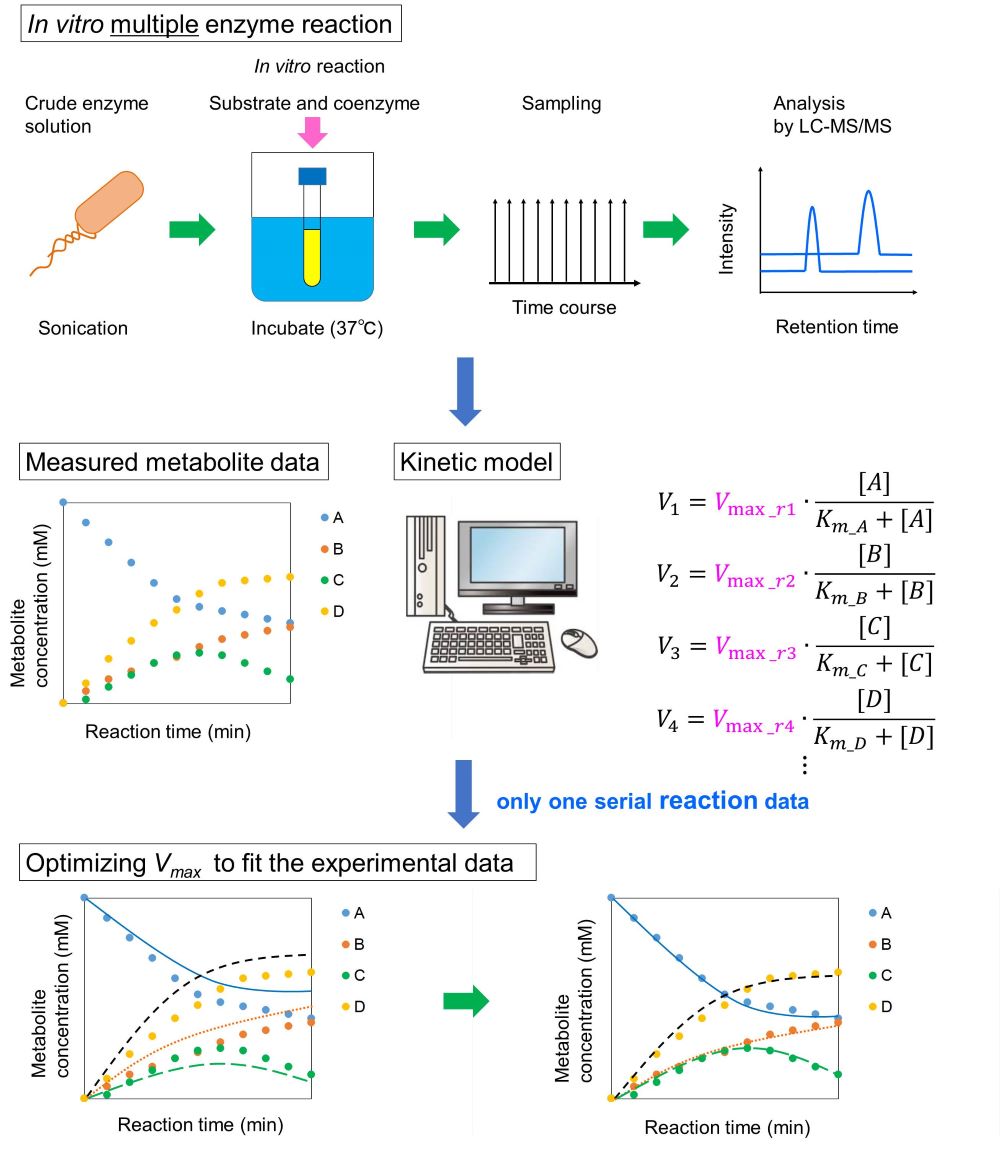
para-Aminobenzoic acid (PABA) is a building block for pharmaceuticals, and it has a great potential to serve as a raw material for aromatic polymers including engineering plastics. Currently, it is produced mainly by multi-step chemical conversions from petroleum-derived toluene via p-nitrotoluene and p-nitrobenzoate. With the recent increases in environmental consciousness, there is a growing interest in the production of PABA from renewable resources by fermentation. Escherichia coli can synthesize PABA from glucose via the central metabolic pathway shikimate pathway and folate pathway. Therefore, in this study, we aimed PABA production from glucose with E.coli. Firstly, we introduced into E.coli two genes pabAB and pabC which express aminodeoxychorismate synthase and 4-amino-4-deoxychorismate lyase respectively and used this engineered strain to produce PABA from glucose. The strain produced up to 1.92 g/L of PABA from 20 g/L glucose. Secondly, to increase PABA production, we tried to enhance the shikimate pathway of this engineered strain by introducing aroA, aroB, aroC, aroD, and pA1lac promoter-controlled aroFfbr respectively. However, these strains exhibited no increase in PABA production. Thirdly, we tried to enhance the folate pathway of E. coli overexpressing pabAB and pabC genes by adding Glutamine at 10 mM. As a result, by adding Glutamine at 10 mM, PABA production increased up to 3.03 g/L. This result suggests that the folate pathway is the rate-limiting step and the folate pathway needs to be enhanced to further increase PABA production.
Introduction
Although, yeast Saccharomyces cerevisiae has been used to produce various bio-based chemicals including solvents and organic acids, most products inhibit their growth at high concentrations. In general, it is difficult to rationally improve stress tolerance in yeast by modifying specific genes because many unspecified genes are involved in stress response. Previous studies reported that various stress tolerance in yeast was improved by introducing random mutations such as DNA point mutations1) and DNA structural mutations. In DNA point mutagenesis, protein functions and activities can be altered by changing several bases. On the other hand, in DNA structural mutagenesis, expression levels of multiple proteins can be altered by changing a wide range of bases. In this study, we developed a novel mutagenesis strategy combining point mutagenesis and structural mutagenesis to construct yeast with high 2,3-butandiol (2,3-BDO) tolerance.
Results
A DNA point mutation and a structural mutation were simultaneously introduced into S. cerevisiae YPH499 strain while stepwise increasing the concentration of 2,3-BDO. Resultant mutant YPH499/pol3δ/BD_392 showed 1.3- and 2.6-fold higher cell concentrations than parent strain YPH499 after 96 h cultivation in media containing 125 and 150 g/L of 2,3-BDO, respectively.
Conclusion
We successfully developed the novel mutagenesis strategy combining point and structural mutagenesis and constructed yeast with high 2,3-BDO tolerance. The strategy developed in this study achieves efficient modification of yeast genomic DNA, and thus it can be applied for construction of mutant yeasts with various stress tolerance. Besides, it is expected to further elucidate resistance mechanisms and further improve tolerance by detailed analysis of mutants with improved tolerance.
Acknowledgments
This work was partly supported by JSPS KAKENHI (grant number JP18K14069 and JP18KK0413).
Reference
1. H. Abe et al.; J Biosci Bioeng 108:199–204 (2009)
Isopentenol is promising biofuel with more favorable combustion properties. Because isopentenol shows some attractive characteristics, such as higher energy density, lower water miscibility, and better low-temperature fluidity than other biofuels, it is expected as alternatives of gasoline and jet-fuel. Supplies of petroleum, the conventional source of isopentenol, are unsustainable, and chemical synthesis processes could cause serious environmental problems. As an alternative, the biosynthesis of isopentenol from biomass is more sustainable and environmentally friendly. Therefore, we tried to produce isopentenol by engeneered Escherichia coli. Firstly, we introduced seven genes (atoB, mvaS, mvaE, ERG12, ERG8, MVD1 and nudB) into Escherichia coli and used this engineered strain to produce isopentenol from glucose. This strain (ISO-1) produced 68.1 mg/L isopentenol and accumulated 3.83 g/L mevalonate from 20 g/L glucose. Secondly, we constructed ISO-2 strain enhanced pathway after mevalonate. This strain produced 171 mg/L isopentenol and accumulated 1.01 g/L mevalonate from 20 g/L glucose. Thirdly, we constructed ISO-2 with glcB knockout (ISO-2ΔglcB) and aceBA knockout (ISO-2ΔaceBA) and tried to strengthen the flux to isopentenol. As a result, it succeeded in further improving the isopentenol production. ISO-2ΔglcB and ISO-2ΔaceBA produced 434 mg / L and 472 mg/L isopentenol. This result suggests that reducing Acetyl-CoA consumption and redirecting metabolic flux for isopentenol production is important for isopentenol production. ISO-2ΔaceBA succeeded in about 7 times isopentenol production of ISO-1.
Fatty acids are used for fuels, cosmetics, pharmaceuticals. Currently, they are made from natural fats and oils. Production technology using bacteria has been studied, but it has not reached a practical level. Previous studies have shown that palmitic acid and oleic acid account for 90% of the fatty acids excreted from cells when producing fatty acids from glucose using Corynebacterium glutamicum. In this study, we tried to produce palmitic acid and oleic acid using metabolically engineered C. glutamicum. First, we disrupted fasR(strain1). Second, we introduced the plasmid containing cgR0949-tfu0939 encoding cellobiose degrading enzyme, β-glucosidase(BGL), into strain1 to produce fatty acid from cellobiose. This strain intracellularly produced 0.606 g/L of palmitic acid and 0.536 g/L of oleic acid from cellobiose in test-tube after 72h. Third, we disrupted two genes (pyc and ppc) to accumulate acetyl-CoA. The strain disrupted fasR and pyc (strain2) extracellularly produced 0.130 g/L of palmitic acid and the strain disrupted fasR and ppc (strain3) ectracellularly produced 0.0676 g/L of oleic acid from glucose in the test-tube after 72h.
Pichia membranifaciens KS47-1 have been isolated from environment as a resistant yeast as growth inhibitory materials in hydrolysates derived from lignocellulosic biomass. The strain has a great potential of host yeast for cell factories to be applied a broad ranges of bio-products, after introducing metabolic pathways. In this study, the responses of gene expression in the strain were differentially analyzed between in a corncob hydrolysate and in the hydrolysate removing the inhibitory materials by activated carbon treatment by RNA-sequence analysis. The hydrorated corncob (1:10 of solid/water ratio) were hydrolyzed at 121°C for 1 h by 3.0 % sulfuric acid, and subsequently treated at 50°C for 3 days by a cellulase. Activated carbon (AC) of 3% w/v were added and absorbed inhibitory materials in the hydrolyastes for 3 h, and were removed by a filteration. Although KS47-1 growth was observed in the both of hydrolysates prepared, the latent growth was shown in the hydrolyastes without AC treatment. Duplicated RNA-seq analyses were performed for the logarithmic growing cells in each hydrolysates with 11.4 to 13.7 M reads (Q30: >94%). Top-Hat2 mapping was carried out with 103% of mapping ratio and 30% coverage. The sequencing depths were among 4.4 to 6.8 folds. According to gene ontology analysis, toxicity compounds in hydrolysates stimulated many of membrane transporters. The expression levels of ATP-binding multi drag transporters, TPO3, SNQ2, and PDR5 were increased 1.74, 1.63, and 1.46 as log2 fold changes, respectively (p value = 0.00005). The results implied that KS47-1 efficiently evacuate the inhibitory compounds by the activities of the transporters responded to increasing the toxic compounds in the cytosol.
In order to solve environmental and resource exhaustion problems and achieve an environmental sustainable society, a biorefinery that produces a variety of bio-based products from renewable biomass resources is important. At present, by microbial organisms using C5/C6 sugars, the production of target compounds currently being produced from petroleum is important. In particular, it is expected that the demand for unsaturated hydrocarbons having double bonds, which can be used as a polymer raw material, will increase rapidly.
To produce these compounds, we focused on ferulic acid decarboxylase (FDC). FDC can catalyze the decarboxylation of the R-C=C-COOH side chain end of the hydrocarbon unsaturated carboxylic acid (such as ferulic acid) and converts it to R-C=C (such as styrene). For this decarboxylation reaction, FDC requiters a prenylated-FMN (prFMN) as a cofactor, which is synthesized from FMN and dimethylallyl-phosphate by prenyltransferase.
In this study, to bio-synthesize target α,β-unsaturated compounds, we screened several genes encoding FDC and prenyltransferase. Then the FDC showed the highest decarboxylase activity was selected as a template and we developed FDC variants to enable production of target molecules efficiently based on the rational design of enzyme. Recent years has seen significant interest in a rational design in which a mutation is introduced at pinpoint relative to the active site of the enzyme. As a host for enzyme screening and substance production, Escherichia Coli was selected. Finally, with the combination of precursor-producing microbial cell and decarboxylase mutants, we aim to develop a microbial cell factory that produces α,β-unsaturated target compounds efficiently and directly from renewable carbon source glucose.

Metabolic engineering is a promising method for maximizing the production of specific metabolites. Saccharomyces cerevisiae and Escherichia coli are common hosts for metabolic engineering. However, these microorganisms require an aerobic growth phase with aeration and vigorous agitation before the fermentation production phase. As a consequence, bioproduction systems are often economically unsustainable, particularly for the bulk production of chemicals or biofuels. Moreover, because of the requirement for aeration during the growth phase, it is usually challenging to scale-up the fermentation process. This study aimed to construct a platform microorganism for anaerobic bioprocessing (ABP), which requires neither aeration nor vigorous agitation.
The lactic acid bacterium Lactobacillus plantarum maintains a similar growth rate under both aerobic and anaerobic conditions, which enables the growth-associated production of lactate without the need for aeration and vigorous agitation. Therefore, L. plantarum is a suitable host for ABP. However, the strain converts most of the fermented sugar into lactate. To prevent the production of lactate, we disrupted both L- and D-lactate dehydrogenase genes (ldhL1 and ldhD, respectively) in L. plantarum. Then, to promote ethanol fermentation, we introduced in the ΔldhL1 ΔldhD strain pyruvate decarboxylase and alcohol dehydrogenase genes from various origins. For the strain showing the highest ethanol titer, ethanol fermentation was performed from 150 g/L glucose in a 1 L jar fermenter. After 100 h of fermentation, 56.7 g/L of ethanol was successfully produced.
Our next challenge is to produce ethanol from lignocellulose hydrolysates which contain both C6 and C5 sugars. To redirect the phosphoketolase pathway (which produces equimolar amounts of pyruvate and acetate from pentose sugars) to the pentose phosphate pathway (which only produces pyruvate from pentose sugars), we replaced the phosphoketolase gene (xpk1) with the transketolase gene (tkt) from Lactococcus lactis. Using this strain, ethanol fermentation from C5 sugars are now under consideration.
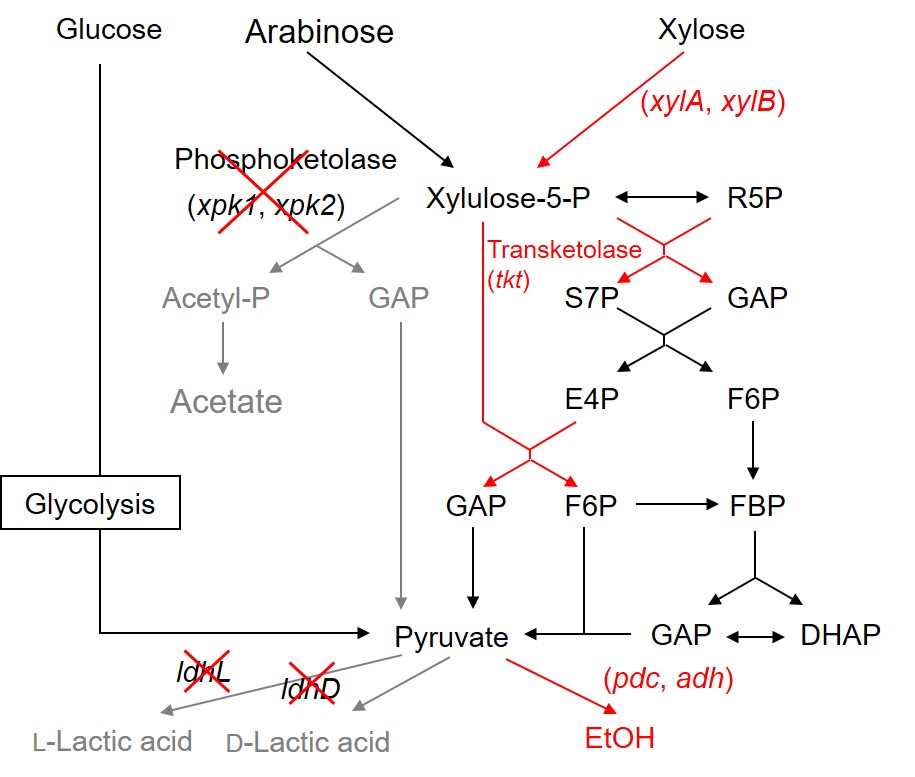
1. Introduction
Polyhydroxyalkanoates (PHAs) are biodegradable and produced by microorganisms from biomass. They are expected to reduce plastic wastes and carbon dioxide emissions compared to conventional fossil resource-derived plastics. Compostable PHA filtration membranes will be useful to develop environmentally benign filtration processes. In this study, PHA porous membranes were prepared using phase separation method, and membrane forming conditions were examined for application to microfiltration membranes.
2. Materials and methods
Typically PHA (extrusion grade, Goodfellow) was dissolved at 10-20% on a hot stirrer at 85 °C in 1,4-dioxane (DIOX), 1-methyl-2-pyrrolidone (NMP), or N,N,-dimethylformamide (DMF). After cooling to 50 °C, the PHA solution was cast onto a glass plate with a 0.5 mm thick frame which was preheated at the same temperature as the solution. It was immersed in a water bath (25 °C) to induce its phase separation. The filtration resistances of formed flat-sheet membranes were calculated from the filtration rates measured by the filtrations of purified water at 10 kPa, and the retention ratios were from the filtrate turbidity at a wavelength of 660 nm after filtration of suspensions of latex beads with a diameter of 0.3 μm.
3. Results and discussion
Flat sheet membranes were obtained from the 20% PHA solutions while no flat ones were obtained from the 10% polymer solutions. The prepared PHA flat membranes have asymmetric structures having a dense layer in the surface portion in contact with non-solvent water at the time of phase separation, and a porous structure inside. The PHA membrane prepared with DMF as a solvent showed the lower filtration resistance and the higher retention of latex beads compared to the membrane prepared with DIOX and NMP. The polymer concentration was optimized to be 18%. The PHA filtration membrane will be one of the key materials to achieve sustainable development goals (SDGs).
Fatty acids are valuable products because they have wide industrial applications in the manufacture of detergents, cosmetics, food, and various biomedical applications. In enzymecatalyzed hydrolysis, the use of immobilized lipase results in high production cost. To address this problem, Eversa Transform lipase, a new and low-cost liquid lipase formulation, was used for the first time in oil hydrolysis with gac oil as a triglyceride source in this study. Response surface methodology was employed to optimize the reaction conditions and establish a reliable mathematical model for predicting hydrolysis yield. A maximal yield of 94.16% was obtained at a water-to-oil molar ratio of 12.79:1, reaction temperature of 38.9 degree C, enzyme loading of 13.88%, and reaction time of 8.41 h. Under this optimal reaction condition, Eversa Transform lipase could be reused for up to eight cycles without significant loss in enzyme activity. This study indicates that the use of liquid Eversa Transform lipase in enzyme-catalyzed oil hydrolysis could be a promising and cheap method of fatty acid production.
Rice husk, a form of biomass material, is a potential source of renewable energy. Recovering silica from rice husk is an important element in manufacturing high value-added products, and ensures efficient utilization of a bio-resource. This paper reports the synthesis of SBA-15 mesoporous silica from recycled rice husk ash waste. Next, graphene oxide/order mesoporous carbon (GO/CMK-3) nanocomposite was synthesized using the SBA-15 template. This investigation characterized GO/CMK-3 materials through transmission electron microscopy (TEM), field–emission scanning electron microscopy (FESEM), X-ray diffractometry (XRD), surface area analysis, and Raman spectrometry. Various experimental parameters including the kind of adsorbent, initial concentration of dye, and solution temperature were investigated. TEM of the synthesized GO/CMK-3 revealed that carbon material possessed a well-ordered array of mesopores with a uniform pore size. The surface area and pore volume of RH-CMK-3/GO sample were 936 m2/g and 1.077 cm3/g, respectively. GO/CMK-3 showed the higher capacity for dye adsorption than that of pure SBA-15 and CMK-3. Increasing the initial concentration of methylene blue (MB) could enhance the adsorption rate. The adsorption capacities were decreased with an increase in the solution temperature. The thermodynamic analysis reveals that the adsorption process was exothermic and spontaneous. The GO/CMK-3 composite contained considerable degree of oxidation with different functional groups, which could efficiently bind a dye molecule to form a dye complex. The GO/CMK-3 composite is a potential low-cost adsorbent for removal and recovery of industrial dye from wastewater.
Shochu lees is a distillation residue discharged during shochu production, and it is one of major organic wastes available for sustainable bioenergy production. The nonconformity with the composition variation of the waste may lower the activity of methanogens in a two-stage hydrogen and methane fermentation process. One of them is the effect of organic acid concentration on methane production. In order to maintain the activity of methanogens, the organic acid concentration in the substrate must be kept constant. However, the appropriate organic acid concentration for the activity of methanogens has not been reported. In methane production, 70% of the produced methane is due to the decomposition of acetic acid and is carried out by the acetylotrophic methanogens. In this study, we focused on acetic acid concentration. Sodium acetate (0.002, 0.01, 0.02, 0.03 and 0.2 mol/L) was added to the fermented broth which had been acclimated for a long time, and cultivation was carried out at 37 °C, at pH 7. Methane gas was most generated at acetic acid concentration of 0.03 mol/L. Therefore, it was found that the acetic acid concentration in the substrate of 0.03 mol/L was suitable for the activity of acetylotrophic methanogens in methane production. The results showed that the activity of methanogens can be maintained by maintaining the acetic acid concentration at 0.03 mol/L in the acetic acid concentration in the substrate. In this case, methane was produced immediately after the start of fermentation. This study showed that by maintaining the acetic acid concentration in the substrate at 0.03 mol/L, the activity of methanogens is maintained and the production of methane in a short time can be achieved.
Introduction
It is known that red raspberry (Rubus idaeus) contains various polyphenol compounds at high concentration and its functionality is expected to have health maintenance and disease prevention effect. Not only the fruits, but also the leaves of raspberry plants, are highly esteemed for tea making around the world and are largely used for food. We are interested in the relationship between the polyphenol content of raspberry and the cultivation environment. In this report, we discuss the results of on the effect of light and temperature on polyphenol accumulation in raspberry leaves.
Results and discussion
When raspberry was cultivated in a plant factory unit and light intensity, wavelength, and temperature were varied, the amount of total polyphenol increased under blue light. Quantitative determination of flavan-3-ol derivatives {(+)-catechin, (–)-epicatechin and condensed tannin}, quercetin derivatives and hydrolysable tannin (Figure 1), was carried out using HPLC. Among them we confirmed flavan-3-ol derivatives increase under blue light. Semi-quantitative RT-PCR showed no correlation between flavan-3-ol derivatives-related gene expression and the amounts of the compounds measured in the leaves.1
Ref. (1) R. Kobori et al., Metablites,2019,9, 56.
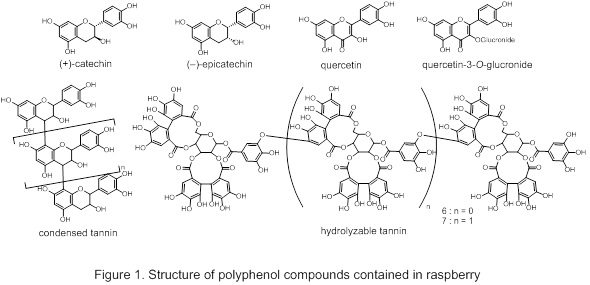
Cattle urine is one of large amount of waste in dairy industries, and often insufficiently decomposed in a reservoir and sprayed on farmland as fertilizers. However, the immature fertilizers sprayed causes problems in exhausting awful smell and in water pollutions of land water. In this study, it investigated the botanical effects of mature and immature cattle urine on germination of Japanese mustard spinach, Brassica rapa var. perviridis, and enhancing growth of tomato, Solanum lycoperisicum L., and B. rapa. Treatment by long-term aerations led microbial degradation of malodorous substances and germinating-inhibitory materials, and reduced the awful smell from the fermented urine. Immature fermented urine inhibited germination of B. rapa, but mature urine never. In hydroponics, the growth of B. rapa and S. lycoperisicum were enhanced by the matured fermented urine, with diluting 1/10 in water (Fig. 1). Equivalent results were observed in a commercial culture soil. Murashige and Skoog medium including 1/10 mature fermented urine also enhanced the growth of B. rapa. The weight with the mature fermented urine was three fold larger than that without the fermented urine. Total nitrogen, phosphate and potassium as inorganic nutrients were less than 290 mg-N/L, 26 mg/L, and 2,700 mg/L, respectively. The amounts of N, P, and K as nutrients were insufficient to stimulate the growth to the equivalent levels, as inorganic fertilizers. Interestingly, the fermented urine maintained the growth stimulating ability after autoclaving (121 °C, 20 min). From the results, there is possibility that thermal-stable organic chemicals in the sufficient fermented urine can act to stimulate the growth of plants, and next-generation fertilizers from cow urine may be produced in the future.
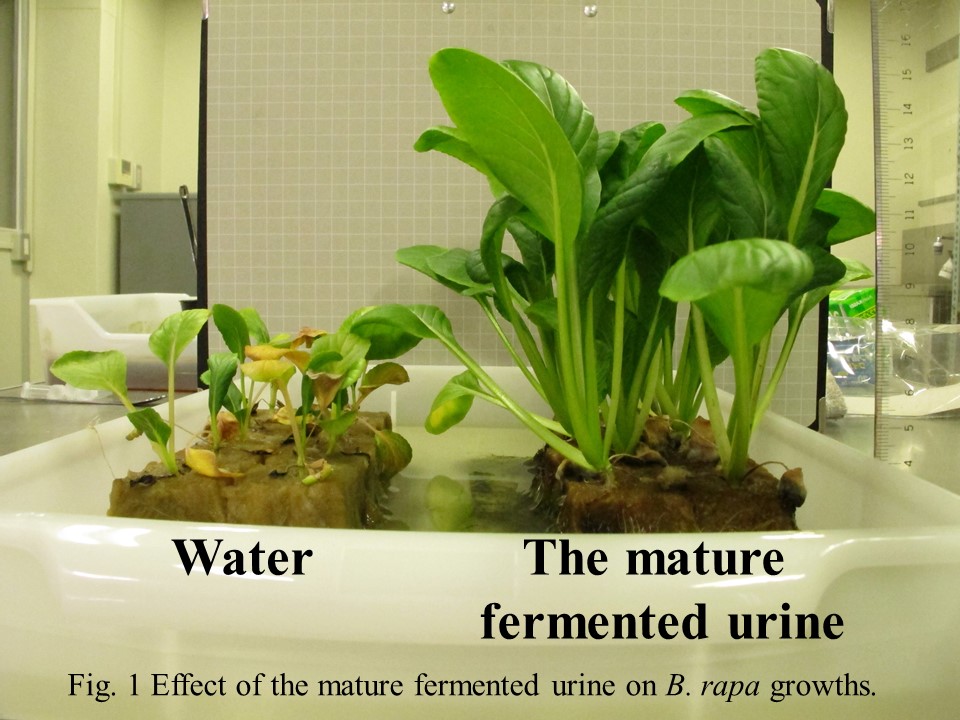
The utilization of biomass is required to establish a sustainable society. Rice bran, a byproduct in the refining of brown rice, is mainly used for producing rice oil. At this time, the defatted rice bran is generated as a residue. A method of effectively utilizing defatted rice bran is required. Several studies have reported that defatted rice bran contains various functional substances, especially protein and amino acids. The protein of rice bran has a highly nutritious with a well-balanced amino acid composition. Rice bran also contains many useful amino acids, such as γ-aminobutyric acid which has various functionalities.
We suggested that the preparation of an extract containing functional substances from defatted rice bran could be connected to new possible applications. Hot compressed water was used as the solvent for extraction. We expected that hot compressed water would hydrolyze the protein of defatted rice bran and increase the amount of amino acid extracted. The purposes of this study are to evaluate amino acids in the extract prepared from defatted rice bran and to reveal the reaction of protein or amino acids in hot compressed water.
The defatted rice bran was prepared from rice bran by the extraction process using hexane. The defatted rice bran was treated under different temperature conditions to prepare an extract. The extract was deproteinized and subjected to amino acid analysis.
Fig. 1 shows the total amount of 20 amino acids that constitute a protein obtained at each of the evaluated temperatures. The total amount of amino acids decreased as the temperature increased. The results suggest that the protein of rice bran was not decomposed amino acids in these temperatures. It is also considered that amino acids were decomposed or bonded to other substances by intermolecular dehydration or Maillard reaction.
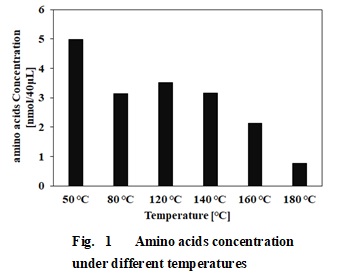
The production of biofuels by engineered microorganisms has recently become an attractive option, because of the global environmental problems and the combustion of fossil fuels. Among various biofuels, long chain alkanes and alkenes are superior compared with other biofuels like ethanol due to its high energy density and compatibility with modern internal combustion engines. Although an Escherichia coli strain that produces alkanes and alkenes was constructed by heterologous expression of acyl-acyl carrier protein reductase from Synechococcus elongates (SeAAR) and aldehyde decarbonylase from Nostoc punctiforme (NpAD) (1), its productivity did not fulfil industrial requirements.
In this study, effects of the promoter for NpAD expression on the alkanes production by engineered E. coli was evaluated. And improvement of the solubility of SeAAR was tried.
Plasmids pESeAAR-trcNpAD and pET7SeAAR-T7NpAD which express SeAAR and NpAD simultaneously were constructed. pESeAAR-trcNpAD expresses SeAAR by T7 promoter and NpAD by trc promoter, whereas pET7SeAAR-T7NpAD expresses both SeAAR and NpAD by T7 promoter. E. coli BL21 (DE3) cells were transformed using these plasmids and the resultant transformants were named BL21/pESeAAR-trcNpAD and BL21/ pET7SeAAR-T7NpAD. Furthermore, random mutation was introduced into the SeAAR gene using error-prone PCR to obtain mutated SeAAR which solubility was improved.
The amounts of alkanes produced by BL21/pET7SeAAR-T7NpAD was 1.5-fold larger than those by BL21/pESeAAR-trcNpAD. And mutated SeAAR which solubility was improved was successfully obtained.
(1) Andreas, S. et al.; Science, 329, 559-562 (2010).
We successfully isolated new freeze-tolerant yeast SRT88 from Hokkaido Saroma Lake. In this study, taxonomic characterization of SRT88 and bread manufacturing using the strain. The strain identified as Zygosaccharomyces rouxii that is known as a fermenting yeast in soy source manufacturing. The freeze tolerance of the yeast was observed higher than that of Torulaspora delbrueckii NBRC1129 known as freeze tolerant yeast. To characterize the strain in the dough for frozen storage method, fermentabilities in dough were examined after freezing and thawing. Although SRT88 fermentability demonstrated 117 mL lower than a commercial dry yeast 316 mL, the strain showed 114 mL after 1 week-frozen-storage which was higher fermentability than a dry yeast of 67 mL and maintained the level of fermentability after 2 weeks-frozen-storage. Furthermore, SRT88 fermentability was improved to use glucose. The fermentability using glucose was 40% higher than that using sucrose. In an analogous fashion, crumb hardness of baked bread using SRT88 was 1.17± 0.16 N , on the other hand after storage was 1.68±0.23 N lower than that using a commercial dry yeast was 1.92±0.40 N. According to the results, SRT88 showed an advantage for bread manufacturing including frozen storage. SRT88 gave different flavor to bread from commercial dry yeast on the basis of volatile component analysis with GC/MS and statistical analysis of orthogonal projections to latent structures discriminant analysis (OPLS-DA). Heat map result showed that SRT88's bread has characteristic volatile component of 2-Ethyl-1-hexanol (Fig. 1).
In conclusion, SRT88 showed stable fermentability during frozen dough method and flavor is different from commercial dry yeast to fewer frozen damage to dough after frozen. The results demonstrated a possibility that SRT88 use frozen dough method

Non-conventional yeast (NCY) in cool temperate zone and subarctic zone has possibilities of adapting to frozen stress in winter. Several freezing-tolerant-NCYs, which demonstrated higher freezing-resistance than previous reported yeasts, have been isolated from environment. The mechanisms of frozen resistance of the isolates have not been revealed. Saccharomyces cerevisiae, well-known yeast species, accumulates sugar alcohols and amino acids in their cytosol, and resists to frozen stresses with buffering by the materials. In this study, we investigated the frozen-adapting mechanism of the isolates, Zygosaccharomyces rouxii SRT88 and Candida tropicalis SRF61, to comparing metabolomes among the taxonomically related strains.
Metabolites were extracted by methanol/chloroform (1:2) from freeze-dried cells, and trymethylsilirated by methoxamine hydroxylate and N-Methyl-N-trimethylsilyltrifluoroacetamide. The trimethylsilylated derivatives were analyzed by GC-MS. Orthogonal projections to latent structures (OPLS) were used for modeling the differences of metabolites.
According to OPLS, high correlated modeling were achieved between metabolite composition and freeze-resistance (R2>0.95, Q2>0.90) .The significant metabolites were filtered by variable importance in projection (VIP) scores and p values in analysis of variance (VIP ≥ 1.0, p ≤ 0.05).Based on the results, C. tropicalis SRF61 accumulated higher concentrations trehalose and aspartic acid than the referenced strains, and Z. rouxii SRT88 higher D-mannitol. Aspartic acid was a novel cryoprotectant metabolite in the best of our knowledge. The possibility of variety in freezing-tolerant mechanism of NCYs were demonstrated in this study.
Microbial production of 1,5-diaminopentane is from renewable feedstock is a promising and sustainable approach to produce bio-based polyamides. In this study, we constructed beta-glucosidase (BGL) secreting Corynebacterium glutamicum, and direct 1,5-diaminopentane production from cellobiose as well as glucose was demonstrated. First, C. glutamicum was metabolically engineered to create L-lysine (a direct precursor of 1,5-diaminopentane) producing strains. Then L-lysine decarboxylase (ldcC) derived from E. coli and BGL from Thermobifida fusca YX (Tfu0937) were co-expressed. This engineered C. glutamicum strain produced 27 g/L of 1,5-diaminopentane from cellobiose in CGXII minimal medium in a fed‐batch cultivation. The yield was 0.43 g-1,5-diaminopentane / g-glucose (1 g of cellobiose corresponds to 1.1 g of glucose). These results demonstrated the feasibility of 1,5-diaminopentane production from cellobiose or cellooligosaccharides as alternative substrates using engineered C. glutamicum strain.
Mevalonate is a precursor of isoprenoids and has been used in cosmetics and as building block for the production of functional polymers. It is difficult to industrially produce mevalonate by chemical synthesis, because mevalonate used in cosmetics is need to be (R)-enantiomer. Thus, mevalonate is produced by fermentation of microbes from glucose. However, there still remain problems that yields of mevalonate is not sufficient. Therefore, we tried to develop highly efficient production of mevalonate by metabolic engineering of Escherichia coli.
First, we introduced into E.coli three genes which express Acetyl-CoA acetyl transferase, HMG-CoA synthase and HMG-CoA reductase (atoB, mvaS and mvaE respectively). This strain produced 2.16 g/L mevalonate from 20 g/L glucose.
Next, we tried to improve production capacity of mevalonate by disrupting some genes. Because three molecules of acetyl-CoA are required to synthesize one molecule of mevalonate, the amount of acetyl-CoA is considered to affect the production of mevalonate. To accumulate acetyl-CoA, we constructed MG1655ΔppcΔaceBA strain. This strain produced 6.00 g/L mevalonate from 20 g/L glucose.
Finally, we tried to produce mevalonate from cellobiose. To give the E.coli an ability to break down cellobiose, we displayed β-Glucosidase(BGL), Tfu0937, on the E.coli cell surface using Blc as an anchor protein. BGL-displaying MG1655ΔppcΔaceBA strain produced 5.72 g/L mevalonate from 20 g/L cellobiose. We succeeded in producing mevalonate from cellobiose for the first time.
Shikimic acid is a valuable hydroaromatic compound and a key metabolic intermediate. Currently, shikimic acid can be obtained from fruit of Chinese star anise, but there are problems of feedstock limitation and extraction cost. Therefore, production of shikimic acid from renewable resources such as cellulosic biomass is required. Corynebacterium glutamicum is widely used for industrial production of amino acids including L-glutamate and L-lysine. However, C. glutamicum doesn't accumulate shikimic acid, and can not assimilate cellulose originally. Cellulose is degraded to cellobiose by cellulolytic enzymes, and cellobiose is degraded to glucose by β-glucosidase(BGL). At first, we tried to produce shikimic acid from cellobiose using metabolically engineered C. glutamicum with BGL. In this study, to accumulate shikimic acid in C. glutamicum, we disrupted several genes including aroK, qsuD, qsuB, nagD. We also disrupted pyk gene for improving availability of PEP, and mutated gnd gene to improve pentose phosphate pathway. Furthermore, we expressed the BGL gene(cgR0949-tfu0939) in C. glutamicum to produce shikimic acid from cellobiose. As a result, we successfully produced 2.8 g/L of shikimic aicd from cellobiose using engineered C. glutamicum. Deletion of pyk and mutation of gnd improved shikimic acid productivity.
Microbial bioproduction have attracted much attention because of the increasing demand for environmentally-friendly bioprocesses. We focused on the production of mevalonate by Escherichia coli. Mevalonate is one of the important compounds, which is utilized as the intermediate of a medicinal or a cosmetic compound and is the metabolic intermediate for synthesizing terpenoids. Here, we attempt to improve the production of mevalonate by using single gene knockout strains. The plasmid including mevalonate-producing genes (pMev) was transformed into a single gene-deficient E. coli BW25113 strain, and cultivated with 20 g L-1 glucose and 5 g L-1 yeast extract containing minimal medium. Mevalonate production was determined using a gas chromatograph equipped with a flame ionization detector. BW25113 harboring pMev produced mevalonate from glucose at a concentration of 0.8 g L-1 after 48 hours cultivations (WT). Then, the effect of single gene knockout on mevalonate production was evaluated. The deletion of several genes was effective for improving the production of mevalonate. The production of mevalonate with a gltA-deficient strain, an aceA-deficient strain, an aceB-deficient strain and an acnA-deficient strain were increased compared with WT (1.4 g L-1, 0.9 g L-1, 1.3 g L-1, 1.0 g L-1, respectively). These genes are involved in acetyl-CoA catabolism in the glyoxylate shunt, and acetyl-CoA level is critical for enhancing the production of mevalonate because acetyl-CoA is metabolic intermediate for the synthesis of mevalonate. The deletion of cyaA, which is involved in catabolite repression, was also effective for the improvement of the production of mevalonate (1.7 g L-1).
Photosynthetic microalgae attract much attention as a sustainable green cell factory, and genetically modified microalgae have been expected to be a useful tool for bioenergy and recombinant protein production. However, random integration of transgene in the microalgae nuclear genome is susceptible to gene silencing of heterologous gene expression1. Here, we attempted to perform targeted gene integration into a pre-determined nuclear genomic site of Chlamydomonas reinhardtii using Cre/loxP recombination system for stable transgene expression. We constructed an expression vector plasmid encoding reporter genes (zeocin resistant gene and green fluorescent protein [GFP] gene; Zeo-2A-GFP) and mutated loxP to generate founder cells. The plasmids were introduced into C. reinhardtii by electroporation and the cells were screened by zeocin. Cell clones exhibiting the stable expression of the reporter genes during culture were selected from transformants using FACS. A donor vector containing target genes flanked by corresponding mutated loxPs was constructed and introduced into founder cells together with a Cre expression vector. After Cre-mediated gene integration, paromomycin resistant gene and IFNα-4 expression cassettes of the donor vector were integrated into a pre-introduced target loxP site placed downstream a promoter. Targeted knock-in cells lost the zeocin resistance but acquired paromomycin resistance. The optimal ratio of donor vector and Cre expression vector was determined by counting the number of paromomycin resistant colonies. For the established clones, the targeted integration was confirmed by genomic PCR using various specific primer sets. RT-PCR revealed that IFNα-4 was expressed in five independent transgenic cell lines tested. In conclusion, we succeeded in site-specific transgene integration into the C. reinhardtii cell genome using Cre/loxP system. This result suggests that Cre-based cell engineering is a promising approach to generate smart microalgae expressing foreign genes.
1. Scranton MA et al., Plant J. 82(3):523-531 (2015)
Chitosan and its derivatives have been widely used as an antimicrobial agent either alone or blended with other polymers. The chitosan derivatives with quaternary ammonium groups have higher efficient activity against bacteria as compared to pure chitosan, such as N-[2-hydroxyl-3-trimetylammonium) propyl] chitosan chloride (HTCC). However, HTCC is a water soluble derivative of chitosan. Hence, biodegradable polyvinyl alcohol (PVA) was chosen and used as an effective additive to HTCC to improve fiber spinning ability. In this work HTCC/polyvinyl alcohol nanofiber membrane has been successfully made by electrospinning process. The HTCC/PVA nanofiber can be stabilized against water by isothermal crosslinking with water soluble blocked di-isocyanate. Microbiological assessments showed that the water stable HTCC nanofibers have a good antibacterial activity against E coli.
Emulsifiers that uniformly mix immiscible materials such as water and oil are widely used in food, cosmetics, and so on. Although many emulsifiers currently used are chemically synthesized, naturally-occurring emulsifiers are required from the viewpoint of the safety sought by consumers. We found that the cell wall mutant of Saccharomyces cerevisiae widely used in fermented food had a strong emulsifying effect on the cells themselves. Therefore, we focused on the emulsifying effect of cell wall proteins. Then, we found high emulsifying activity in Gas1 protein, which is bound to the cell wall via glycosylphosphatidylinositol (GPI) anchor. In addition, it was found that the Gas1 protein strongly activates mouse macrophage, the immunocompetent cell. Thus, this protein is expected to be applied as an emulsifier capable of imparting an immune enhancing effect. Gas1 protein belongs to Gas family of proteins in S. cerevisiae, including other four proteins with high homology. When we examined the relationship between protein structure and their activities by evaluating other Gas family proteins and Gas1 mutant proteins, the region required for high emulsifying activity was elucidated. Currently we are clarifying the regions required for macrophage activation. Meanwhile, S. cerevisiae has many proteins localized in the cell wall via different bond modes from GPI anchor. We have been also examining emulsification and macrophage activation for such proteins, and our results suggest that several proteins have the same function as Gas1. We think that there are proteins involved in emulsification and macrophage activation in the cell surface of S. cerevisiae and we will surely develop not only naturally-derived emulsifiers but also functional emulsifiers by utilizing them. This presentation will report the above details.
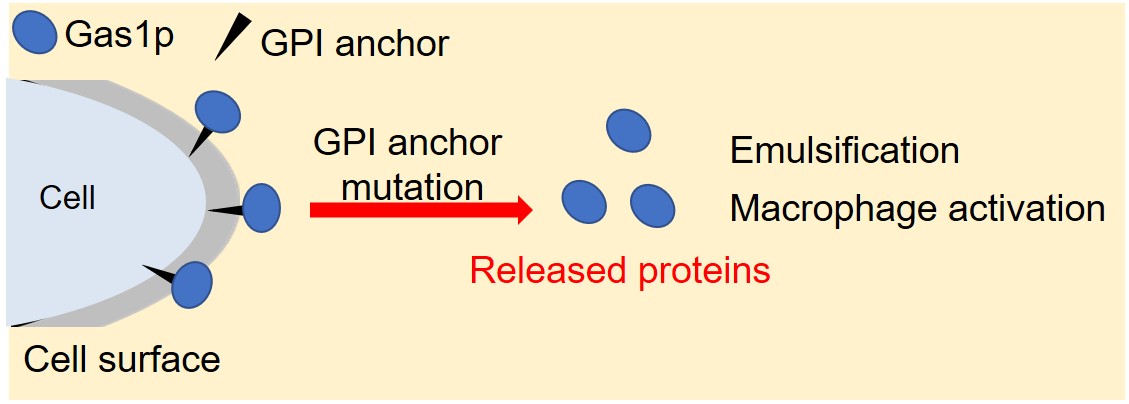
Flocculation is an aggregation phenomenon of microbial cells in which the cells form flocs. Flocculation can contribute to the efficiency of industrial production processes. For example, in repeated batch fermentation production of ethanol using flocculating yeast, the centrifugation step required for cell recovery can be eliminated. Besides yeast, Escherichia coli is known as an industrial bacterium. Although E. coli naturally does not form floc, we succeeded in inducing them to floc formation by overexpression a native bcsB gene, encodes a component of cellulose synthase or deletion of degP gene, encodes a periplasmic protease1). However, floc formation is less than 100 mg/L and not enough to be used in fermentation production. In this study, we aimed to understand the formation mechanism of E. coli flocs and further increase the formation efficiency. Since E. coli flocs were proteinous, the amount of protein included in flocs were measured, and the value was used as an index of floc amount. When each strain was cultured in LB medium containing glycerol, only the ΔdegP strain increased the floc formation. Amount of floc formation reached approximately 230 mg/L in the presence glycerol. Meanwhile, the uptake of glycerol into cells was not confirmed. Next, we focused on the high viscosity of glycerol. Additing thickening agent such as carboxymethyl cellulose and polyvinylpyrrolidone into medium did not increase the floc formation. In contrast, the addition of ethylene glycol, which is classified into the same polyols as glycerol, significantly promoted the floc formation. Thus, it was suggested that floc formation of E. coli ΔdegP strain was enhanced by polyols. Further analysis will aim to elucidate the action of polyols on E. coli flocs.
1) Ojima et al. (2015) AEM 81:5900-5906
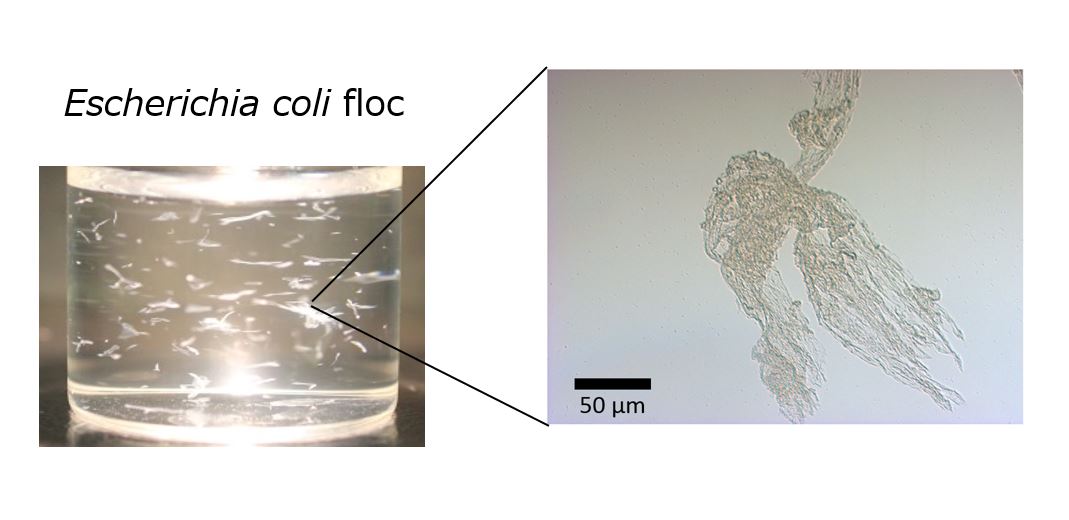
From the standpoint of the food safety management, it is very important to control microorganisms that can grow in a refrigerator. We evaluated the growth characteristics and sterilization conditions of Exiguobacterium sp. and Pantoea sp. which were isolated from a food manufacturing environment. These two microorganisms were capable of growth at refrigeration temperatures (4 °C and 10 °C), but their optimal growth temperature was approximately 30 °C. Thus, these microorganisms were classified as psychrotrophic bacteria. Heat treatment and sodium hypochlorite exposure were effective for the inactivation of the two microorganisms and the sensitivities toward these sterilization conditions of them were higher than those of Escherichia coli (E. coli). Although Exiguobacterium sp. and Pantoea sp. exhibited similar alkaline tolerance at pH 8.0, the degrees of their acid tolerance were different from each other. Exiguobacterium sp. was easily killed by acetic acid (pH 2.68) and citric acid (pH 2.0), while Pantoea sp. was relatively insensitive to these acids. In particular, Exiguobacterium sp. should be careful because the microorganism exhibited an unusually high resistance to ozone treatment and UV radiation whose conditions were enough to kill Pantoea sp. and E. coli. This is probably due to the protective effects of carotenoids, antioxidant enzymes and DNA repair enzymes in Exiguobacterium sp. cells against oxidative stress and DNA damage. Interestingly, Exiguobacterium sp. and Pantoea sp. were effectively sterilized by pulsed electric field (PEF) treatment under the condition that was not sufficient to kill E. coli (Fig. 1). Since the Exiguobacterium sp. and Pantoea sp. cells were cultivated at 4 °C, the cell membranes of the two microorganisms seemed to become more fragile with increasing unsaturated fatty acid content. Our results suggested that PEF treatment has a high potential to be used in the sterilization of psychrotrophic bacteria associated with spoilage of food at refrigeration temperatures.
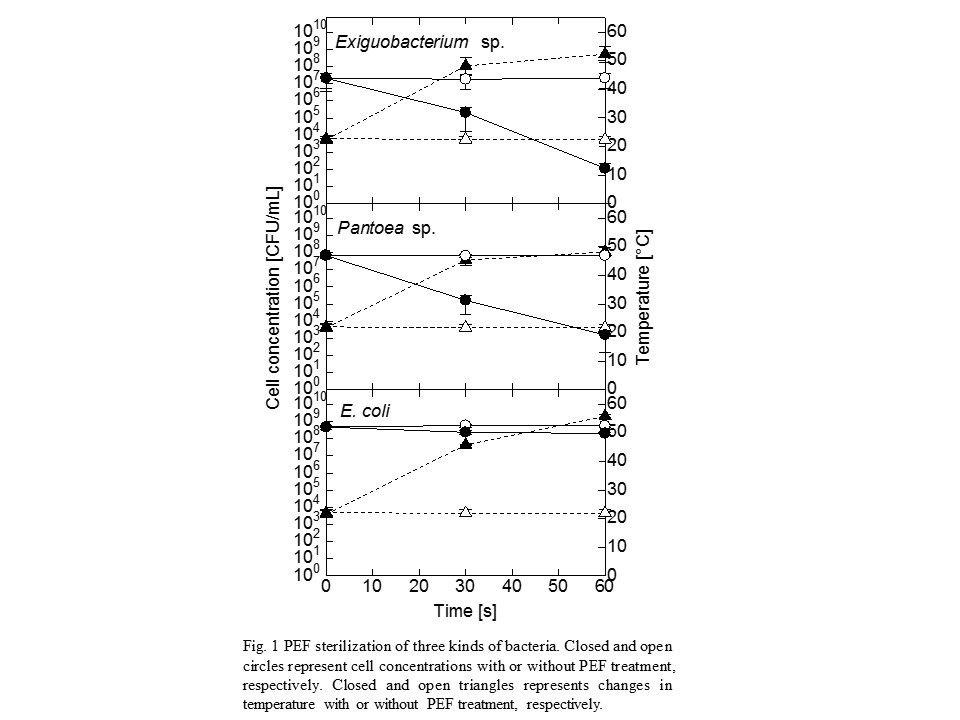
Beta-carotene is distinguished as a vitamin A precursor and make an effect of the antioxidant action and immunostimulating activity. In recent years, it is mainly produced by extraction from plants and chemical synthesis from petroleum which causes an unstable production and serious environmental problems. In order to achieve the requirements of mass production, in this study, we carried out metabolic engineering using CRISPR-Cas9 to edit genes of beta‐carotene biosynthesis from cellulosic biomass in Schizosaccharomyces pombe. This yeast is superior in protein production capacity compared to other yeasts. First, we carried out destruct genes of encoding proteases and acetaldehyde dehydrogenase. At the same time, we introduced carotenogenic genes (crtYB, crtE, crtI) into genomic DNA of S. pombe. And this recombinant strain is successfully produced the beta-carotene from glucose. Furthermore, a main component of cellulosic biomass is cellulose. Cellulose is degraded to cellobiose by cellulolytic enzymes and cellobiose is degraded to glucose by beta-glucosidase (BGL). To produce beta-carotene from cellobiose, BGL gene is introduced into S. pombe and expressed BGL on cell surface. As a result, this recombinant strain is successfully produced 1864 μg / g DCW beta-carotene from cellobiose. It is assumed that adjusting the Redox balance and strengthening metabolic flux enhance beta-carotene production.
Cordycepin, a nucleoside analogue (3'-deoxyadenosine), is the major active constituent of Cordyceps militaris and was first reported as a metabolite isolated from a culture broth of C. militaris. To date, many biological functions of cordycepin have been discovered; cordycepin has anti-tumor, anti-metastatic, anti-bacterial, anti-viral, immunomodulatory and anti-inflammatory activities. In the last decade, studies targeting cordycepin as a therapeutic agent have been in progress. These studies include application to a variety of cancers, especially leukemia (ClinicalTrials.gov, verified by OncoVista, Inc., 2009), trypanosomiasis and restenosis, and also include the design of derivatives to protect against rapid oxidation in vivo. Therefore, the large-scale production of cordycepin is currently desirable. As for the production method of cordycepin, the surface liquid culture using Cordyceps militaris mutant (G81-3) has been proven to be favorable for the higher production. However, the cordycepin productivity of the liquid surface culture was not so high because the culture period was long.
In this study, the cordycepin production by C. militaris mutant (G81-3) was examined using rotating disk contactor (RDC) for further improvement of the cordycepin productivity. When the specific biofilm surface area (total biofilm area divided by medium volume) of RDC was set at 5.1, the maximum cordycepin concentration obtained by RDC culture was 7.4 g/L, which was comparable with that of the liquid surface culture. Besides the cordycepin production rate was 2.7 g/(L*d), which was around 9 times that of the liquid surface culture. The RDC can be expected to be used as cordycepin production equipment because such excellent productivity was obtained.

Introduction
Utilization of renewable feedstocks for the production of bio-based chemicals such as D-lactic acid by engineering metabolic pathways in the yeast Saccharomyces cerevisiae has recently become an attractive option. In a previous study, we constructed efficient D-lactic acid producing S. cerevisiae YPH499/dPdA3-34/DLDH/1-18 by global metabolic engineering strategy1). However, the growth of the strain was strongly hampered by the presence of high concentrations of D-lactic acid, and thus it was not possible to achieve high titer D-lactic acid production without neutralization. In this study, expression of 11 endogenous transcription factors was optimized using the cocktail δ-integration strategy2) to improve D-lactic acid tolerance in YPH499/dPdA3-34/DLDH/1-18.
Results
DNA fragments, which contained 15 types of promoters and 11 types of transcription factor genes (HAA1, HSF1, MSN2, MSN4, PDR1, PDR3, RIM101, SFP1, SKN7, WAR1, and YAP1), were transformed into YPH499/dPdA3-34/DLDH/1-18. Among the resultant recombinant strains, YPH499/dPdA/DLDH/Lib-Tras143 with high lactic acid tolerance was selected. In non-neutralized flask fermentation, YPH499/dPdA/DLDH/Lib-Tras143 showed 1.2 fold higher D-lactic acid titer than YPH499/dPdA3-34/DLDH/1-18. In the transcriptional analysis by real-time PCR, the expression of 3 transcription factors HAA1, PDR3, and SFP1 was upregulated in YPH499/dPdA/DLDH/Lib-Tras143. Among them, the expression level of PDR3 was the highest, which may be a promising target for improvement of D-lactic acid tolerance in yeast S. cerevisiae.
Conclusion
The D-lactic acid tolerant strain YPH499/dPdA/DLDH/Lib-Tras143 has been successfully constructed by optimizing the expression of transcription factors. Transcriptional analysis revealed that 3 transcription factors (HAA1, PDR3 and SFP1) could function to improve lactic acid tolerance.
Acknowledgements
This work was partly supported by JSPS KAKENHI (grant number JP18K14069 and JP18KK0413).
Reference
1) R. Yamada et al.; Biotechnol Bioeng114:2075–2084 (2017)
2) R. Yamada et al.; Microb Cell Fact 9:32 (2010)
Lignocellulosic biomass is a promising feedstock for biofuel and other biochemical production to improve sustainability and the bioeconomy, and consists of cellulose and hemicellulose encapsulated in a lignin matrix. To convert biofuels from the lignocellulosic biomass, saccharification processes including hydrolysis are required before yeast fermentation. However it is one of serious problems that various toxic compounds coproduced by the saccharification processes. In this study, estimates of growth and fermentation inhibition during bioethanol fermentation were made using component profiles of corn cobs and corn stover at different degrees of hydrolysis. The component profiles were acquired by non-targeted gas chromatography mass spectrometry and targeted high-performance liquid chromatography(1). Correlations between the comprehensive analysis results and yeast growth and ethanol production were modeled very accurately by partial-least-squares regression analysis(1) and deep-learning. Acetate, apocynin, butyrovanillone, furfural, furyl hydroxymethyl ketone, m-methoxyacetophenone, palmitic acid, syringaldehyde, and xylose, were compounds with very variable importance in projection values and had negative correlation coefficients in the model. In fact, methoxyacetophenone, apocynin, and syringaldehyde inhibited fermentation more than furfural in equivalent concentration. Furthermore, deep-learning accurately estimated the time courses of cell growth and fermentation.
References
1) Watanabe K, Tachibana S, Konishi M. (2019) Bioresouc. Technol. 281: 260-268
The history of science and technology (S&T) that has been managed by the human race showed have much effect on the life patterns of the including ways to develop the quality of life and culture. Almost 100 years the era of industrialization indicating the existence of the dynamics of change, where social relationships between the community and the development S&T more and more quickly change. Consumptive behavior especially in exploring and exploitation of non-renewable natural resources already been surpassed the boundary of the natural capacity to meet the needs of human life. So that in realizing sustainable development has happened the transformation of economic development based on industry headed toward the sustainable development based on information. The era of this information demonstrate the ability a region and its people in doing efficiency and using information to achieve welfare competition on the situation at the global cooperation. So that the dynamics of the developments based on the knowledge are more complex. The development of roadmap of inclusive industrial systems, on the basis of locality characteristics for glucomannan industrialization from the Ammorphophallus Muelleri Blume (Indonesia Konjac) has been studied.
Introduction
Patchoulol is a sesquiterpene alcohol and an important natural product for the chemical industry. Although patchoulol is a component of plant patchouli essential oil, extraction from it is not a method suitable for large-scale production. Furthermore, using plants as resources for the production of sesquiterpene includes slow growth and varying composition depending on the geographical position and climate conditions.
Yeast Saccharomyces cerevisiae is widely used for production of various chemicals including the patchoulol by metabolic engineering. However, a limiting number of gene expression could be modified by conventional metabolic engineering in previous reports. Recently, global metabolic engineering strategy (GMES), which enables simultaneous modulation of many gene expressions, has been developed1). In this study, we constructed a mevalonate pathway engineered S. cerevisiae by GMES to realize efficient patchoulol production.
Methods
First, DNA fragments, which contained fifteen types of promoters and patchoulol synthase gene, were transformed into yeast YPH499. The resultant patchoulol synthase expressing strain was named YPH499/PAT167. Next, DNA fragments, which contained fifteen types of promoters and eight types of mevalonate pathway genes, were transformed into YPH499/PAT167. The resultant mevalonate pathway modified strain was named YPH499/PAT167/MVA442.
Results
As shown in the Figure, YPH499/PAT167 produced 8.4 mg/L patchoulol in 48 h cultivation, whereas YPH499/PAT167/MVA442 produced 39.5 mg/L patchoulol. By using the GMES, patchoulol production in a 48 h cultivation was improved 4.7 times, and the patchoulol volumetric productivity by YPH499/PAT167/MVA442 reached 19.8 mg/L/d.
To conclude, efficient patchoulol producing S. cerevisiae was successfully constructed by using GMES. GMES could also be applied for generating metabolically engineered S. cerevisiae capable of producing various bio-based chemicals.
Acknowledgements
This work was partly supported by JSPS KAKENHI (grant number JP18K14069 and JP18KK0413).
Reference
1) R. Yamada et al.; ACS Synth. Biol., 6, 659-666 (2017).

Shikimate pathway is one of the most important metabolic pathways in bacteria for synthesizing various aromatic compounds including aromatic amino acid.
Previous our study, we designed the metabolic pathway of Escherichia coli to enhance shikimate pathway by accumulating the intracellular PEP concentration and to produce chorismate derivatives in high yields. In order to avoid consuming PEP when uptake of glucose, we have generated a recombinant strain with replacing the endogenous phosphotransferase system (PTS) with GalP/Glk system (GGS) (PTS- GGS+ strain). In order to prevent leakage of carbon flux to the TCA cycle, we also disrupted two genes encoding pyruvate kinase (pykA, pykF), from PTS- GGS+ strain.
In this study, we designed two “Metabolic Pathway Units”. first, we further modified the metabolism in E. coli to be confined the use of the glucose to the production of a target compound, MA. This pathway is the “MA Production Unit” using glucose as a substrate. Second, to regain the capacity of cell growth, we introduced an exogenous Dahms pathway that supplements the metabolites necessary for cell growth with xylose into the strain. This pathway is the “Cell Growth Unit” using xylose as a substrate. We attempted to produce MA in high yield by combining these two unitized pathways.
INTRODUCTION: Intestinal microbiome has recently been shown to play an important role in immune modulation, health and diseases. To understand the roles, great efforts have been made to develop in vitro models of the gastrointestinal human–microbe interface. However, most of reported models are microfluidics-based devices. Here, we fabricated bacteria-encapsulated microbeads to fabricate a simple, robust and tunable in vitro intestine model.
METHODS: A mixture solution of calcium carbonate, sodium alginate and E. coli was prepared and processed to form micro-droplets through a microfluidic water-in-oil emulsification. The microbeads were then gelated by changing pH(Fig.1). The surface of microbeads were sterilized, and then cultured in cell culture medium for 1 week. After 1 week, the presence or absence of leakage of E. coli, and the oxygen state inside the microbeads were characterized. Moreover, co-culture with a CACO-2 cell layer was performed to confirm the metabolism occurring in the presence of E. coli sealed in microbeads.
RESULTS & DISCUSSION : E. coli microbeads of different diameters were successfully fabricated by modulating the flow rate in different channels in the device. After 1 week of culture, no leakage of E. coli was observed, and it was confirmed that the E. coli in the microbeads were alive. In addition, the oxygen concentration in the microbeads was extremely reduced after 1 week, due to the anaerobic condition caused by E. coli oxygen consumption. The microbeads were immersed in tryptophan solution, and the production of indole was confirmed. CACO-2 cells are known to perform a sulfate conjugation reaction. Indoxyl sulfate produced from indole could be detected by co-culturing the E. coli microbeads with CACO-2 cells, further confirming the interaction between the CACO-2 cells with the E. coli encapsulated in the microbeads.
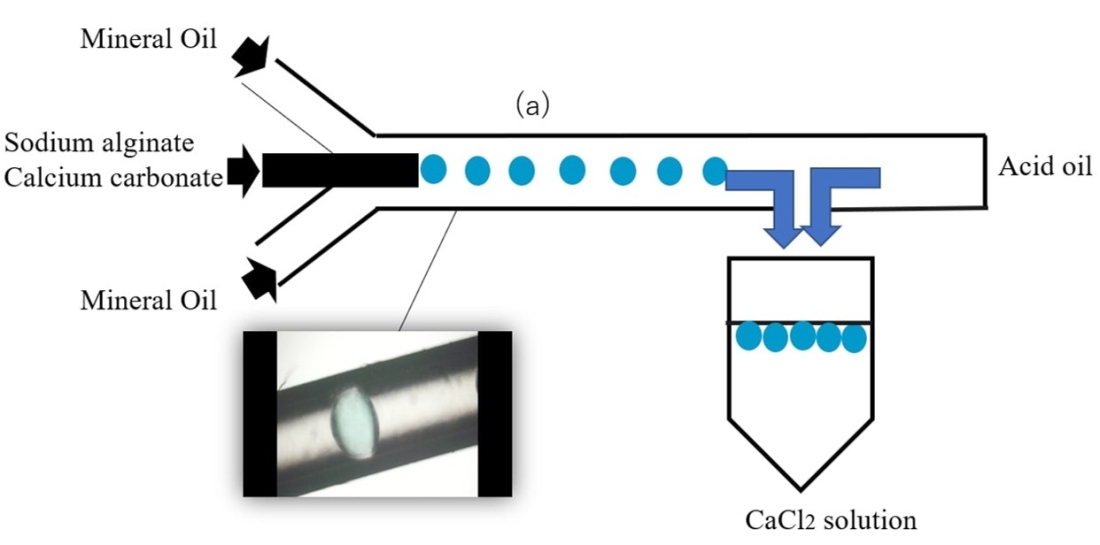
Twelve microorganisms were initially screened for their abilities to catalyze the biotransformation of phloretin. Two main products were identified in LC analysis after 1 hr of whole-cell bioconversion using Streptomyces avermitilis. To analyze the structural change of the product, TMS derivatization using BSTFA was done. After GC/MS analysis, product 1 is found to be hydroxylated in the A-ring of the phloretin with mass increase of 88 (192 to 280) in the A-ring fragment, and also for the whole phloretin molecule (562 to 650). Product 2 is also interpreted to be hydroxylated in the A-ring of the phloretin. But, its fragmentation pattern is different with product 2 with mass increase of 88 (179 to 267) in different A-ring fragment. Maximum conversion was 6.7 %, which was achieved for 1 hours of reaction, and the substrate (phloretin) and reaction product was completely metabolized after 3 hours of whole-cell reaction. Three kinds of Cytochrome P450 inhibitor, Coumarin, Erythromycin and Quinidine was added with 0.5mM final concentration, but, did not prevent the accumulation of the products, which means the reaction proceed not by P450 monoxygenase, possibly by other forms of oxygenase.
The purification and C-phycocyanin from Spirulina platensis was performed by employing the liquid biphasic flotation technique (LBF). LBF is a combination of both the liquid biphasic system (LBS) and solvent sublation, where the partitioning of the biomolecules in the system is enhanced through the effect of bubbling. The influence of various process parameters such as molecular weight of phase forming polymer, phase forming salt, phase composition, system pH, phase volume ratio, air flotation time and crude extract concentration were studied to optimize the C-phycocyanin recovery yield and purity. Desirable conditions for the purification of C-phycocyanin are found in the polymer-salt system consisting of polyethylene glycol (PEG) 4000 and potassium phosphate combination, where the increase in purification fold from 2.43 to 3.49 can be achieved in the optimized LBF. This technique has effectively enhanced the purification of C-phycocyanin in a cost effective and simple processing.
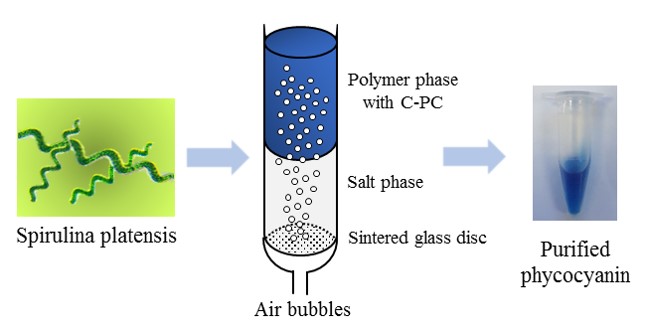
As the mechanisms of biological functions have been successively clarified, synthetic biology has become a feasible approach. One of the goals to synthetic biologists is to reproduce behaviors in the natural systems and ultimately to create artificial life [1]. We have applied synthetic biological approaches to tissue engineering. Three-dimensional (3D) tissue construction from individual cells is an important process in regenerative medicine to enhance cell function. For transplanting tissue-engineered constructs, a limitation of oxygen/nutrient supply due to an insufficient vascular network causes cell death. Thus, it is necessary to develop a system for inducing a vascular network under hypoxic condition to 3D tissue constructs. In our previous study [2], we developed a hypoxia-inducible transgene expression system in which a target gene can be expressed in response to hypoxic stress using hypoxia-responsive promoter RTP801 as a trigger, tTA transactivator as an amplifier, and ODD sequence as a noise canceler. In this study, to improve hypoxia and nutritional limitation inside the genetically engineered 3D tissue constructs, a hypoxia-responsive expression system of vascular endothelial growth factor (VEGF) was introduced into cells. Then we demonstrated that genetically modified cells could control the VEGF expression autonomically in an oxygen concentration dependent manner. Using the genetically modified cells, 3D tissue constructs were fabricated. The tissue constructs were transplanted into mice, and we evaluated the feasibility of the hypoxia-responsive VEGF gene expression system in vivo. The results indicate that the hypoxia-responsive VEGF gene expression system is promising for preparing 3D tissue constructs in regenerative medicine.
[1] S. A. Benner and A. M. Sismour, “SYNTHETIC BIOLOGY,” Nature, 2005, vol. 6, no. 7, pp. 533–543.
[2] Ono A, et al. “Hypoxia-responsive transgene expression system using RTP801 promoter and synthetic transactivator fused with oxygen-dependent degradation domain.” J. Biosci. Bioeng., 2017;124:115-124.
The polymerization of proteins can create active and large bio-macromolecular assemblies that exhibit unique functionalities depending on the properties of protein units in the polymers. Herein, we report the polymerization of proteins and its functions in diagnostic application. We engineered proteins; Escherichia coli alkaline phosphatase (BAP), horseradish peroxidase (HRP), and chimeric antibody-binding proteins (pG2pAs) for conducting the polymerization reaction. The proteins were fused with a tyrosine-containing peptide tag (Y-tag) through a flexible linker at the N- and/or C-termini. The recombinant proteins were then expressed in E. coli or silkworm (Bombyx mori). Trametes sp. laccase (TL) was used to activate the tyrosine residues in the Y-tags with molecular O2 to form a tyrosyl free radical, which initiated the tyrosine coupling reaction between the Y-tagged enzyme units. The proteins without Y-tag were not recognized as substrates by TL even though there are several tyrosine residues in the primary structure of both enzymes. Conversely, the Y-tagged proteins showed sufficient reactivity to conduct TL-catalyzed formation of large and active proteinaceous polymers. Furthermore, the TL also enabled co-polymerization of two Y-tagged proteins; BAPs and a chimeric antibody-binding protein, Y-pG2pA-Y, to form bifunctional proteins. While, the Y-tagged HRPs were also co-polymerized with Y-HRP-pG, a fusion protein of HRP with an antibody-binding protein. In these constructs, enzymes play a role as reporter and other parts are for specific binding with IgG, making them compatible with the enzyme-linked immunosorbent assay (ELISA). The detection limit of the ELISA of ovalbumin (OVA) with anti-OVA IgG depended on the molar ratio of enzyme and pG-conjugated proteins in the TL-catalyzed cross-linking reaction. In general, the higher molar ratio of enzymes, the higher ELISA signal. The present enzymatic polymerization of functional proteins promises to provide highly active protein polymers as diagnostics probes for biomedical applications.
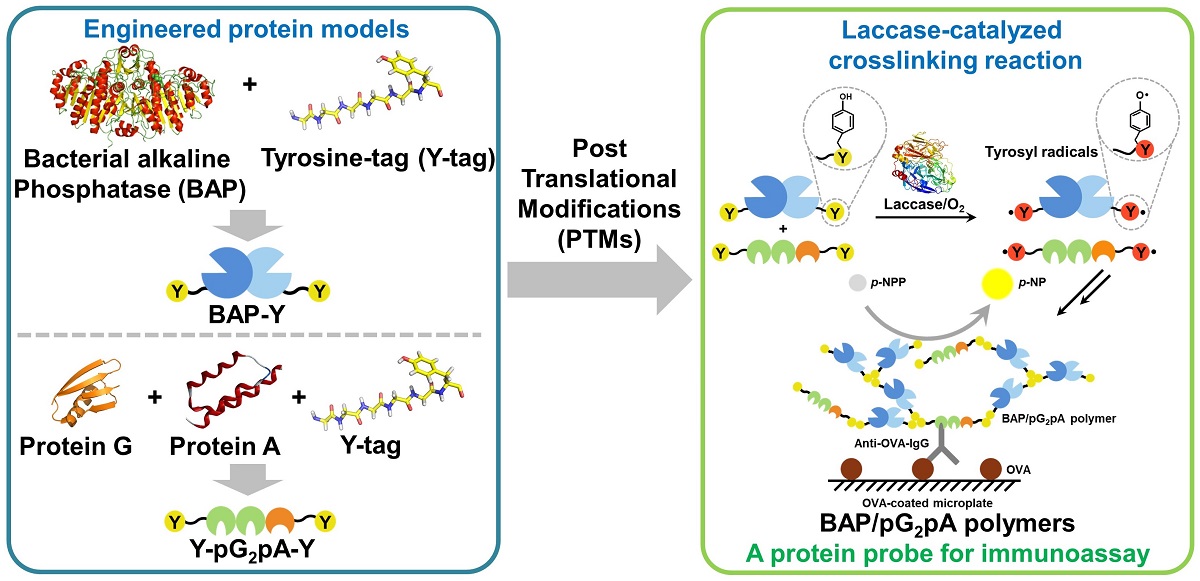
Immobilized metal affinity chromatography (IMAC) has been widely used for the one-step purification of recombinant proteins. In light of its superior selectivity and binding strength, we have previously reported the employment of IMAC adsorbents for the purification and immobilization of enzymes. However, the biocatalysts thus prepared exhibited low operational stability in repeated-batch operations due to the desorption of enzymes. In this study, we report the preparation and applications of loofa sponge-based bifunctional epoxy-IMAC adsorbents for the selective adsorption and covalent immobilization of His-tagged enzymes. Loofa sponge is the fibrous vascular reticulated system of the matured dried fruit of Luffa cylindrical. Its high porosity, structural stability and resistance to cellulose-mediated degradation make loofa sponge an ideal matrix for the development of supermacroporous adsorbent for the purification of recombinant proteins from unclarified cell homogenates. To increase the density of the accessible functional groups for activation, the loofa sponge was grafted with hydroxyethyl cellulose (HEC). The results of equilibrium study showed that upon HEC grafting the adsorption capacity of the loofa sponge-based IMAC adsorbent was increased by 62% from 1.51 mg/g to 2.45 mg/g. By controlling the concentration of iminodiacetic acid (IDA) and reaction time during conjugation, a series of bifunctional epoxy-IMAC adsorbents containing both metal chelating groups for selective adsorption of His-tagged proteins and epoxy groups for covalent immobilization of the adsorbed enzymes were prepared. The difference in kinetics of protein adsorption and covalent immobilization allowed the sequential adsorption and immobilization of the model enzyme, His-tagged trehalose synthase. The immobilized trehalose synthase thus prepared with the bifunctional epoxy-IMAC adsorbents exhibited superior operational stability in repeated-batch operations, retaining 96% of the initial activity after 20 cycles. Furthermore, the superporous structure of loofa sponge allowed the adsorption and immobilization of proteins from unclarified cell homogenate without observable fouling.
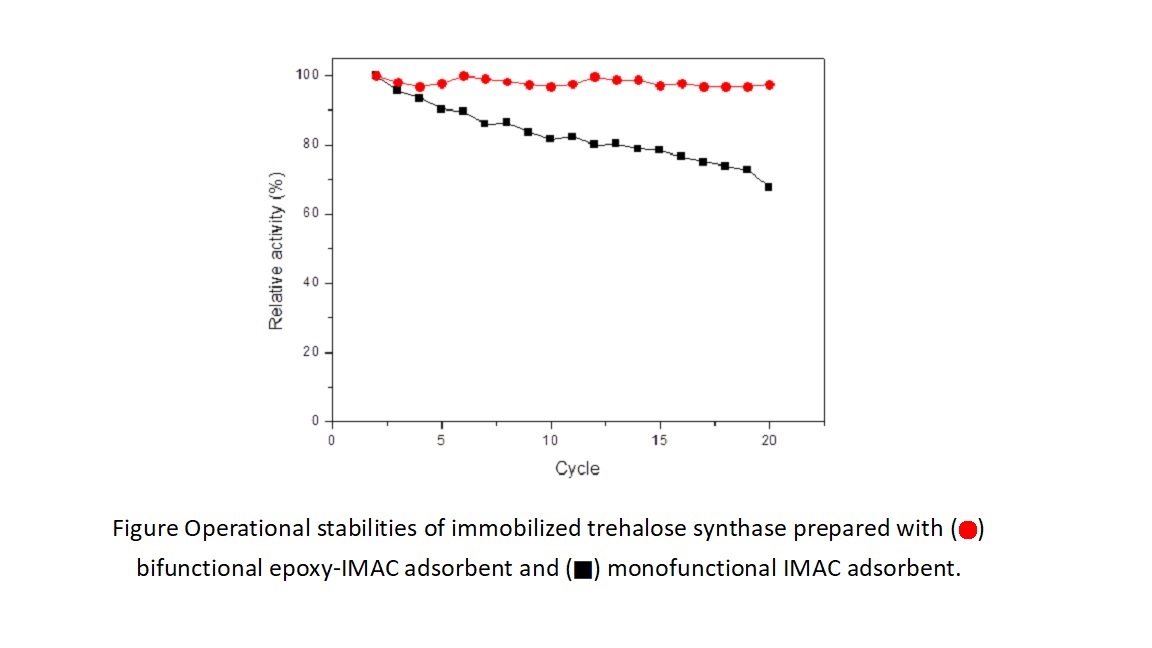
In this study, an immobilized metal ion affinity (IMAM) approach was adopted for coupling cellulases. The mini-scaffolding protein gene (CipA) and the endoglucanase gene (CelA) were constructed via recombinant genetic engineering approach. The immobilized nickel ion IMAM membrane was used to purify and immobilize the CipA from the fermentation broth to make an IMAM-Ni2+/CipA membrane under a 12 h adsorption. The endoglucanase (CelA) with docking domain is used as the model enzyme coupled to the above affinity membrane. The catalytic activity of the immobilized CipA-CelA was clearly higher at a wide range of pH compared to the free CelA. The optimal temperature for the immobilized CipA-CelA was also increased to 70°C. Moreover the immobilized CelA could be reused 4 times with 70% of residual activity. To check the metal ion effect during the construction of IMAM, some metal ions, like iron, cobalt and copper ions would enhance the enzyme activity; however, casium and znic ions would suppress the enzyme activity. Effect of metal ions addition on the enzyme activity immobilized in IMAM is lower than that of free enzyme.
Elaeocarpus serratus L. (Ceylon-olive) leaves are the by-products in the harvest or agricultural processing of Ceylon-olive fruits, containing many high-value bio-phenols and flavonoids with anti-oxidation activity, and are valued to enhance the nutrition for humans. The purpose of this study is to investigate the effect of non-thermal ultrasound and solvent on the extraction of Ceylon-olive leaves. The fresh Ceylon-olive leaves were thoroughly cleaned, freeze-dried, defatted and ground to get raw biomass powder. The extraction efficiency was explored by using various solvents (methanol, ethanol and water) without or with ultrasound at different operation modes to extract the bioactive compounds from Ceylon-olive leaves. The main compounds of bioactive extract were determined by high performance liquid chromatography. The characteristic structure of Ceylon-olive leaves before and after extraction, including morphological structure, functional groups and crystallinity, was analyzed by using field emission scanning electron microscope, Fourier transform infrared spectroscopy, and high resolution X-ray diffractometer. Using methanol as the solvent, the total phenolic and total flavonoid contents of the Ceylon-olive leaves extract with ultrasonic extraction were 1.45 times of those without ultrasound, and myricetin and myricitrin contents with ultrasound-assisted extraction were 1.57 and 1.38 times of that without ultrasound, respectively. When using aqueous ethanol, the contents of total phenolic compounds, total flavonoids, myricetin and myricitrin were all enhanced by the increase of ethanol concentration under ultrasound. The crystallinity of Ceylon-olive leaves after various extractions showed about 21.83% to 44.13% increase, compared to that before extraction, and the morphological structures of Ceylon-olive leaves were observed to be seriously crumbled and punched by ultrasonic extraction, leading to the enhancement of bioactive compounds transported. In this study, the strategic ultrasound and appropriate solvent demonstrated the significant effect on the promotion of extraction efficiency for Ceylon-olive leaves.
Keywords: Ceylon-olive leaf, ultrasound, bioactive compounds, extraction
Phyllostachys makinoi (Makino bamboo), the endemic species of Taiwan, are natural materials with potential bioactivity beneficial to human health. In this study, the objective is to develop the green processing method for the extraction of bioactive compounds from Makino bamboo (RB) via ultrasonic pretreatment. Two different solvents (ethanol and water) were used in extraction of Makino bamboo with or without ultrasonic pretreatment (40 kHz, 60°C, 3 h), and the crystallinity were examined by the high resolution X-ray diffractometer. From the observation by field emission scanning electron microscope, the microstructure of Makino bamboo was seriously crumbled and cracked via ultrasonic pretreatment before the extraction, leading to the enhancement of extraction efficiency. Using water as the solvent, the yields of the extract after ultrasonic pretreatment and without ultrasonic pretreatment were 3.98% and 3.56%, respectively, showing that ultrasonic pretreatment would give the extract yield enhanced to 1.12 times of that without ultrasound. Besides, the total phenolic content with ultrasonic pretreatment was 1.08 times of that without ultrasound. Under ultrasonic irradiation, the antioxidant capacity and total flavonoid content of the Makino bamboo extract by using water were 1.91 and 1.40 times of that using 95% ethanol, respectively. The diffraction peaks for Makino bamboo in various extraction conditions within the 2 theta range of 15-25 °were much sharper than those for RB, and the crystallinity index of RB was 47.21%; the crystallinity of Makino bamboo after extraction showed about 3.47% to 7.99% increase, compared to that before extraction (RB). The efficient method by ultrasonic pretreatment to assist the extraction of Makino bamboo has been explored, and ultrasound can be regarded as an effective, mild and non-toxic technology to extract bioactive compounds for the valorization of Makino bamboo.
Keywords: Makino bamboo, ultrasound, pretreatment, extraction
Polyacrylonitrile (PAN) nanofibrous membrane was prepared by electrospinning technique. The PAN membrane used in this work comprises a polyethylene terephthalate (PET) spunbond fabric as a supporting layer with upper and lower PAN nanofibrous membrane. After 3 M NaOH and diluted HCl treatments, the weak cationic exchange membrane (i.e., AEA-COOH) was obtained. The AEA-COOH membrane was then functionalized with ethylenediamine (EDA) and bromoacetic acid (BrA), sequentially. This modified ion exchange membrane (namely AEA-BrA) has more acidic groups as compared to the AEA-COOH membrane. In this study, lysozyme obtained from chicken egg white (CEW) was chosen as a model enzyme. The adsorption characteristics of the AEA-BrA membrane were assessed by measurements of the breakthrough curves in membrane chromatography. The influences of adsorption pH, CEW concentration, and liquid flow rate on adsorption performance of the membrane were investigated in an AKTA prime chromatographic system (GE Healthcare). On the basis of the results, the optimal conditions for the capture of lysozyme were carried out in 10% (v/v) CEW at pH 9 and flow rate of 0.1 mL/min for the ion exchange membrane process. Moreover, the two-step elution scheme (0.6 M and 1.0 M NaCl, pH 9) was chosen for eluting the adsorbed lysozyme. The lysozyme fraction eluted by second step 1.0 M NaCl was recovered with purification factor of 402 and yield of 91% in AEA-BrA ion exchange membrane chromatography.
Polyacrylonitrile nanofiber membranes (PAN) were fabricated via electrospinning technique. The PAN membrane comprises a polyethylene terephthalate (PET) spunbond fabric as a supporting layer with upper and lower PAN nanofibrous membrane. After NaOH and HCl treatment procedures, the modified membrane is a weak ion exchange membrane (namely AEA-COOH). The AEA-COOH membrane was characterized in terms of fiber diameter, porosity, specific area, pore size, ionic density, and binding capacity. In this study, lysozyme was chosen as a model protein. The adsorption efficiency of the AEA-COOH ion exchange membrane for lysozyme was assessed by the measurements of breakthrough curves in a small stirred cell system (Model Millipore 8010). The capture of lysozyme from diluted chicken egg white (CEW) was carried out with a working volume of 10 mL under the different feed concentrations, flow rates, rotating speeds, and operating pressures. The optimal adsorption conditions were found to be adsorption pH 9, 1 in 10 dilution of CEW, average flow rate of 0.1 mL/min, rotating speed of 200 rpm, and initial operating pressure of 0 psi). Furthermore, the elution of lysozyme was also investigated in stirred cell experiments. It was successful in achieving purification of lysozyme in a high yield of 98.2% with a purification factor of 62.9 in a single step.
Heat-sensitive materials (food, pharmaceutical etc.) have to be dried at low temperature. Drying method of such materials is often demanded the maintenance of shape (porous product), color and high rehydration rate. Freeze drying satisfies above demands, but it has some problems like necessity of extremely low pressure, non-uniform heating (conductive or radiant heating) and long drying time.
Some problems of the freeze drying are considered to be solved by our method. Figure 1 shows the outline of experimental apparatus in our study. The frozen materials are put in the vacuum chamber. In the vacuum chamber, air with low temperature (about 273 K) and low humidity circulates under the reduced pressure. Frozen materials are heated by the convective heating due to circulating air. The drying progresses with the sublimation in materials. The sublimation occurs at the relatively high pressure (10 kPa in our study).
The drying characteristics of frozen materials (carrot and brick plate) for our drying method were studied experimentally and theoretically. The changes in temperature and moisture content of material during drying were measured in the experiment. The properties (color, volume and rehydration characteristic) of material (carrot) after drying were examined. Equations of heat and mass transfers were used for the numerical analysis. The effects of operational conditions on the drying characteristics of frozen material (brick plate) were examined by using the numerical analysis.
Sublimation rate on the material surface is much higher than that in the inner part, i.e., the present drying method is suitable for small or thin material. The changes in volume and color during drying are smaller than those in our previous study (fluidized bed drying of frozen carrot under reduced pressure, at 333 K and 12 kPa). The humidity and temperature of circulating air largely affects the drying rate.
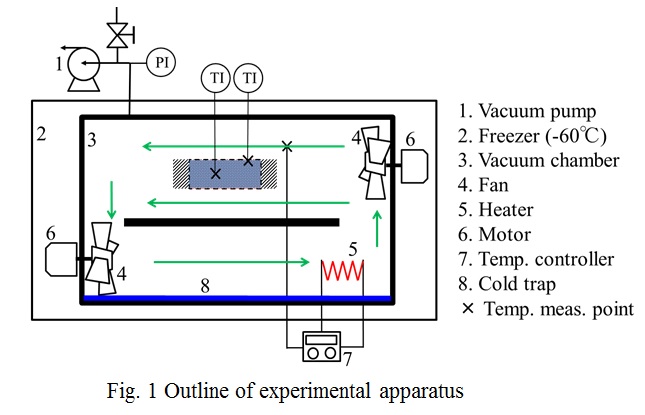
β-Cryptoxanthin (BCX) is contained in citrus fruits such as Wenzhou orange and is expected to have various functions such as osteoporosis prevention, diabetes improvement, cancer prevention by immune improvement, and skin care effect. As BCX cannot be synthesized in human body, it must be taken from food. However, BCX is very hydrophobic and the absorption rate in oral administration should be low. In the present study, bioaccessibility of BCX after complexation with sodium caseinate was assessed using the Caco-2 cell model. BCX was recovered from a citrus fruit kumquat (Fortunella spp.) cultivated in Miyazaki by extraction using a mixture of ethanol and pyrogallol. The extracted BCX was complexed with casein by mixing an ethanol solution of BCX and an aqueous solution of sodium caseinate, followed by evaporation of ethanol in vacuo and lyophilization. For cell permeability test, Caco-2 cell was cultured onto 6-well plates for 3 weeks to prepare the cell monolayers. After pseudo-digestion by enzymatic hydrolysis using pepsin in acidic media followed by that using pancreatin in neutral media, the complex between BCX and casein or the blank sample without containing casein was injected to apical side of the cell monolayers. After incubation for 8-24 h, the concentration of BCX in basolateral side was analyzed to determine the cell-permeability of BCX. The permeability of BCX for the blank sample was negligible. In contrast, BCX complexed with casein was efficiently permeated the Caco-2 cell monolayer. The result suggests that complexation with casein would enhance the bioaccessibility of BCX.
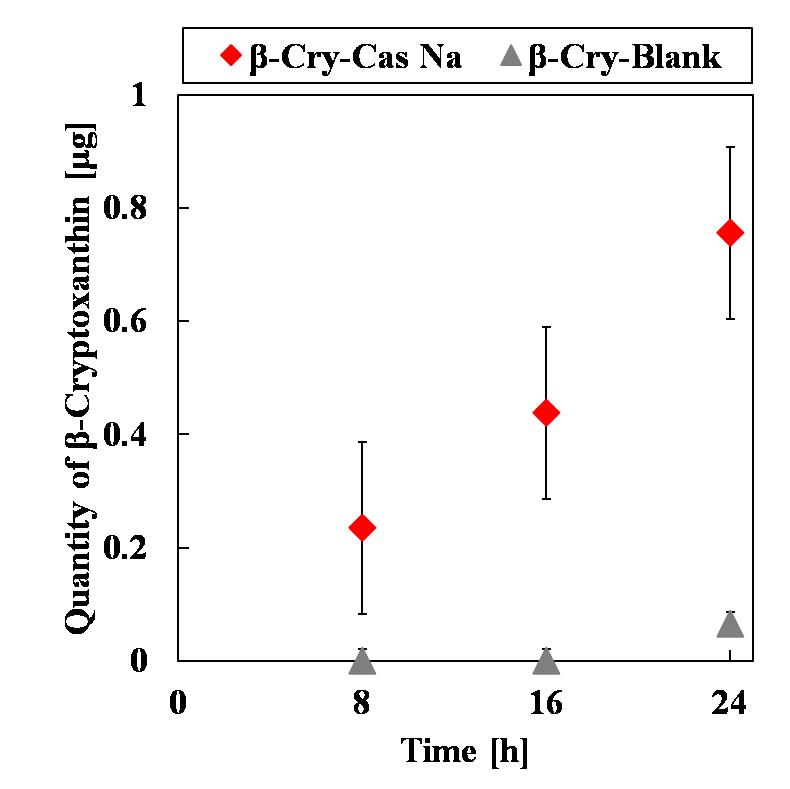
It is not necessary to use preservatives and colorants, since frozen storage has good shelf life and quality retention. Frozen shrimp products are usually distributed in the form of frozen ice blocks. Ice-blocked shrimp cannot be removed intact unless ice is completely melted. When thawing time is getting longer, freshness of shrimp will rapidly decrease. Shortening of thawing time is required to maintain freshness and texture. In this study, we examined a new processing method to crush and separate ice on the surface of ice-blocked shrimp.
Cylindrical pure water ice and saline water ice (20%) were used as glazed-ice samples. Cylindrical fish sausage and minced shrimp were used as food samples. Compression test and split test were performed at each test temperature (-20°C~-70°C) by using material tester. The results showed that breaking stress of pure water ice and saline water ice is always smaller than fish sausage and minced shrimp at each test temperature. Predicted that pure water ice and saline water ice are destroyed preferentially over fish sausage and minced shrimp.
Four types of model ice glazed food were prepared by subjecting fish sausage (with and without packaging film) to ice glaze treatment of pure water or saline water. Split test was performed with constraint condition (fish sausage without packaging film) or unconstraint condition (fish sausage with packaging film) at each test temperature (-20°C~-70°C). The result support previous prediction and indicates crushing saline water ice glaze was easier than pure water ice glaze at same temperature. It becomes possible to maintain their original flavor and nutrition. It also have advantage for cost reduction. It is considered that the saline water ice is easy to melt and break, so it is suitable for separating the ice glaze of complex shaped foods.
Abstract
The blanching is carried out with 90 to 100°C. hot water and uses a large amount of water in order to suppress the color tone, texture change and bacterial growth of vegetables. The tissue is seen to be transparent and soft. By blanching whole vegetables in a short time at high temperature with microwaves, the amount of water used decreases, and physical properties, the number of bacteria, etc. can be improved.
A fiber optic thermometer is placed at the center and at the end of the cabbage, and when the center temperature reaches 100°C, it is taken out, water-cooled and shredded and stored at 5°C and 15°C. I checked. As a comparison, what was immersed in 100°C hot water for 0 second, and was water-cooled was used. The color was determined by removing chlorophyll from cabbage, powdering and measuring Hunter color difference ⊿E. Texture investigated the maximum breaking strength of the cabbage leaf vein with the creep mete.
As a result, it was found that microwave blanching is superior to hot water in terms of color tone and texture, and the number of bacteria is equal
There was no change in oxygen concentration and ethylene concentration in both microwave and hot water blanching, and it was presumed that the enzyme was inactivated although it was indirect
The lettuce changes its color from green to white to black upon heating. The launching temperature is 50°C. for both microwave and hot water. It is presumed that this is because milky white lactucanium contained in cabbage is eluted at around 50°C. and oxidized at a higher temperature. Lettuce blanching is very difficult.
Protein aggregates can be modified by freezing and aging process. In this research, sodium caseinate suspensions (1%) were adjusted to different pH (5.5 and 8.0) and salt concentrations (0.01 and 0.1 M NaCl), followed by being frozen at –35 °C for 1 hour, 2 days or 5 days. After thawing, samples were analyzed by a tunable resistive pulse sensing (TRPS) particle analyzer. According to the results, particle diameter decreased after being frozen for 1 hour and increased after being frozen for days. While particle concentration increased after the 1-hour freezing treatment and decreased after days of freezing. It was found that the change of particle diameter and particle concentration in the 1st hour can be strengthened by repeating the freeze-thaw cycle. The changes of particle diameter and particle concentration were also related to pH and salt concentration of the sample. Particle surface characteristics were also found being related to freezing process, pH and salt concentration. In addition, the difference in freezing temperatures (–5 °C, –20 °C and –35 °C) did not strongly influence the change of particle properties during freezing process. Based on the results, freezing processing is a potential technique to control the properties of sodium caseinate suspensions.
The main component of alcoholic beverages is ethanol, and they form the complex aroma and taste by adding the other ingredients. We have been tried to apply the infrared spectroscopy, which could grasp the information of the quantitative multiple components and the interactions between the molecules, to the evaluation the aroma and taste related information. However, the alcoholic beverages are usually drunk at different temperatures. This study then aims to experimentally understand the influence of the ethanol concentration in the aqueous solution and the temperature on the infrared spectroscopic characteristics.
Ethanol aqueous solutions (12 to 22 vol%) were used as the simplest alcoholic beverage model. A Fourier transform infrared spectrometer equipped with a high-pressure gas cell was used for spectrum measurement of the gas phase. The gas over the sample was circulated from the sample compartment to the gas cell using a pump. The absorption spectra were continuously collected at 290 to 303 K.
The absorption peak intensities corresponding to the vibration modes of ethanol molecule around 1067, 1395, 2901 and 2988 cm-1 continuously became higher until the equilibrium state. At such absorption peaks, the linearity was observed between the natural logarithm of the absorption at equilibrium state and the reciprocal of the absolute temperature of the sample, and the influence of the ethanol concentration on the slope value was negligible. In addition, for the Arrhenius plot using the rate constant obtained under the assumption that the kinetic volatile behavior of ethanol could be expressed by the first order reaction equation, the slope values could be constant among the samples used in this study. These results suggested that the influences of the ethanol concentration in the aqueous solution and the temperature on the kinetic volatile behavior of ethanol could be grasped based on the infrared spectroscopic information.
Boiled red beans (azuki beans) called as "Niazuki" is very popular in Japan. After dipping the beans in water at the room temperature, the beans are boiled. Usually, the dipping water is once disposed in order to decrease the astringent ingredients in boiled red beans, and this operation called as "Shibukiri". However, the drained water contains not only astringent ingredients but also the functional ones. The heating method without "Shibukiri" operation has been then proposed empirically, and the scientific and objective method for the quality evaluation through the "Niazuki" production process is desirable. The aim of this study is to grasp the quality change behavior of the boiled red beans during the heating process using an infrared spectroscopic method, which could be based on the information of vibrational modes between molecular compounds and be simple, rapid, non-chemical and non-destructive.
Firstly, we constructed the stable and quantitative infrared spectroscopy measurement method of the cross section of the boiled red beans using a Fourier transform infrared spectrometer equipped with an attenuated total reflection accessory. Additionally, by comparing the spectral feature changes of the cross section of the red beans during heating with those of the boiled soups, the spectral feature changes of the red beans during heating were experimentally suggested to be quantitatively evaluated based on the soup spectral information that could be easily collected during the heating operation. Moreover, the infrared spectral absorption bands relating to the astringent ingredients in the soup could be extracted by performing the sensory evaluation test. Consequently, this study could be a very important step in the developments of the infrared spectroscopic monitoring for the control of the heating process of the "Niazuki" production.
1-Methylcyclopropene (1-MCP) is known as ethylene inhibitor agent that effective to delay ripening rate in fruits. Controlled release packaging with 1-MCP as active compound is an alternative method to extend the shelf life of fruits. Currently, 1-MCP coated paper has been investigated to develop the functional packaging for fruits. Therefore, this research is aimed to investigate the effectiveness 1-MCP coated paper during preservation of apple.
The formation of 1-MCP coated paper was done by dissolving a weight of 1-MCP inclusion complexes (1-MCP ICs) powder into 0.5 mL of shellac solution. The effectiveness of 1-MCP coated paper were examined in the apple fruits with different weight of 1-MCP ICs powder: 5, 10, 30 and 50 mg for over 30 days. All EPS were closed and stored at 4 °C for initial 15 days. Thereafter, apples were transferred to 20 °C storage temperature for another 15 days. After this treatment, the apples were stored at 20 °C for another 15 days to evaluate shelf life of apple and were also measured the physicochemical properties.
The results showed that apples treated with 1-MCP coated paper inhibited the increase in ethylene production rate during storage time compared to control. During storage time at 4 °C, the release of ethylene from apples with treatment of 1-MCP coated paper were less than the control apples. Low ethylene production rate of 0.22 nL/g FW/h could be observed at 50 mg of 1-MCP ICs powder. On the other hand, for the control apples without treatment of 1-MCP coated paper, the ethylene production rate was 44.7 nL/g FW/h. The finding results indicated that 1-MCP coated paper with 50 mg of inclusion complex was effective to delay the ripening rate and maintain the quality of apple during storage time.
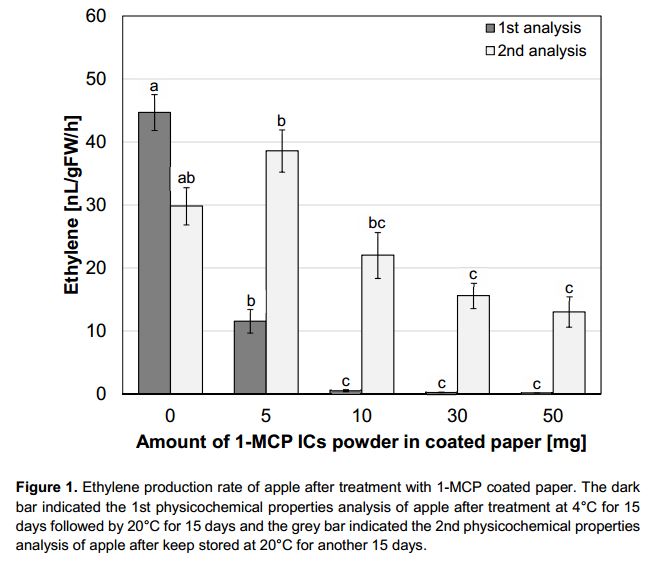
Sweet potato has individual differences in property such as shape, starch content, amount of enzyme. When baked using household cooking tools, the taste differs depending on the individual property even under the identical cooking condition. This study aims at predicting suitable cooking condition of sweet potato for maximizing on the maltose production by the enzymatic reaction during cooking process. The sweetness of sweet potato mainly contributed by maltose. Starch contained in sweet potato is gelatinized by heating, and maltose is generated by the hydrolysis of the gelatinized starch by β-amylase. Gelatinization is accelerated by heating, whereas β-amylase is inactivated by heat. Therefore, heating condition must be optimized in order to maximize resultant amount of maltose. First, in order to investigate the gelatinization kinetics under non-isothermal condition, the degree of gelatinization was measured under selected heating rate. A diagram of the gelatinization rate as a function of temperature and gelatinization degree was prepared to predict the gelatinization behavior of sweet potato at selected cooking condition. Second, the inactivation kinetics of β-amylase was separately measured after extracting the enzyme from a sweet potato. The measurement was carried out under isothermal condition at selected temperatures. The obtained results can predict the remaining enzymatic activity throughout cooking process. Finally, the heat transfer in sweet potato under oven cooking was calculated by the finite element method by counting heat balance between the heat received by the sweet potato from the oven and the heat used to evaporate on the sweet potato surface. Based on the simulated temperature profiles, the amount of maltose produced as a result of baking was predicted. This simulation could be useful to optimize a cooking condition that controls the amount of targeted components.
Freeze-drying is known as one of the best drying method for maintaining original product qualities. Each product has a particular operational temperature limit known as collapse temperature. When temperature of in-drying product reaches over collapse temperature, structural collapse occurs and it may lead quality loss of products. However, some extent of collapse is more or less accepted in industry if it does not lead serious quality defect. In this study, model freeze-dried food products were prepared and influence of the degree of collapse during freeze-drying on quality of products was examined. Samples with different collapse temperatures were obtained by changing the amount of sodium chloride. Collapse temperature was defined as a point at which the significant electrical conductivity change was observed in the temperature ramp test from -60°C to 10°C. A linear correlation was confirmed between collapse temperature and the degree of collapse that was evaluated by alternative test (i.e. the tapping test) on a prepared sample freeze-dried at fixed drying condition. Prepared samples confirmed flavor components, that is methionol and hexanoic acid. The amount of flavor components before and after freeze-drying was measured by gas chromatography. It found that the collapse temperature was clearly correlated with the retention of methionol. On the other hand, the retention of hexanoic acid did not obviously change depending on the collapse temperature. This result indicated that the degree of collapse affects the retention of some flavor components. The present study clarifies a rational choice in better freeze-drying conditions that realize product quality at desired level.
Potato pulp is an agricultural waste containing large amount of arabinogalactan. The compound is known to behave as prebiotics which modify the gut microbiota as nutrients to support the growth of lactic acid bacteria such as the genus Lactobacillus and Bifidobacterium. Potato-pulp-arabinogalactan "PPA" have not used as probiotics commercially. The development of a cost-effective PPA extraction is promise for the industrial application. In this study, the effect of the extracting procedures were investigated on the growth of gut-microflora by in vitro experiments. Crude saccharides "CS" were prepared by 50 g dried potato pulp suspended in 1 L of pure water. The suspensions were autoclaved at 121°C for 2 h, and filtered by a filter paper. The filtrate were concentrated around 1/4 by a rotary evaporator, and aggregated by 4 × volume of ethanol. Dialyzed saccharides (DS) were prepared to dialyzed CS by a dialysis membrane (cut off MW < 10,000). Enzyme-treated saccharides (ES) were prepared to digest CS by a crude amylase, Gruku-Gin (Amano Enzyme) and dialyzed. All saccharides were lyophilized or heat-dried to store. According to size-exclusion chromatography, the molecular distribution of CS were between 400 and 200,000. A peak of oligosaccharides was observed around MW 800. The peak were disappeared in charts of DS and ES. Based on the saccharide composition profiling after acid hydrolysis, glucan were occupied 50% in the total amount of glycan in CS and DS, and decreased to approx. 5% in ES. When thirteen strains of gut microbes were cultivated in GAM broth including the saccharides instead of glucose, CP and EP selectively stimulated several non-pathogenic strains in the genus Bifidobacterium and Clostridium, but not pathogenic Enterobacteriaceae. From the results, PPA would behaved as prebiotics without dependence of the extracting procedures, and can be extract by further simple processes.
Introduction
There is currently great interest in the study of compounds from food sources with biological activities, as these compounds are generally considered highly safe. In particular, polyphenols are thought to have various health benefits and are found in many health foods, as well as in vegetables and fruits. However, the structure-activity relationships (SARs) of polyphenols are not well understood, because they are typically obtained as a mixture of various analogs, which makes purification difficult.
"Tannin" is a mixture extracted from plants and contains a large amount of water-soluble polyphenols that is used in the plant “tanning” process of converting animal skin to leather, which relies on the polyphenol–collagen protein interaction in the skin. We have previously confirmed that polyphenol compounds having a galloyl group and high radical scavenging activity interact more strongly with gelatin (the material obtained after the acid or basic hydrolysis of collagen). Therefore, it was thought that it could be possible to predict the functionality of the polyphenol compound present in the mixture by confirming whether or not it binds to gelatin.
Results and discussion
Green tea leaves and raspberries were selected as plants containing polyphenol compounds. Green tea leaves are rich in polyphenol compounds such as tea catechin, (–)-epigallocatechin-3-O-gallate (EGCG) (1). Raspberry also contains many kinds of polyphenol compounds such as condensed tannin and hydrolyzable tannin in addition to (+)-catechin (2), (–)-epicatechin (3). Green tea leaves and raspberries were each extracted with methanol to prepare a polyphenol crude extract. The compounds bound when gelatin was added to these extracts were a group of compounds that tended to have high radical scavenging activity. It was suggested that functionality such as radical scavenging activity can be predicted by confirming whether it is strongly bound to gelatin.
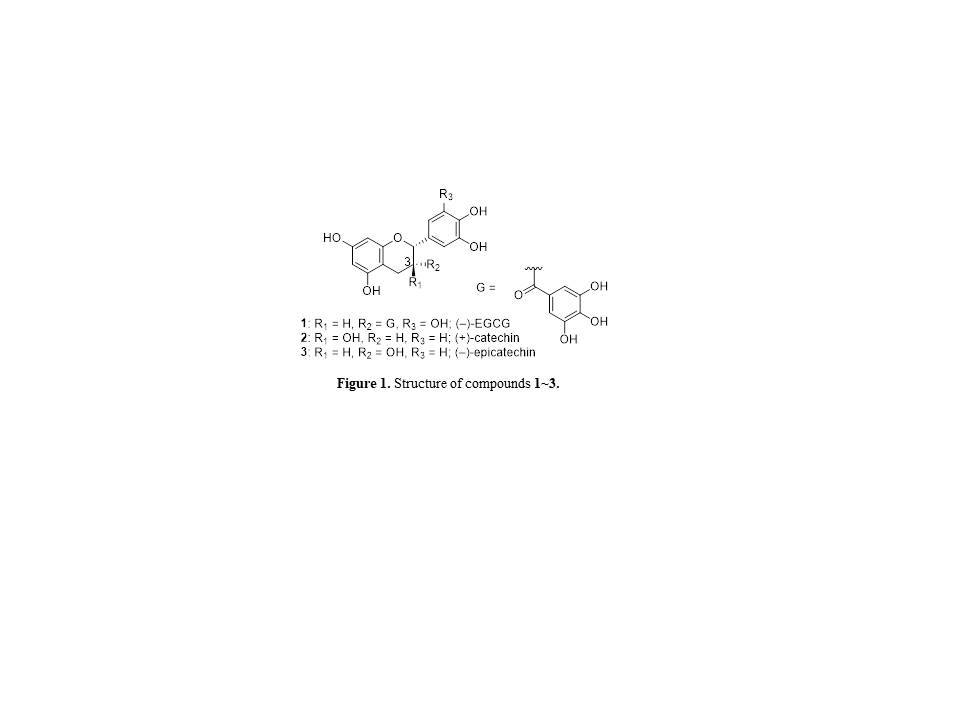
Ion channels are important membrane proteins that allow ions to pass through the channel pore for cell function regulation. Their protein functions include establishing the control of electric potentials accompanying with the ligand binding to the channel and the opening/closing the pore. Currently, while the expansion of ion channel measurement demands for cell function evaluation and regulation, the intact membrane fabrication on conductive substrate, especially for the cytoplasmic face analysis, is still challenging.
In this study, we investigated the design of peptide interface between cell membrane and highly oriented pyrolytic graphite (HOPG) substrate. By using the bifunctional peptides capable of substrate binding and strong cell membrane binding, immobilization of cell membrane attaching onto substrate after osmotic shock was evaluated.
In order to screen cell membrane strong binding peptides, we designed peptide array that allow multi-peptides synthesis on a cellulose membrane and binding assay with NIH-3T3 cells was conducted. Screened candidate peptide was fused with HOPG binding peptide and evaluated the bi-functionality expression using chemically synthesized peptide. After the surface modification of HOPG with peptide candidates, cultured NIH-3T3 cell was sowed and cultured. Prior to the cell disruption, cell membrane was stained by Cell mask orange and the cell culture surface was soaked in cold MilliQ for osmotic shock. The cell membrane structure was observed with fluorescent microscope.
Herein, we show that bi-functional peptides screened using peptide array are suitable interface enabling surface functionalization just by dropping peptide solution on the graphite. The peptide interface revealed some superior properties for cell culturing and for stable immobilization of cell membrane attaching onto substrate even after the cell disruption process. The developed peptide-based interfaces on HOPG substrate open the door for new biosensor developments for ion channel activity evaluation from the stimuli by intracellular ligand molecules.
n-3 Fatty acids such as eicosapentaenoic acid (EPA) and docosahexaenoic acid (DHA) have been associated with cardiovascular function and other diseases. However, EPA and DHA are easily prone to oxidation due to many double bonds. This study focused on the oxidation stability of EPA and DHA encapsulated with maltodextrin by spray drying. Krill oil was emulsified with saponin and sodium caseinate emulsifiers by mechanical and high-pressure methods and then the emulsion was spray dried in an Ohkawara L-8 spray dryer to produced powders. The oil droplet size after the spray drying was measured as well as the amount of surface oil, the oxidation stability and the retention of the EPA and DHA after storage at 25, 50 or 70 °C for 1, 2 and 4 weeks. The results showed that the amount of surface oil and oil-droplet size affected the oxidation stability of krill oil in spray-dried powders. Krill oil of small oil droplet size was more stable than that of large one.
Keywords:
DHA, EPA, Krill oil, Oxidation stability, Powder, Spray dryer
1. Introduction
Recent advancement of genome-editing technology allows the site-specific integration of gene of interest (GOI). The information of genomic loci that support high level expression of GOI, in combination with such genome-editing technology, will be useful to rapidly establish good CHO cell lines suitable for the production of biopharmaceuticals. In this study, we aimed to screen the DNA regions that strongly express transgenes.
2. Methods
CHO-K1 cells were obtained from Riken Cell Bank and maintained in F12 medium supplemented with 10% fetal calf serum and antibiotics. HIV- or mouse stem cell virus-based vectors that expressed eGFP under the control of CMV promoter were produced. CHO cells were infected with the vectors in low multiplicity of infection to prevent multiple integrations. Cells with strong fluorescence intensity were sorted by flowcytometer and expanded for further analysis. Integration sites were determined by inverse-PCR. To integrate model antibody expression unit, reverse reaction of Cre recombinase on mutated lox P sequence or CRISPR/Cas9 integration was performed.
3. Results and discussion
Several integration sites were determined for the clones with high/low expression. The integration sites of lentivirus vectors are not completely random (preferences: transcribed region). Chromosome immunoprecipitation analysis of parental CHO cells suggested that some histone modification was higher in integration sites of high-expressing clones, suggesting that genomic loci that support high level expression of GOI were partly related to specific epigenetic status. The expression of model antibody was higher in higher eGFP-expressing locus.
This research is partially supported by the developing key technologies for discovering and manufacturing pharmaceuticals used for next-generation treatments and diagnoses both from the Ministry of Economy, Trade and Industry, Japan (METI) and from Japan Agency for Medical Research and Development (AMED).
Meropenem is an antibacterial drug used as a final-line against multidrug-resistant bacterial infections. In general, overdose of antibacterials damages kidney, but underdose allows creation of the resistant bacteria. Thus, therapeutic drug monitoring (TDM) of antibacterials are strongly required. Development of TDM of meropenem is urgent because there is no effective therapeutic method against infection of meropenem-resistant bacteria. Thus, we are developing a real-time meropenem sensor using molecularly imprinted polymer (MIP). A MIP is synthetic polymer whose matrix is imprinted with structure of the target molecule during the synthesis process. Copolymer of methacrylic acid (functional monomer) and N,N-methylenebisacrylamide (MBAA: crosslinking monomer) imprinted with meropenem was grafted on the surface of graphite particles. The particles ware mixed with silicone oil to prepare a carbon paste electrode for sensing meropenem. Cyclic voltammetry of 5 mM potassium ferrocyanide was performed with the electrode. Fig. (A) shows the correlation between the current and the concentration of meropenem or imipenem which is the analogue of meropenem. Both of the currents depended on meropenem and imipenem with the similar sensitivity We thought that the poor selectivity was due to the high hydrophilicity and flexibility of MBAA. Therefore, ethylene glycol dimethacrylate (EDMA), which is more hydrophobic crosslinker, and MBAA were blended (molar ratio of 1:1) to prepare a new MIP carbon paste electrode, and the same experiment was performed. As shown in Fig. (B), the current at this electrode was approximately twice as sensitive to meropenem as to imipenem. Therefore, more rigid MIP of the electrode, may detect meropenem without interaction in blood and will enable the TDM of meropenem.
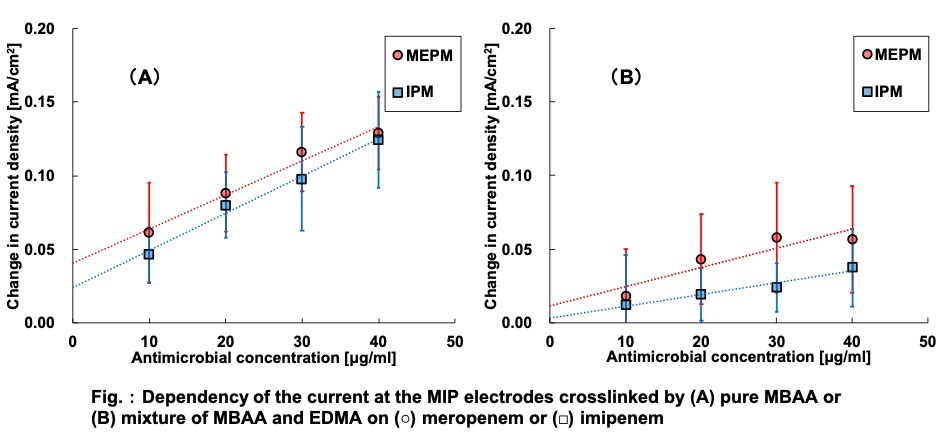
We believe they are many broad candidates available in nature, which can move beyond difficulties to out boundary so that the good platform for fermentation of lignocellulosic biomass could be built without too much genetic modification. However, it is not easy to achieve the candidates due to the unique adaptation possessed by many yeasts upon the environmental stress.
In this study, we have developed the simultaneous method for screening the candidate yeasts, which capable to grow and ferment lignocellulosic lysate into ethanol and fine chemicals such as lactate. By using culture collection in National Bio-resource Collection (NBRC) Japan, and Indonesian National Culture Collection (InaCC), the screening of the yeast strain, having a potential of growing and fermentation in the medium containing fermentation inhibitors, was conducted. Regarding the possibility of bio-resources in Asian for bio-refinery, we would like to discuss also in this presentation.